VOLUME
ISSUE 08
Erase
Three perspectives anchor the will to erase.
These three perspectives form the basis on which one can help ascertain the current station of contemporary society. Looking through the prism of art, politics, power, technology, spirit, and reality-visual culture and ideas, can the notion to easily erase or delete be seen to relativise our understanding of truths today? Moreover, the will to delete is an integral part of digital socialisation today as such it affords the emergence of new cultural myths and forms. How do these manifest in contemporary art and visual culture?
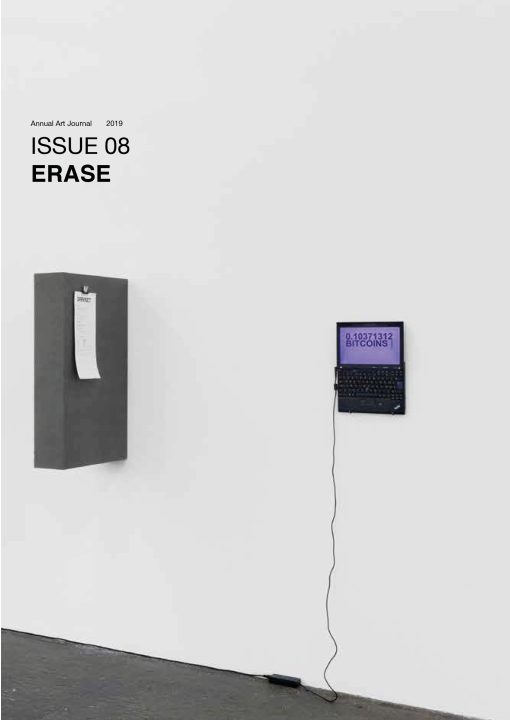
ISSUE 08
2019
Erase
ISSN : 23154802
Introduction
Essays
Conversation
Exhibition
Contributors’ Bios
Introduction
Introduction: Erase
Essays
ERASURES: Being, Seen
The Fact Remains
Conversation
Exhibition
Disintegration Loops An Exhibition in Print
Contributors’ Bios
Contributors’ Bios
Introduction
Editor
Venka Purushothaman
Associate Editor
Susie Wong
Copy Editor
Jean Wong
Advisor
Milenko Prvački
Editorial Board
Professor Patrick Flores, University of the Philippines
Dr. Peter Hill, Artist and Adjunct Professor, RMIT University, Melbourne
Professor Janis Jeffries, Goldsmiths, University of London
Dr. Charles Merewether, Art Historian, Independent Researcher, Curator and Scholar
Manager
Sureni Salgadoe
Contributors
Jorella Andrews
Dejan Grba
Charles Merewether
Nils Plath
Sam I-shan
Clare Veal
Ian Woo
Andrea Luka Zimmerman
The Editors and Editorial Board thank all reviewers for their thoughtful and helpful comments and feedback to the contributors.
Introduction
Introduction: Erase
The 2019 issue is Erase.
The concept of ‘erase’ has informed much of 20th-century art, philosophy and cultures through either a palimpsestic re-writing/re-reading of issues, confrontation through the ideology of war or through forgetting. These practices speak directly to identity formation, cultural/self-representation and the manner in which the future is factualised.
But humanity is driven by a constant need to erase and this is foregrounded by three perspectives.
First, to erase is to existentially oppose memory or the memorialisation of that which is/was present. History’s pre-occupation is not so much with what is/was present but that which is absent in the past. In these pre-occupied notions of archiving, there is a fundamental annihilation1 of any form of representation of humans and beings of their rich and diverse manifestations by not acknowledging their presences: Their absences promote stereotypes. The last century provided and continues with thick scholarship around identities, race, genders, geographies, languages and sexualities. These inform and direct contemporary culture, art and education.
Secondly, in the current era, where the digital reigns supreme, one is memorialised and traced through Google histories or IP addresses, enabling market to demographic profiling for purposes of framing identities, publics and communities. This has led to market and political forces to shape, manage and control people’s decision-making. With this, the right of an individual to erase/mask through automated identity control (facial, fingerprint recognition) and encryption technologies such as VPN has become pronounced and an integral part of human digital socialisation. That is, the right to erase/delete not memorialise/archive is at the heart of legal debates around data protection today.2
Thirdly, in visual art, to erase is a method of consistently bringing to light a new perspective or dimension. In art, distancing oneself from the need to erase (to forget) is pertinent in unleashing ways of imagining the world and bringing to the forefront ideas deeply buried in the human conscience.
These perspectives form the basis of the current ISSUE. Looking through the prism of art, politics, power, philosophy, and reality-visual culture and ideas, these curated essays, interview and exhibition, consider the manner in which the notion to easily erase or delete can be seen to relativise our understanding of contemporary society. Moreover, they provide an avenue to the reader to consider the emergence of new cultural myths and forms and how these may manifest in contemporary art and visual culture.
Footnotes
1 Gerbner and Gross
2 Mayer- Schönberger
References
Gerbner, George and Gross, Larry. “Living with Television: The Violence Profile.” Journal of Communication, Vol 26, No. 2, 1976, pp. 172-199.
Mayer-Schönberger, Viktor. Delete: The Virtue of Forgetting in the Digital Age. New Jersey: Princeton University Press, 2009.
Essays
Introduction
This text addresses the questions of erasure, deletion and disappearance in new media art from the aspect of preserving, archiving and representing the emblematic line of generative art practices whose poetic qualities make them museologically problematic within the technological and institutional context of the early 21st century. Contemporary generative art often combines procedural (algorithmic) thinking with bricolage methodology and relies on the infrastructures such as the Internet or the AI systems which are becoming ubiquitous and essential but remain largely elusive, exclusive, opaque and misunderstood.
We explore this interrelatedness by discussing some of the exemplar generative art projects which transcend the expressive and aesthetic limits of code-based art but prove to be difficult to preserve and are relatively underrepresented within the art world. With respect to the existing literature in the area, we show that the material fragility, the cognitive values and the educational potentials of generative art practices all stem from their conceptual, methodological and technical sophistication, pointing to the uncertain cultural status of generative art and to some general yet ambivalent issues of memory, re(cognition) and preservation.
Context
Erasure, deletion and disappearance in new media art manifest on two planes: as themes of the artworks and through the material and cultural instability of the artworks. Among the notable examples of new media artworks which directly thematise and apply the concept of erasure is Martin Arnold’s project Deanimated (2002). In this deconstruction of cinematic conventions, the artist gradually removed both visual and sonic representations of the actors in Joseph H. Lewis’ B-thriller The Invisible Ghost (1941), and consistently retouched the image and sound so that the final minutes of the film show only the empty interior/exteriors accompanied by the crackling of the soundtrack.1 Erasure and removal are frequently used in critical game modifications, for example in the works of Jodi (the collective Joan Heemskerk & Dirk Paesmans)2 and Cory Arcangel3 or in post-conceptual artworks such as John Boyle-Singfield’s Erased Cory Arcangel Website (2013).4
Accumulation of the clients’ personal data, behavioural tracking, prediction and manipulation of decision-making are the essential strategies of large-scale systems such as industry, marketing, advertising, media, banks or insurance companies, which all rely on frequent information exchange and processing. Computationally enhanced and virally exploiting the evolved human need for socialisation and communication5 on the social networks, the new iterations of these old corporate strategies refresh our appreciation of privacy and need for anonymity in a constant arms-race between the systems of control and the tools for individual advantage. This social tension within digital culture was exemplified in the early 1990s by net artists such as Heath Bunting6 and Vuk Ćosić,7 who escaped and denied the formal abundance promised by the early World Wide Web as the most popular and commercially most attractive Internet protocol. Similar approaches to reduction, avoidance and abandonment have been central in many later tactical media artworks such as Institute for Applied Autonomy’s iSee (2001),8 anonymous artists’ Jennifer Lyn Morone, Inc. (2014)9 or Zach Blas’ Facial Weaponization Suite (2011-2014).10
New media artists also address the broader topics of transience and perishability of the (digital) cultural artefacts, often by applying generative algorithms to the various contents, for example in the work of Jason Salavon,11 in Ben Fry’s HSV Space Arrangement (1998),12 Rhyland Warthon’s Palette Reduction series (2009),13 Chin-En Keith-Soo’s Hueue (2017)14 and many others.
Generative Art
The conceptions of generative art in contemporary discourse differ by inclusiveness.15 In this text, we perceive generative art broadly, as a heterogeneous realm of artistic approaches based upon combining the predefined elements with different factors of unpredictability in conceptualising, producing and presenting the artwork, thus formalising the uncontrollability of the creative process and underlining the contextual nature of art.16 Like all other human endeavours, the arts always emerge from an interplay between control and accident, and exist in a probabilistic universe so, in that sense, all the arts are generative. However, the awareness of the impossibility to absolutely control the creative process, its outcomes, perception, reception, interpretation and further use is often not the artists’ principal motivation, but it becomes central in generative art. Generative art appreciates the artwork as a dynamic catalysing event or process, inspired by curiosity and playfulness, susceptible to chance and open for change.17
Contemporary generative art has emerged from the Modernist exploration of the nature of creativity, of the material, semantic and contextual identity of the artwork, influenced by information theory, systems theory, cybernetics and semiotics throughout 20th century.18 The use of instructions and language in minimalism and in conceptual art introduced the algorithm and procedure as formal elements but also as participatory factors, as seen in works by Sol LeWitt, Lawrence Weiner and George Brecht. It emphasised that the operation of an algorithm, as a structured set of rules and methods, may be well comprehended but its outcomes can evade prediction. The cognitive tension between the apparent banality of pre-planned systems and their surprising outcomes became one of the major poetic elements in Steve Reich’s opus in the 1960s, with astonishing effects of phase shifting, iteration, repetition and accumulation of musical figures, in processual artworks such as Hans Haacke’s Condensation Cube (1963), and in some land art projects such as Walter De Maria’s The Lightning Field (1977).19
Generative techniques figure prominently in new media art. Aware of its dubious nature and diverse meanings, we use the term ‘new media art’ to denote a rich repertoire of practices based upon the innovative, experimental, direct or indirect application and exploration of emerging technologies often in correlation with scientific research, which strategically redefine the notions of traditional and new media, and challenge the distinctions between artistic process, experience and product.
Generative new media art expanded in the early 21st century with the development of hardware and software systems, coding environments and computational techniques for efficient manipulation, transformation and interaction of various types of data. Diversifying conceptually beyond purely computation-based methodologies—which drew considerable and well-deserved criticism but are still widely recognised as ‘the’ generative art—the production of contemporary generative art unfolds into a broad spectrum of creative endeavours with different poetics and incentives which frequently include bricolage.20
Bricolage
Bricolage is an approach that combines affinity and skills for working with the tools and materials available from the immediate surroundings. Reflecting the necessity-driven pragmatism of Italian neorealist filmmakers in the 1940s and 1950s, bricolage became popular with the Arte Povera movement during the 1960s as a critical reaction to the commodification of the arts.21 Since then, it has been adopted, adapted and explored in various disciplines including philosophy (epistemology), anthropology, sociology, business, literature and architecture, and it has become almost transparent in a wide range of artistic domains.
Introducing the concept of bricolage in The Savage Mind (1962), Claude Lévi-Strauss noted that while an engineer always tries to make her way beyond the constraints imposed by a particular state of civilisation, a bricoleur—by inclination or necessity—remains within them.22 Bricoleur accumulates and modifies her handy means (operators) without subjecting them to a predefined objective but the objective gets shaped by the interactions among operators.23 Bricolage is therefore central in generative art in which the projects are conceptualised and developed through playful but not necessarily preordained experimentation with ideas, tools and techniques. Constantly pushing the envelope of methodology, production techniques and presentation environments, generative new media artworks tend to be unstable and their full functionality difficult to maintain in the longer perspective, so they face the dangers of cultural survival.
Keep/Share 101
The first wave of systematic curation, archiving, preserving and representing new media and generative art has started in the second half of the 1990s with Christiane Paul, Paola Antonelli, Charlie Gere, Wolf Lieser and Oliver Grau among its most notable proponents working with the institutions such as ZKM | Center for Art and Media Karlsruhe, Museum of Modern Art in New York and online initiatives such as DAM (Digital Art Museum). They had been predominantly dealing with the technical challenges of the software/hardware dynamics of the 20th century24 and with the conceptual challenges of new media art being perceived as somehow less object-based and more participatory, processual, temporal and transitory than the traditional fine arts.25 This required new understanding of the museum as a cultural institution, establishing new curatorial models and collaboration with the artists, new representational strategies and audience engagement.26
These efforts had been confronting many technical obstacles caused by the inherent technological impermanency and obsolescence, for example with esoteric analog computers, mainframes, plotters or film printers that computer artists used in the 1960s and 1970s. Although a number of their works had been lost for technical reasons, many were preserved as program code which can be emulated in modern programming environments, rendered and materialised with modern hardware. Some can be formally interpreted and reconstructed even without the original code by reverse-engineering the originally produced imagery, for example in projects such as The ReCode Project initiated in 2012 by Matthew Epler;27 Digital Art Gallery (2014) by Joachim Wedekind;28 and Pattern Recognition (2017) by Martin Zeilinger.29
Complexity
Intentionally or spontaneously, contemporary generative artists tend to work in diverse bricolage style, building their projects upon multi-layered interconnections between programming languages, libraries, APIs, software protocols, platforms and services that run on networked hardware with significantly higher complexity and pace of change. In everyday life, we consider these technical layers ubiquitous, often invisible and guaranteed components of cultural infrastructure, but they are unstable and unreliable because they evolve according to the unpredictable changes in economics, technology and politics. Common technical functionality is primarily aimed at satisfying the relatively narrow windows of current procedural requirements and commercial demands, with reduced margins for backward or forward compatibility.30 Generative artists find it difficult to keep their own projects running when their hardware/software environments change significantly enough, usually in a time-span of several months and few years. One institutional response to this challenge reflects the solutions of the first wave of new media art museology: keeping the original hardware systems operational, continuously maintaining and updating the software components, and developing emulators for running the archived artworks on modern hardware.
However, many contemporary generative artworks are also time-based, continuous, interactive and require a critical number of network transactions during production and/or exhibition. Some projects have been created with the specific intention to engage the social and political consequences of ephemerality, and to address the fragility of information technologies by emphasising their transitory character. Performative complexity is essential for their poetic identity and experience, so it is difficult to recreate or preserve these works without proper functionality of all their external interdependent layers.
Some notable generative art projects have been anticipated with these issues of technical complexity in mind, so they had been initiated as live processes or events but finalised and exhibited as the more permanent records or documentations which represent their poetic identity.
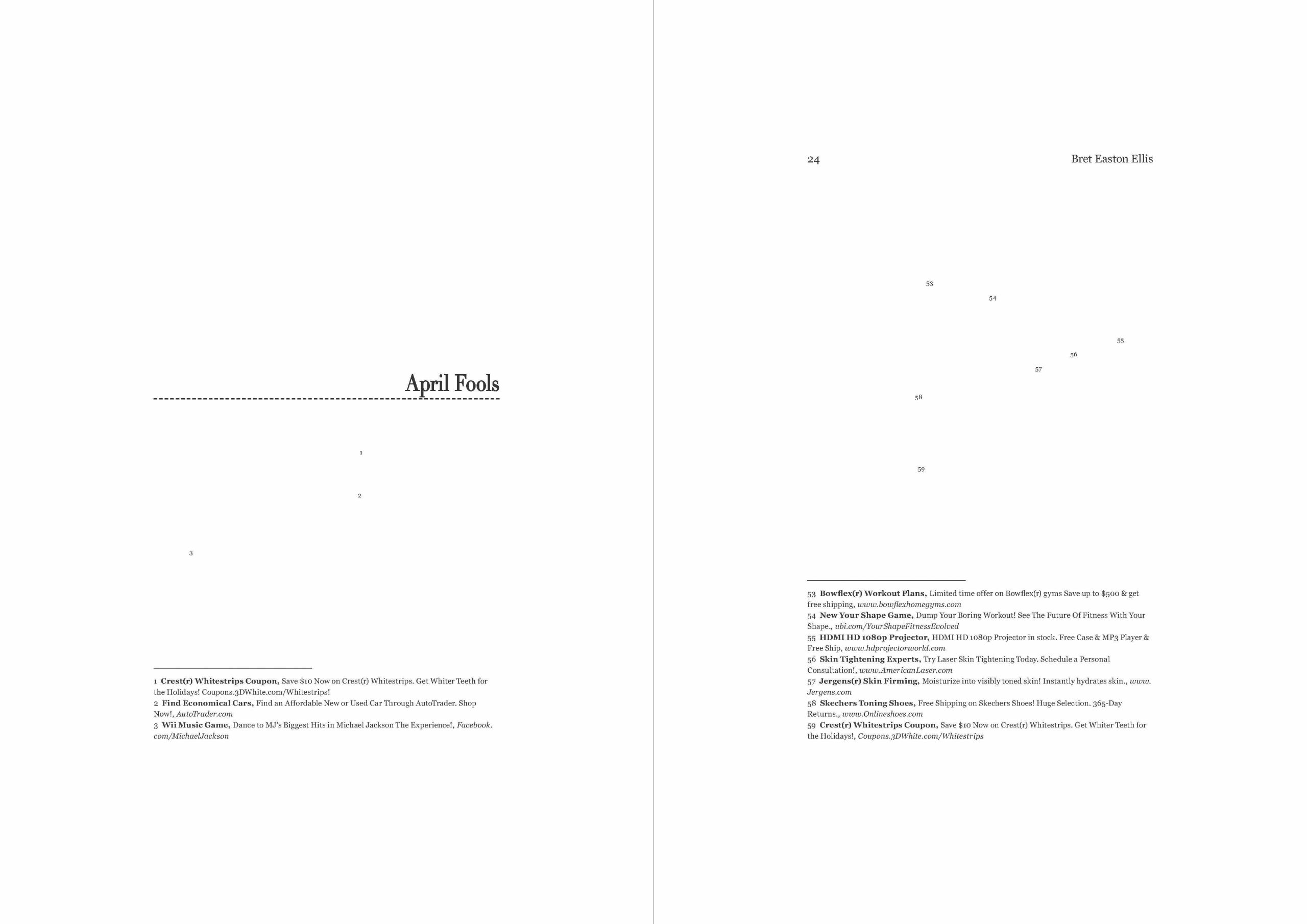
Figure 1. Mimi Cabell and Jason Huff, American Psycho (detail), 2010
Photo: The artists
For example, the online profit-oriented recognition of linguistic and behavioural patterns was deftly subverted by Mimi Cabell and Jason Huff in American Psycho (2012). The artists mutually Gmailed all the pages of Bret Easton Ellis’ novel American Psycho (1991), one page per email, and correspondingly annotated the original text with the Google ads generated for each email. They erased the original email/novel text, leaving only the chapter titles and the ads as footnotes. The initial generative phase of emailing could have been manual or programmed but the outcome of this project is a printed and bound book (Figure 1). American Psycho (2012) recursively employs the early 21st century marketing strategies based upon data-mining to process the narrative about the paroxysms of business culture in the early 21st century.31
In Google Will Eat Itself (GWEI) (2005) by Übermorgen, Paolo Cirio and Alessandro Ludovico, the initial production phase required automatic procedures, and was temporarily featured as a live online event, but the project has since been exhibited in documentary form. The artists hijacked Google’s AdSense initiative by designing software bots to click on banner ads placed on a network of hidden websites. Another set of bots channeled the generated revenue to buy Google’s shares and distribute them publicly via GTTP Ltd., which would eventually turn Google into a public company.32 GWEI was executed as a proof of concept with a purpose to address the control of information and the banality of online advertising mechanisms by outsmarting their own operational logic, rather than to actually buy out all Google stocks. After 1,556,361 AdSense clicks that generated USD$405,413.19 and bought 819 Google Shares, the bots were disengaged and since then the project has been properly represented by documentation detailing all phases, effects and consequences (Figure 2).
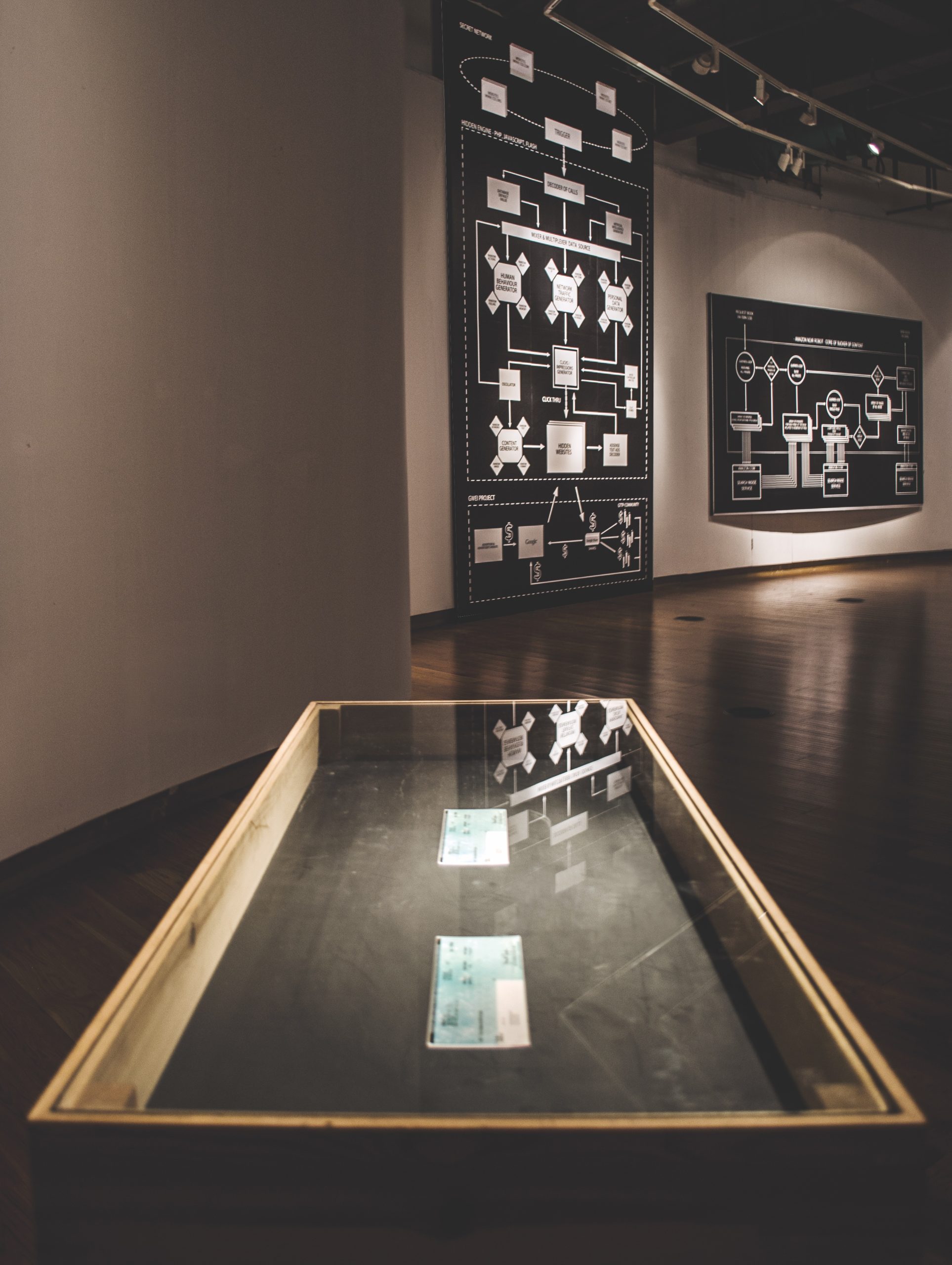
Figure 2. Übermorgen, Paolo Cirio and
Alessandro Ludovico, Google Will Eat Itself, 2005
Installation view of Hacking Monopolism Trilogy at China Academy of Art, Hangzhou, China
Photo: Paolo Cirio
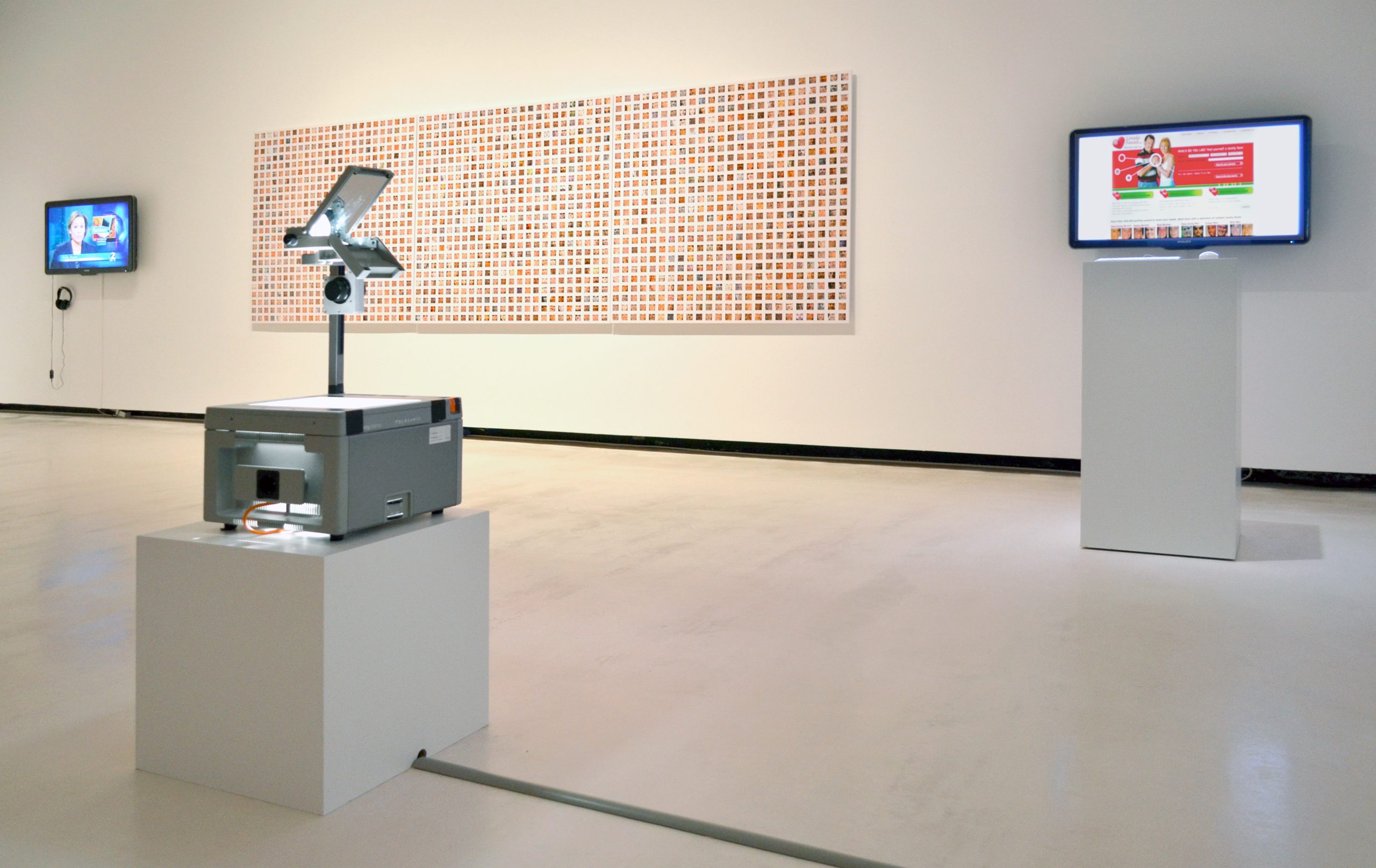
Figure 3. Paolo Cirio and Alessandro Ludovico, Face to Facebook, 2010
Installation view of Artists as Catalysts exhibition in Azkuna Zentroa, Spain
Photo: Paolo Cirio
In Face to Facebook (2010)—the final project in the Hacking Monopolism Trilogy that began with GWEI and Amazon Noir (2006)—Cirio and Ludovico created a bot which harvested one million Facebook profiles, filtered out 250,000 profile photos, tagged them by the facial expressions (relaxed, egocentric, smug, pleasant, etc.) and posted them as profiles on a fictitious dating website called Lovely Faces at http://www.lovely-faces.com.33 Lovely Faces had been fully accessible and searchable for five days, during which the artists received several letters from Facebook’s lawyers, eleven lawsuit warnings, and five death threats.34 The project has since been presented as a multimedia documentary installation (Figure 3).
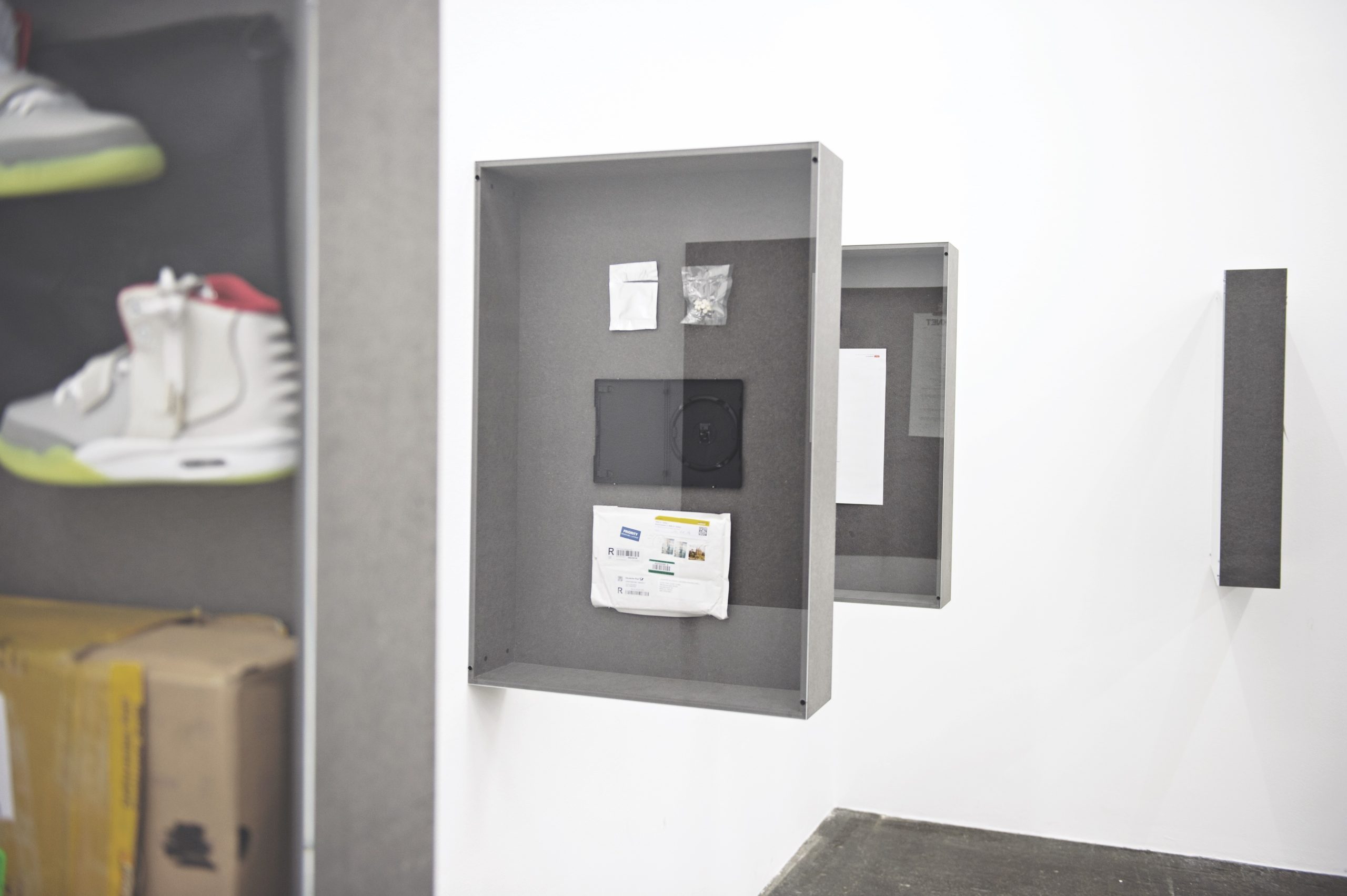
Figure 4. !Mediengruppe Bitnik, Random Darknet Shopper, 2014-2016
Installation view in Kunsthalle St. Gallen, Switzerland
Photo: Gunnar Meier/ Kunsthalle Sankt Gallen
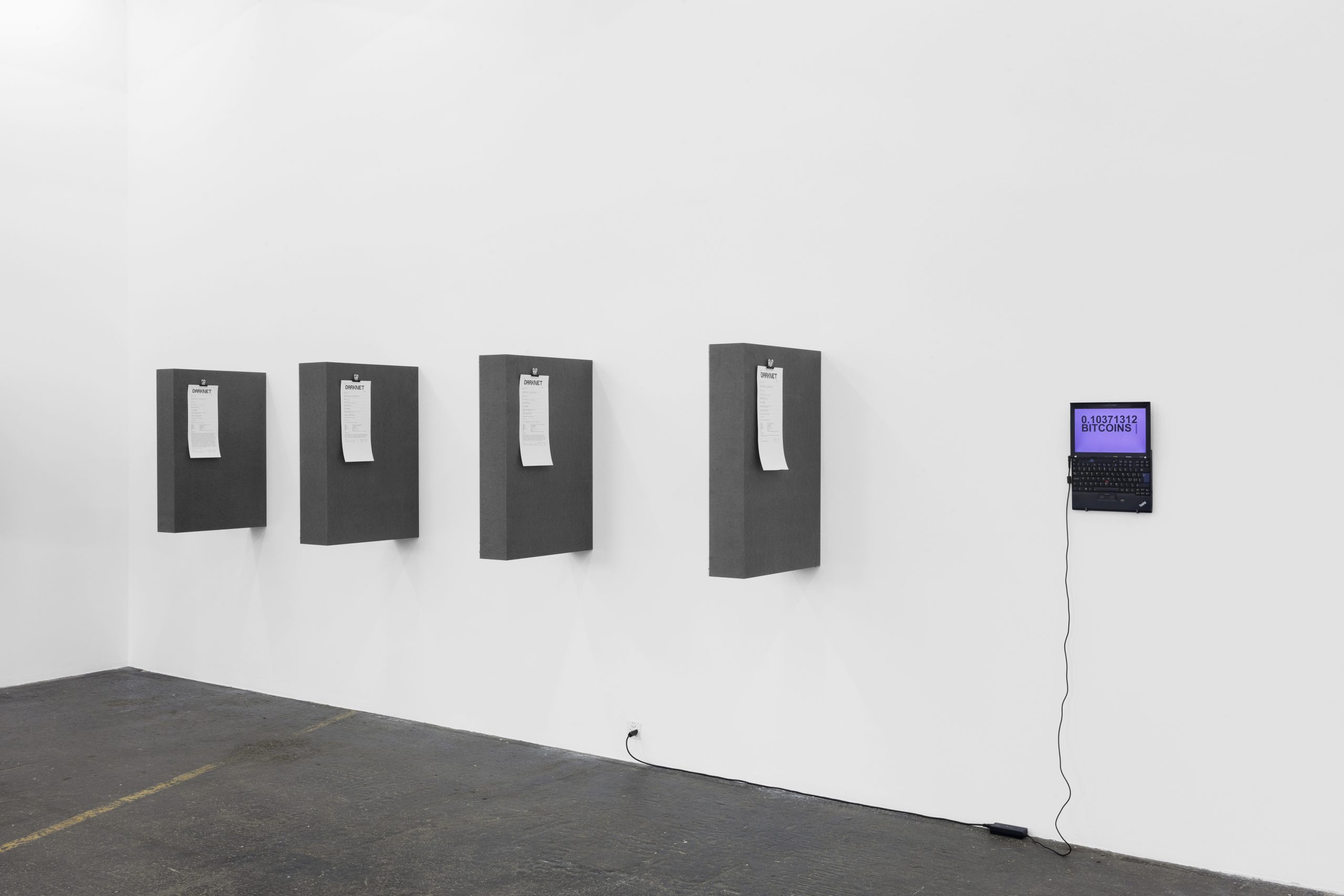
Figure 5. !Mediengruppe Bitnik, Random Darknet Shopper, 2014-2016
Installation view in Kunsthalle St. Gallen, Switzerland
Photo: Florian Bachmann
!Mediengruppe Bitnik’s Random Darknet Shopper (2014-2016) was a live generative project that pragmatically exploited web anonymity tools such as Tor (Figures 4 and 5). It was an online shopping bot which roamed the dark web marketplaces such as Agora or Alpha Bay where it randomly purchased items within a weekly budget of $100 in Bitcoins, and had the goods mailed directly to the exhibition space where they were displayed, with a screen device monitoring the bot’s shopping activities.35 The gallery presentation of Random Darknet Shopper now features a collection of purchased goods with a display record of the bot’s shopping activities and its various consequences.
Many generative art projects, on the other hand, feature continuous real-time transactions between intelligent networked agents. They can be preserved as documentation, and can be simulated by sampling the pre-recorded events, transactions and triggers from a database. But a simulation cannot fully rebuild their emotional space which requires our real-time involvement with the remote agents’ actions and their consequences. Our empathy in this seemingly ambivalent participation is facilitated by the contextual insights emerging live from the abstraction layer of technology.
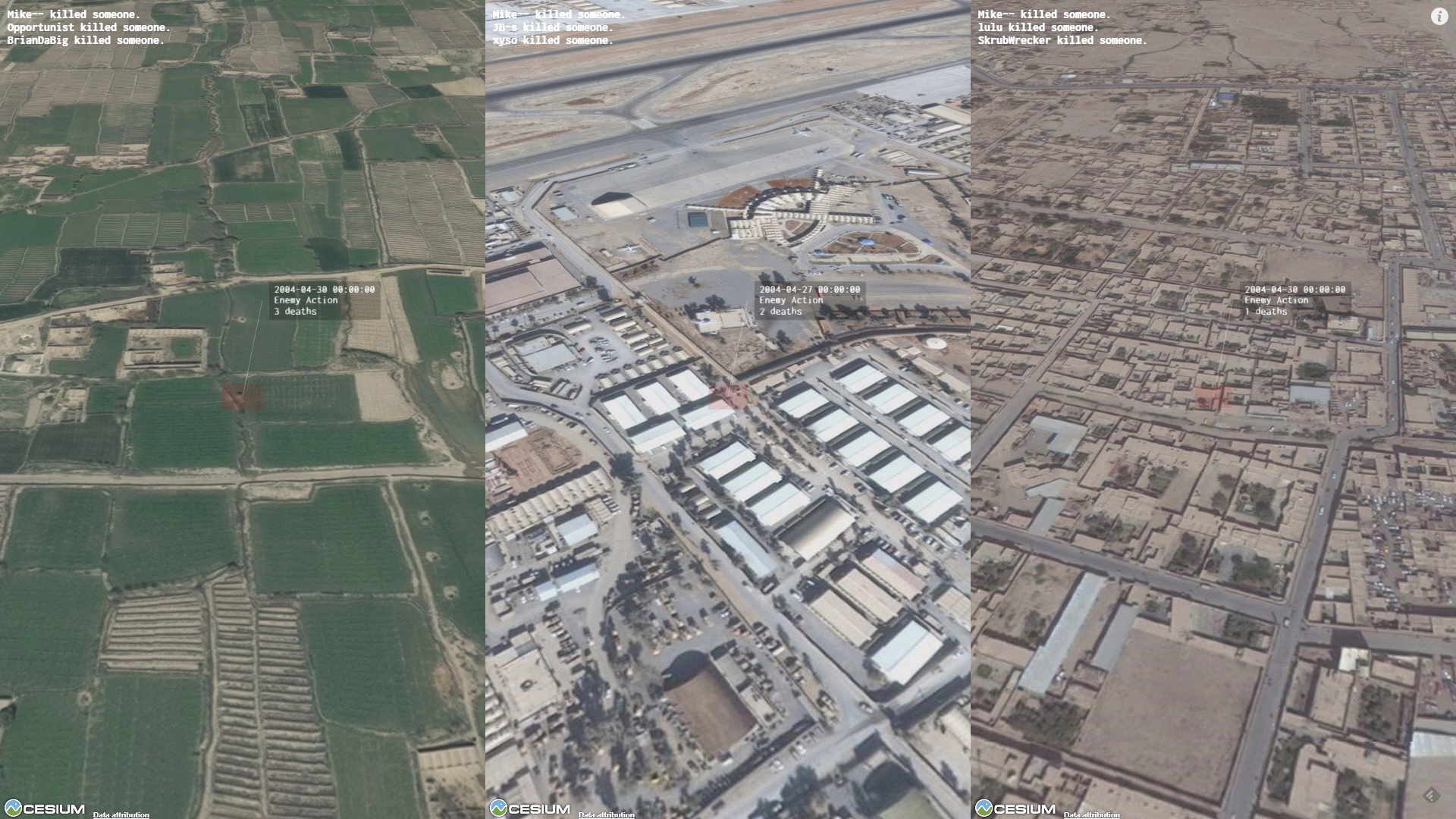
Figure 6. Matthieu Cherubini, Afghan War Diary, 2010
Screenshot

Figure 7. Nicolas Maigret and Brendan Howell, The Pirate Cinema, 2012-2014
Installation view
For example, in Matthieu Cherubini’s installation Afghan War Diary (2010) the artist’s website connects to an online server for Counter-Strike war game and retrieves frags (events when one player kills another) in real-time (Figure 6). These frags trigger a chronological search in the Wikileaks database containing over 75,000 secret US military incident reports on the war in Afghanistan. Based on the retrieved data, the website shows the geolocation of the incidents on a virtual globe in three-channel arrangement.36
With The Pirate Cinema (2012-2014), Nicolas Maigret and Brendan Howell merge the sampling of film and TV with the world of live peer-to-peer exchange (Figure 7). Their installation monitors the 100 most-downloaded torrents on a popular tracker website, intercepts the video and audio snippets currently being served, plays them on the multichannel screen set with the information on their origin and destination, then discards them and repeats the process with the next stream in the queue.37
In Take a Bullet for This City (2014), Luke DuBois emphasised the contextual factors of the allusiveness of selective quantification regarding gun violence in the US. The 911 calls reporting a ‘discharging firearm’ in New Orleans are registered in real-time by a computer-driven mechanism that pulls the trigger of a real, blank-firing handgun installed in the gallery, ejects and accumulates the spent cartridges into a vitrine.38
Entanglement
Generative artworks that feature multi-directional, real-time and continuous interaction between intelligent actors cannot be adequately represented through a simulation.

Figure 8. Matt Richardson, Descriptive Camera, 2012
Photo: Matt Richardson
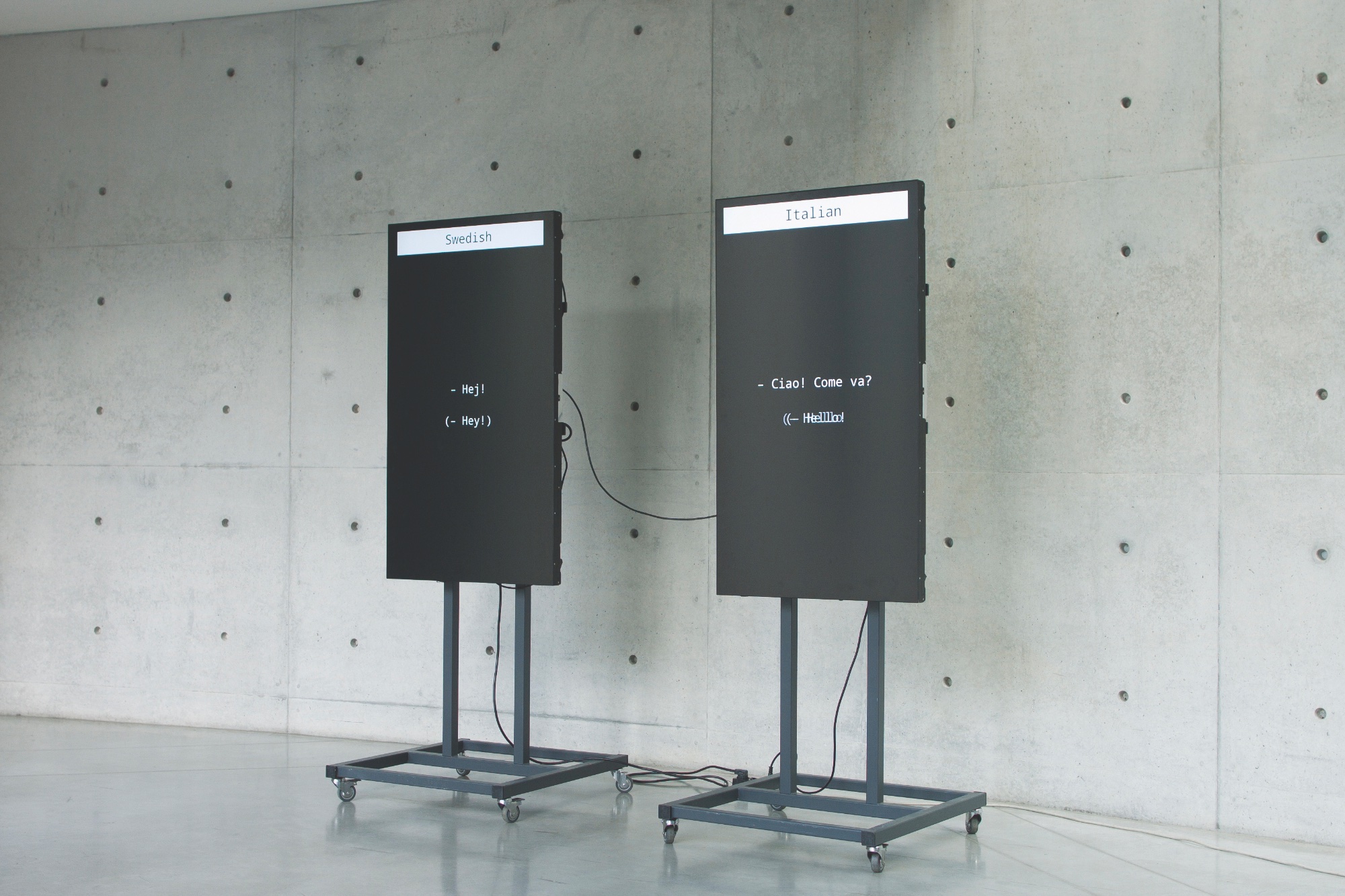
Figure 9. Jonas Eltes, Lost in Computation, 2017
Installation view in FABRICA Research Centre, Treviso, January 2018
Photo: Jonas Eltes/FABRICA
For example, in Matt Richardson’s Descriptive Camera (2012), a photographed image generates narrative interpretation by the remote human agent (Figure 8). When we point the Descriptive Camera at a subject and press the shutter button, the device does not display the image but sends it simultaneously to Amazon’s Mechanical Turk where human ‘workers’ write down its description, and the device prints it out.39 While modern digital cameras capture various contextual metadata of the photographs, the Descriptive Camera only delivers the metadata ‘about’ the photographed content, and deliberately requires human intellectual labour for image processing instead of the artificial intelligence like, for example, Ross Goodwin’s application word.camera (2015) which translates photographs into narratives using AI.40
Reflecting Ken Feingold’s earlier generative works with AI speech synthesis and recognition, in Jonas Eltes’ installation Lost in Computation (2017) all agents are non-human. It continuously generates a real-time conversation between a Swedish-speaking and an Italian-speaking chatbot connected through Google Translate (Figure 9). It simultaneously highlights the absurdity of machine cognition and provides the evidence of the current level of accuracy and flexibility that language modelling algorithms have achieved.41
One of the key poetic factors in these artworks is our awareness of the uncanny emerging from heterogenous, dislocated, concurrent and actual processes, including the creative dynamics of the AI/ML systems. Hypothetically, this kind of generative artworks could be emulated by sophisticated networks running AI/ML software trained to imitate the behaviour of human and machine agents. From the current perspective this would be unreasonably expensive or technically impossible but could be attainable in the future with sufficiently detailed specifications of each artwork’s structure and functionality.
Originating since the early 2000s, these conceptually sophisticated and technically advanced but museologically unstable generative art practices precede and, somewhat ironically, precondition the post-digital art.42 Post-digital artists take digital infrastructure pragmatically (as a common utility), and use digital technologies to thematise the phenomenology of contemporary culture but mainly produce their works in conventional materials and non-interactive media. Their aestheticisations of the proliferation of digital artefacts and effects resemble the cool, disillusioned and detached observation which became popular with the artists in the mid-1970s New York City,43 and diversified in postmodern art during the 1980s. Being easier to exhibit, preserve, own and sell, they also conform more smoothly to the conservatism of the mainstream art world.44
Universal(instabil)ity
But the conservational risks and cultural uncertainty haunting contemporary generative art are not exceptional. They arise from the asymmetry between the artists’ inventiveness, anticipations and technical resources, and are as old as the arts. Although the arts—in general—rely on complex interrelated production and presentation technologies, and moreover, require multifaceted contextual knowledge for deep understanding and appreciation, the artists do not always envision their works to be conceptually timeless or materially future-proof. Whether they just enjoy quick and direct communication, or are driven by the ambition to reach the indefinitely remote spatiotemporal continuum, nothing meaningful is forever in the entropic universe. Demonstrating human wit, proteanism and creativity as the rapid generators of unpredictable and highly variable alternatives, the arts are particularly prone to decay.45 A classic example is Leonardo da Vinci’s intensive experimentation with ideas and technology, which resulted in many unfinished works, and in the accelerated deterioration of his masterpieces. In that sense, the current elusiveness of archival solutions for generative art confronts us with the ultimate impossibility to unconditionally preserve the objects, events and other cultural products that carry symbolic value.
Exploring the human universals such as concepts of time, death and vanity, the artists have also appreciated the cultural porosity of art and understood that an artwork lives and dies just I believe that a picture, a work of art, lives and dies just as we do.” Baudson, “An interview with Marcel Duchamp” ']as we do.46 Artworks vary not only in material resilience but also in emotional, narrative, informational, exploratory, cognitive or political impact and relevance. They are not equally interesting or engaging and their values are not fixed. Ideally, this instability of artistic mental worth reflects scientific principles and epistemological assets such as critical thinking and testability, but the capricious status of the artists and the artworks is often affected by fancy, fashion and authority appeal. The instability of artistic mental worth also evokes the reductive economy of the conscious experience, which suggests that perceptive brevity and forgetting may be evolutionary adaptive.47 But transience, erasure and forgetting are probably not beneficial for the evolution of human society. Cultural memory and preservation build up the infrastructure for progress, development and betterment of civilisation. They provide contextually efficient access to the functional and well-organised accumulated information, which is essential for fostering creativity and learning, for deepening our understanding of what it means to be human, and for improving the sense of our place in nature.
Save and Open As...
Contemporary generative art is a unique repertoire of creative approaches that reveal the crucial features of the digital paradigm and motivate our critical thinking about digital culture. They engage the fundamental ideas, logic and functionality of digital technologies humorously, intelligently and proactively, through bricoleur style experiment and playful exploration. These conceptual and methodological qualities are essential for establishing deep insights into the relevant aspects of our world, but at the same time they make generative artworks difficult to preserve and represent.48
Contemporary generative practices expand, enrich and enhance the already proven cultural relevance of new media art, and require the adequate institutional, academic, educational, financial and technical support.49 The first wave of new media art museology has funded the infrastructure for systematic study, preservation, representation and promotion.50 In addition, we need to address the specific current issues, trade-offs and risks, and to anticipate the potentials of the emerging generative art. Centralisation, exclusivity and monopolistic standardisation should be avoided because a diversity of approaches and initiatives offers higher accessibility, versatility in discovery, and better archival security.51 The optimal strategy would be to instigate, fund, connect and coordinate a multitude of platforms and projects of different scales and scopes into a robust network for archiving, distributing, transferring, and exhibiting new media and generative art.
Footnotes
1 Cahill 20-24
2 Galloway
3 Scott 30-34
4 Boyle-Singfield
5 Miller 300-340
6 Irational.org
7 Ljudmila.org
8 V.A. “iSee”
9 V.A. “Jennifer Lyn Morone, Inc.”
10 Blas
11 Hill and Hofstadter
12 Fry
13 Warthon
14 Keith-Soo 525
15 Galanter 225-245; Arns; Quaranta 1-7; Boden and Edmonds 21-46; Watz 1-3; Pearson 3-6
16 Dorin et al. 239–259
17 Grba 200-213
18 Weibel 21-41; Rosen 27-43
19 Grba 200-213
20 Arns; Watz 1-3
21 Giovacchini and Sklar 2
22 Claude Lévi-Strauss 13
23 Mambrol
25 Gere, “New Media”
26 Paul, New Media 4-7
27 Epler
28 Wedekind
29 Zeilinger
30 Castells 176-180
31 Cabell and Huff
32 Cirio “Google Will Eat Itself”
33 Cirio “Face to Facebook”
34 Gleisner “Paolo Cirio’s Lovely Faces”
35 !Mediengruppe Bitnik
36 Cherubini
37 Maigret and Howell; Cox
38 “Take a Bullet for This City,” Vimeo
39 Richardson; Amazon’s Mechanical Turk is a platform that facilitates serving the Human Intelligence tasks to the ‘workers’ on the Internet to complete for a certain price
40 The algorithm extracts tags from the images using Clarifai’s convolutional neural networks, blows them up into paragraphs using a lexical relations database ConceptNet and a flexible template system. It knows what to write because it sees concepts in the image and relates those concepts to other concepts in the ConceptNet database. The template system enables the code to build sentences that connect those concepts together (Merchant)
41 Eltes
42 The current post-digital art nomenclature includes the terms ‘post-media’ and ‘post-Internet art’
43 BBC “Hypernormalisation,” 2016
44 Paul 2016
45 Miller 405
46 As Marcel Duchamp remarked in a 1966 interview: “[…] I believe that a picture, a work of art, lives and dies just as we do.” Baudson, “An interview with Marcel Duchamp”
47 Nørretranders 23-27, 124-144
48 Whether these qualities make generative artworks intellectually superior to some of the more palatable layers of contemporary art is the matter of individual taste and experience
49 Gere 2008, 79-115; Rosen 27-43
50 V.A. “Digital Art and the Institution” 461-596
51 Ippolito 537-552
References
Arns, Inke. “Read_me, run_me, execute_me. Code as Executable Text: Software Art and its Focus on Program Code as Performative Text.” Medien Kunst Netz website, 2004, http://www.medienkunstnetz.de/themes/generative-tools/read_me/1/. Accessed 29 April 2019.
Baudson, Michel. “An interview with Marcel Duchamp.” Edited transcript of the interview with the artist, filmed by Jean Antoine in 1966 (translated by Sue Rose). The Art Newspaper, No. 27, April 1993, http://ec2-79-125-124-178.eu-west-1.compute.amazonaws.com/articles/An-interview-with-Marcel-Duchamp/29278. Accessed 29 April 2019.
Blas, Zach. “Facial Weaponization Suite.” Zach Blas, 2011-2014, http://www.zachblas.info/works/facial-weaponization-suite/. Accessed 29 April 2019.
Boden, Margaret, and Edmonds, Ernest. “What is Generative Art.” Digital Creativity, 20, (1-2), 2009, pp. 21-46.
Boyle-Singfield, John. “Erased Cory Arcangel Website.” John Boyle-Singfield, 2013, https://johnbsingfield.github.io/erased-arcangel/.
Bunting, Heath. n.d. Irational.org. http://www.irational.org/. Accessed 29 April 2019.
Cabell, Mimi and Huff, Jason. “American Psycho.” Mimi Cabell, 2012, http://www.mimicabell.com/gmail.html. Accessed 29 April 2019.
Cahill, James Leo. “...and Afterwards? Martin Arnold’s Phantom Cinema.” Cinema, Special Graduate Conference Issue, Spectator 27: Supplement, 2007, pp. 20-24.
Castells, Manuel. The Information Age Vol. 1: The Rise of the Network Society. Chichester: Wiley-Blackwell, 2010.
Cherubini, Matthieu. “Afghan War Diary.” Matthieu Cherubini, 2010, http://mchrbn.net/afghan-war-diary/. Accessed 29 April 2019.
Cirio, Paolo. “Google Will Eat Itself.” Paolo Cirio, 2005, https://paolocirio.net/work/gwei/. Accessed 29 April 2019.
———. “Face to Facebook.” Paolo Cirio, 2010, https://paolocirio.net/work/face-to-facebook/. Accessed 29 April 2019.
Ćosić, Vuk. Ljudmila.org., http://www.ljudmila.org/~vuk/. Accessed 29 April 2019.
Cox, Geoff. “Real-Time for Pirate Cinema.” PostScriptUM, No. 20, Aksioma Institute for Contemporary Art, 2015, http://aksioma.org/pdf/aksioma_PostScriptUM_20_ENG_Maigret.pdf. Accessed 29 April 2019.
Dorin, Alan, McCabe, Jonathan, Monro, Gordon and Whitelaw, Mitchell. “A Framework for Understanding Generative Art.” Digital Creativity, 23, (3-4), 2012, pp. 239–259.
Eltes, Jonas. “Lost in Computation.” Jonas Eltes. 2017. https://jonaselt.es/projects/lost-in-computation/. Accessed 29 April 2019.
Epler, Matthew. “ReCode.” ReCode project website, 2012. http://recodeproject.com/. Accessed 29 April 2019.
Fino-Radin, Ben. “The Nuts and Bolts of Handling Digital Art.” A Companion to Digital Art, edited by Christiane Paul. Chichester: John Wiley & Sons, Inc., 2016, pp. 516-536.
Fry, Ben. “Video Experiments.” Ben Fry, 1998. https://benfry.com/video98/. Accessed 29 April 2019.
Galanter, Philip. “What is Generative Art? Complexity Theory as a Context for Art Theory.” VI Generative Art conference Proceedings, edited by Celestino Sodu. Milan: Domus Argenia, 2003, pp. 225-245. http://www.generativeart.com/on/cic/papersGA2003/papers_GA2003.htm. Accessed 29 April 2019.
Galloway, Alexander. “Jodi’s Infrastructure.” E-flux Journal, 2016. http://www.e-flux.com/journal/74/59810/jodi-s-infrastructure/. Accessed 29 April 2019.
Gere, Charlie. “New Media Art and the Gallery in the Digital Age.” Tate Research Papers, London: Tate, 2004. http://www.tate.org.uk/file/charlie-gere-new-media-art-and-gallery-digital-age. Accessed 29 April 2019.
———. “The Digital Avant-garde.” Digital Culture. London: Reaktion Books, 2008, pp. 79-115.
Giovacchini, Saverio and Sklar, Robert. Global Neorealism: The Transnational History of a Film Style. Jackson, MS: University Press of Mississippi, 2013.
Gleisner, Jacquelyn. “Paolo Cirio’s Lovely Faces.” Art 21, 12 Aug 2013. http://magazine.art21.org/2013/08/12/new-kids-on-the-block-paolo-cirios-lovely-faces/#.XMLlPKQRVPY. Accessed 29 April 2019.
Grba, Dejan. “Get Lucky: Cognitive Aspects of Generative Art.” XIX Generative Art Conference Proceedings, edited by Celestino Sodu. Venice: Fondazione Bevilacqua La Masa, 2015, pp. 200-213, http://dejangrba.dyndns.org/lectures/en/2015-get-lucky.php. Accessed 29 April 2019.
Hill, Joe and Hofstadter, Douglas R.. Jason Salavon: Brainstem Still Life. Bloomington, IN: School of Fine Arts Gallery, Indiana University and LASALLE College of the Arts, Singapore, 2004.
“HyperNormalisation.” Directed by Curtis, Adam. BBC TV documentary, 2016. 00:07:10-00:10:36
Ippolito, Jon. “Trusting Amateurs with Our Future.” A Companion to Digital Art, edited by Christiane Paul. Chichester: John Wiley & Sons, Inc, 2016, pp. 537-552.
Keith-Soo, Chin-En. “Hueue.” XX Generative Art Conference Proceedings, edited by Celestino Sodu. Generative Design Lab, Milan: Politecnico di Milano University / Rome: Argenia Ass, 2017, pp. 525.
Lévi-Strauss, Claude. The Savage Mind. Chicago, IL: University of Chicago Press, 1962.
Maigret, Nicolas and Howell, Brendan. “The Pirate Cinema.” The Pirate Cinema project, 2012, http://thepiratecinema.com. Accessed 29 April 2019.
Mambrol, Nasrullah. “Claude Lévi Strauss’ Concept of Bricolage.” Literary Theory and Criticism, 2016, https://literariness.org/2016/03/21/claude-levi-strauss-concept-of-bricolage. Accessed 29 April 2019.
!Mediengruppe Bitnik. “Random Darknet Shopper.” !Mediengruppe Bitnik website, 2014, https://wwwwwwwwwwwwwwwwwwwwww.bitnik.org/r/. Accessed 29 April 2019.
Merchant, Brian. “This App Translates Your Photos into Stories.” Motherboard: Tech by Vice, 14 Apr 2015, https://motherboard.vice.com/en_us/article/8qx7q3/the-app-that-translates-your-pictures-into-words. Accessed 29 April 2019.
Miller, Geoffrey. The Mating Mind: How Sexual Choice Shaped the Evolution of Human Nature. New York, NY: Anchor Books/Random House, Inc, 2001.
Nørretranders, Tor. The User Illusion: Cutting Consciousness Down to Size. New York, NY: Penguin, 1999.
Paul, Christiane, New Media in the White Cube and Beyond: Curatorial Models for Digital Art. Berkeley, CA: University of California Press, 2008, pp. 4-7.
———. “Collecting the Digital — Materials, Markets, Models.” Media Art and the Art Market Symposium, LENTOS Kunstmuseum Linz, 2016, http://interface.ufg.ac.at/blog/media-art-and-the-art-market-speakers/#Paul. Video recording, Accessed 29 April 2019. https://vimeo.com/192670584. Accessed 29 April 2019.
Pearson, Matt. Generative Art. Shelter Island, NY: Manning Publications, 2011, pp. 3-6.
Quaranta, Domenico. “Generative (Inter)Views: Recombinant Conversation With Four Software Artists.” ed. C.STEM. Art Electronic Systems and Software Art. Turin: Teknmendia, 2006, pp. 1-7.
Richardson, Matt. “Descriptive Camera.” Matt Richardson’s website, 2012, http://mattrichardson.com/Descriptive-Camera/. Accessed 29 April 2019.
Rosen, Margit. 2011. “The Art of Programming: The New Tendencies and the Arrival of the Computer as a Means of Artistic Research.” A Little-Known Story about a Movement, a Magazine, and the Computer’s Arrival in Art: New Tendencies and Bit International, 1961-1973, edited by Margit Rosen. Cambridge, MA: The MIT Press, pp. 27-43.
Scott, Andrea K. “Futurism: Cory Arcangel Plays Around with Technology.” The New Yorker, 30 May 2011, pp. 30-34, https://www.newyorker.com/magazine/2011/05/30/futurism. Accessed 29 April 2019.
“Take a Bullet for This City.” Vimeo, uploaded by Luke DuBois, 2014, https://vimeo.com/110217245. Accessed 29 April 2019.
Taylor, Grant D. When the Machine Made Art: The Troubled History of Computer Art. New York and London: Bloomsbury Press, 2014.
V.A. “Jennifer Lyn Morone, Inc.” Jennifer Lyn Morone, Inc., 2014, http://jenniferlynmorone.com/. Accessed 29 April 2019.
———. “Digital Art and the Institution.” A Companion to Digital Art, edited by Christiane Paul. Chichester: John Wiley & Sons, Inc, 2016, pp. 461-596.
———. “iSee.” 21st Century Digital Art, 2017, http://www.digiart21.org/art/isee. Accessed 29 April 2019.
Warthon, Rhyland. “Palette Reduction.” Rhyland Warthon’s website, 2009, http://rylandwharton.com/works/palette-reduction/. Accessed 29 April 2019.
Watz, Marius. “Closed Systems: Generative Art and Software Abstraction.” MetaDeSIGN - LAb[au], edited by Eléonore de Lavandeyra Schöffer, Marius Watz and Annette Doms, Dijon: Les presses du réel, 2010, pp. 1-3.
Wedekind, Joachim. “Digital Art Gallery.” Joachim Wedekind, 2014, http://digitalart.joachim-wedekind.de/dag/. Accessed 29 April 2019.
Weibel, Peter. “It Is Forbidden Not to Touch: Some Remarks on the (Forgotten Parts of the) History of Interactivity and Virtuality.” Media Art Histories, edited by Oliver Grau, Cambridge, MA: MIT Press, 2007, pp. 21-41.
Zeilinger, Martin. “Pattern Recognition.” Martin Zeilinger, 2017, http://marjz.net/works/. Accessed 29 April 2019.
Essays
ERASURES: Being, Seen
Erase (v.)
c. 1600, from Latin erasus, past participle of eradere, “to scrape out, scrape off, shave; to abolish, remove.” Of magnetic tape, from 1945.1

McDonalds Trabant, Andrea Luka Zimmerman
Being
“Between the experience of living a normal life at this moment on the planet and the public narratives being offered to give a sense of that life, the empty space, the gap, is enormous.” – John Berger2
My grandfather was incarcerated in a Russian Gulag from age 16 to 21. Once released, he sailed the world on merchant ships, and settled in a country (Germany) he had never lived in before. In and out of prison, reluctant to submit to (absolutely any kind of) authority, he became a serious alcoholic and died young. Unless drunk he never spoke, but then no one wanted to speak to him, neither his wife nor his children, themselves also damaged people. And then there was me.
I was the only one he agreed to speak with, and so, while I lived with them during bouts of homelessness, I became the one through whom the others conversed.
My grandfather’s stories were vivid, always the same, tortured; they revealed modes of torture that damaged his body and mind forever. In response, I continually made up stories about superheroes and avengers. In their company, my grandmother and mother expected me to be like them. Stop talking. Stop making up stories. Be silent. Be silent. After all, they were silent too. They could not unlearn the idea that speaking was dangerous. Only my grandfather really spoke (when he chose to), perhaps at me, but certainly into me. I loved him. I was seven when he said that I, too, was torturing him with my questions, that they made holes in his belly, and he showed me that belly, which was indeed full of holes.
Towards Erasure
Today the vast majority of dominant cinema, regardless of genre, mode or even thematic concerns, feels like a childhood toy: something to hug, something to remember fondly, something that finally reassures, and which, as a result, can effectively be forgotten. It has lost its activating fuse, producing an international cinematic conservatism and passive audiences, upholding what film-maker Peter Watkins as long ago as 1967 termed the ‘monoform’: a delivery structure where all the complexities of life, society and history, regardless of the severity, mundanity or grace of the themes, are reduced into the same formal narrative engine, as predictable and recognisable as a famous fast food chain, and offering a similar ‘comfort’.
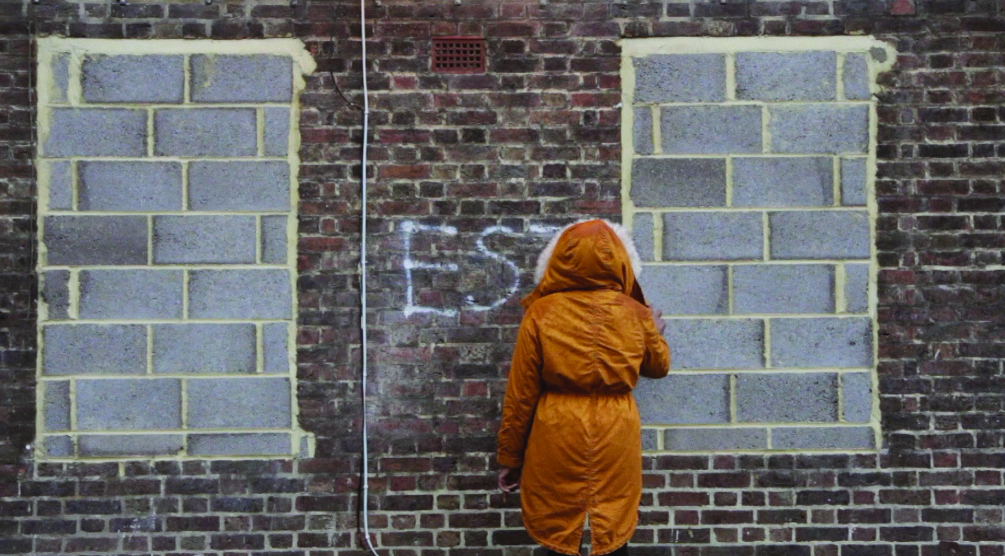
Estate, Fugitive Images
Before its workings are understood, the power of cinema is often evasive, slippery. At the opposite end (its result) is what is often termed powerlessness, a feeling that accompanies the sense of being made invisible, insignificant, a voice that does not count. However, what surfaces, closer to obstinacy, rather than resilience, is a making visible, and not in response to erasure, but regardless of it.
Here I will explore, though my own approach to making films, various manifestations of and challenges to power (especially in its ‘behind-the-scenes’ identity, from covert military operations to city planning). For the past 10 years my work has focussed on the often under-explored and under-expressed intersections of public and private memory, especially in relation to place, communities and to structural and political violence.

Estate, Fugitive Images
Throughout, my approach has been socially collaborative, in content, form and production. Formally, my films seek to open (for both the participants and audience) a space for consideration of the shifting border between documentary and fiction, using long-term observations, interventions in real-life situations, re-enactments, found materials, archival traces and ‘always the honouring of lived experience.’ I seek an ethically engaged, culturally resonant expression of shared humanity, and a co-existence with larger ecologies (beyond human-centred subjectivity).
So…
I have set out these criteria:
To reject the erasure of place, history, relations and difference.
To acknowledge my own lifelong experience of these concerns, and the class expectations and restrictions that accompanied my own journey into an understanding of these structural assaults.
To find a visuality that is not only in opposition to (or merged with) the erasure as we, in different ways already experience it, in our surroundings, in our bodies, in our minds, and in our ways of sensing each other.
To enable a making and embracing of an aesthetic that allows for the presence of ambiguities, of a tone that might be called troubling, unsettling (unable and unwilling fully to be reconciled or resolved) and yet, in spite of that, to voice a complex solidarity for and with each other.
To understand that each film is a form of making and briefly finding ‘home’, a moving from being-forced-to-dwell-inside one structure to making, along with others, another structure in which the existential complexity of our life in the world as we find it (and seek to make it) is allowable.*
Against Erasure of Place
Estate a Reverie (2015)
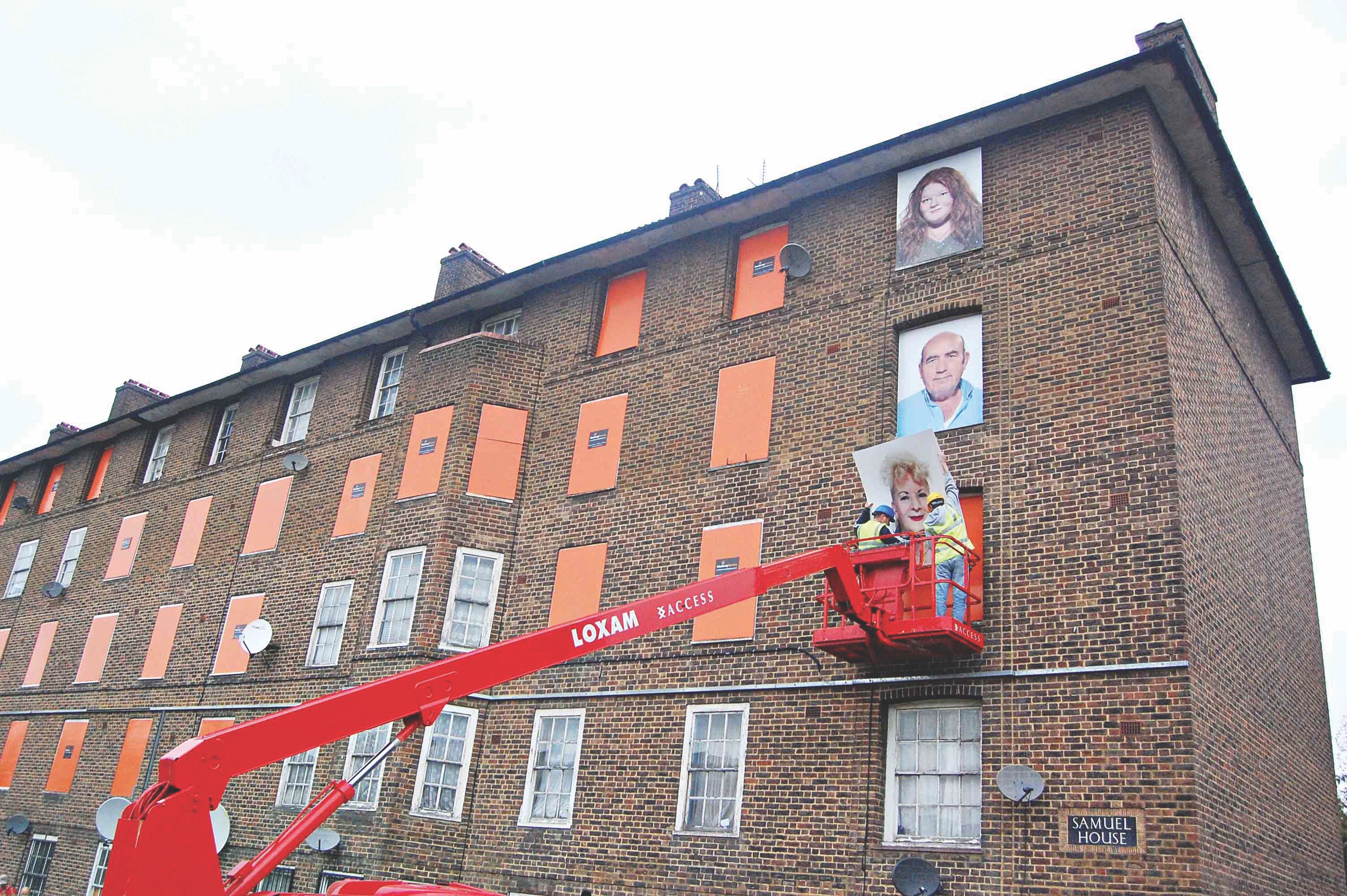
Estate, Fugitive Images
Estate, a Reverie speaks to and of a city long inhabited by a huge diversity of communities (whether focussed around ethnicity, nationality, belief, gender or sexuality, and not forgetting, of course, finance, class and vocational groupings), a territory whose complex identity is at stake within the unfolding and accelerating narrative of globalised gentrification or ‘development’. It is a zone whose buildings, functions and populations are being challenged by ‘incursionist’ forces—of speculative capital, architecture and commerce—threaten the current spectrum of ways of being in this location.
The film tries to make sense of a process that is regarded in public discourse as inevitable, one that declares public housing in its original sense to be dead, made obsolete by the market ‘choices’ of a neoliberal world, one shaped by both finance and consumer capitalism.
What is the movement, subtly, of perception, accompanying this shift? The privatised city (including militarised domestic vehicles, private healthcare, schooling, roads and more) has at its mirror image, the ‘other’. We often cannot precisely ‘see’ how power works, and mostly we do not even notice it, until we (some bodies more than others) are subjected to its full force.
Clichés and stereotypes in policy and commentary are reinforcing ideas of the abject, alongside an accompanying sectional ‘public’ fear. This instigates a further spread of the private sphere (structurally, legislatively and mentally) into the public realm, intended to make certain groups of people ‘feel’ they are not welcome: not welcome to participate, unable to, and in fact undesired. Strangers in their own time and place.
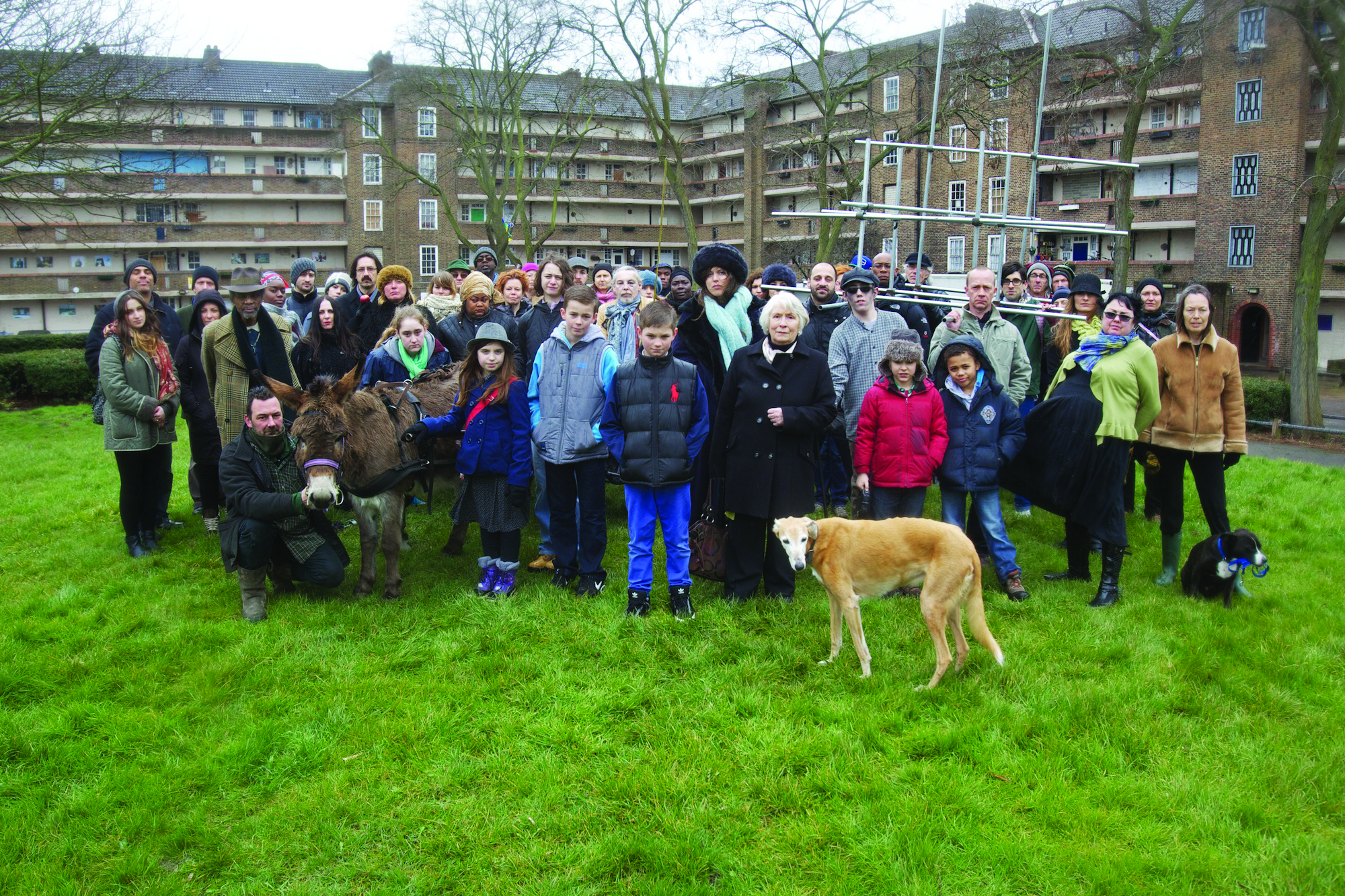
Estate, Briony Campbell
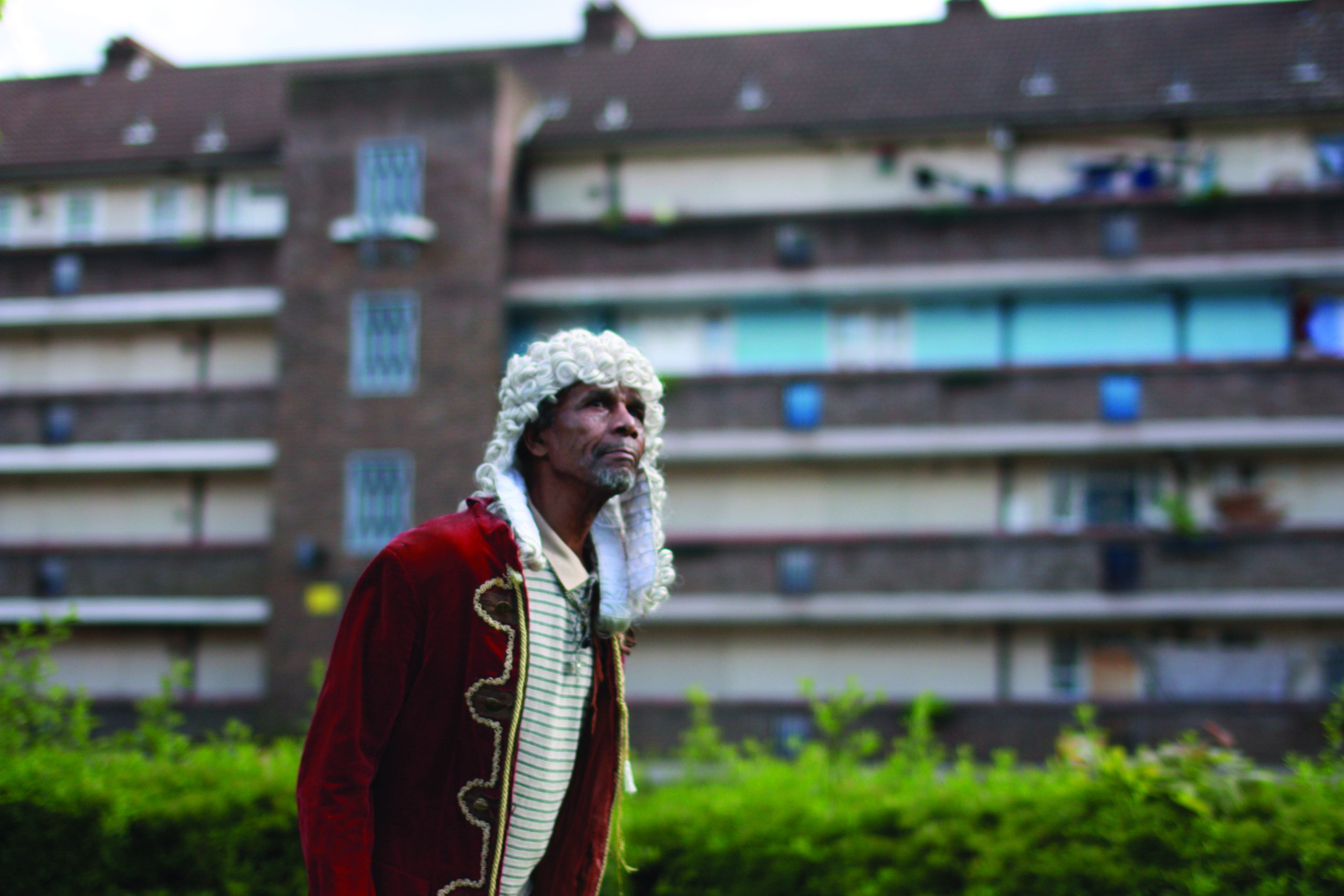
Estate, Fugitive Images
I had lived on the Haggerston estate in East London for most of my adult life and campaigned for many years alongside other residents to get the buildings repaired. Decades of neglect and intentional underfunding meant that they were in terrible condition. We were not successful in saving them and, once I knew that the estate would soon be demolished, I started filming.
It feels important to note that Estate has not been made ‘about’ this community but has been made ‘from’ it. Through a variety of filmic registers and strategies, the film seeks to capture the genuinely utopian quality of the last few years of the buildings’ existence, a period when, because demolition was inevitable, a refreshed sense of the possible, of the emergence of new, but of course time-specific, social and organisational relationships developed, alongside a revived understanding of how the residents might occupy the various built and open spaces of the estate.
Crucially, the film challenges what a documentary about housing might look like and be, even at this time of acute crisis within UK provision. I made a very conscious decision to move away from the statistical and expository towards a poetics of everyday life.
Estate focusses on the ‘structure’ of its eponymous architecture not only because it is where we lived, but also ‘how we lived.’ The film explores the multiple implications of what most explicitly defined us to other people, while simultaneously challenging that often all too monocultural definition and revealing the complexity and breadth of the population it housed. The film seeks to counter the many myths and clichés of our mainstream representation with a celebration of spirited existence and asks how we might resist being framed and objectified through externally imposed ideas towards class, gender, (dis)ability, economy and ethnicity, and even simply the building in which we sleep and wake.
Against Erasure of Difference
Taskafa, stories of the street (2013)
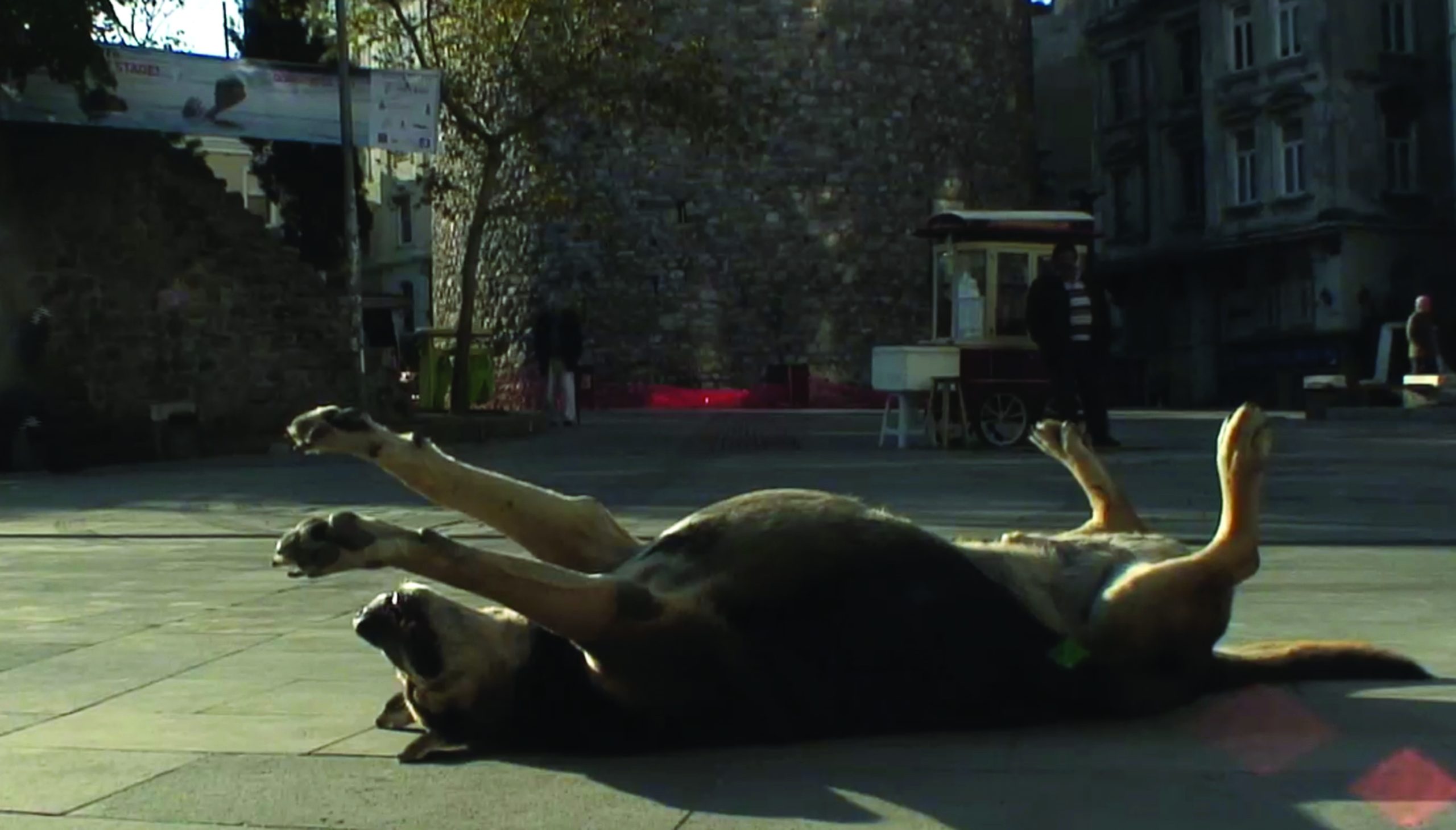
Taskafa, Andrea Luka Zimmerman
Taskafa (from the Turkish: stone-head, hard-headed) is a film about memory and the most necessary forms of belonging, both to a place and to history, through a search for the role played in the city by Istanbul’s street dogs and their relationship to its human populations. Through this exploration, the film opens a window on the contested relationship between power and the public / communities of the city. It challenges categorisation (in location and identity) and charts the ongoing struggle / resistance against a single way of seeing and being.
Despite several major attempts by Istanbul’s rulers, politicians and planners over the last 400 years to erase them, the city’s street dogs have persisted thanks to an enduring alliance with widespread civic communities and neighbourhoods, which recognise and defend their right to coexist.
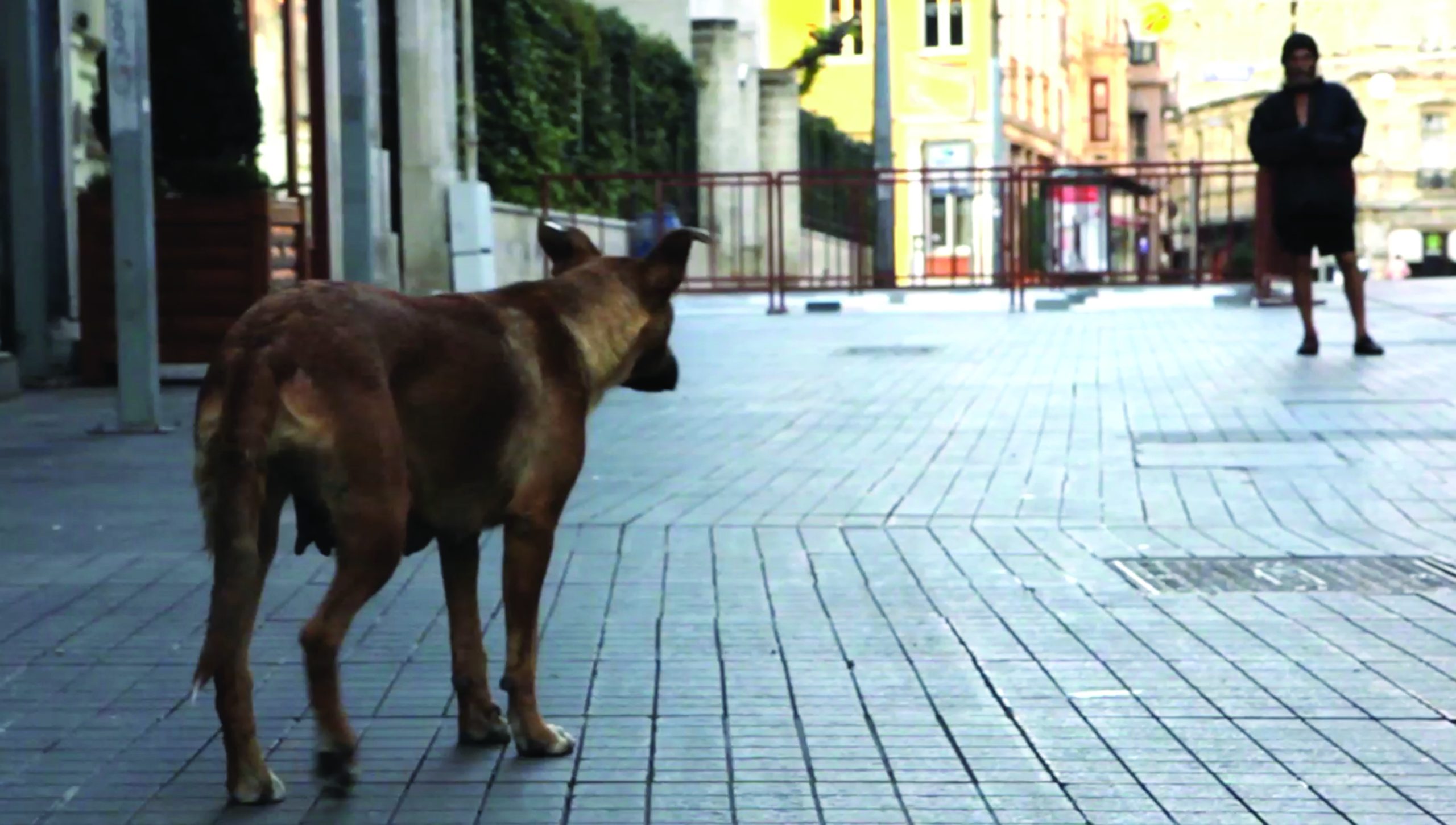
Taskafa, Andrea Luka Zimmerman

Taskafa, Andrea Luka Zimmerman
Taskafa gathers the voices of diverse Istanbul residents, shopkeepers and street-based workers, all of whom display a striking commitment to the well-being and future of the city’s street dogs (and cats), free of formal ownership but fed and cared for by numerous individuals. Navigating from the rapidly gentrifying city-centre district of Galata to the residential islands of the Sea of Marmara and beyond, Taskafa maps a history of empathy with, and threats to, these distinctive urban residents.
I had collaborated on the film with the late John Berger, whose novel King gave me the key to the story. King, a story of hope, dreams, love and struggle, is told from the perspective of a dog belonging to an economically and socially marginalised squatter community facing disappearance, even erasure. In Taskafa, this voice is gifted to a wider community and imbued with a range of perspectives: to dogs, a city and, finally, to history. Berger’s text and delivery accompany the viewer on a journey from Karaköy to Hayirsiz Ada, the island where, in the 1800s, tens of thousands of dogs were exiled to die.
Offering a moving collage of testimonials on the inestimable value of non-human populations to the emotional and psychological health of the city, together with a striking statement of witness to advocacy and persecution across the centuries, Taskafa both portrays, and embodies the spirit of protest and enduring solidarity on which it closes (with a mass demonstrations opposing the latest municipal proposals to clear the city of its street animals).
Taşkafa is not finally about dogs as such. It is about the way people seek to belong, still and ever more so now, to a larger context than themselves, one which respects other creatures and wishes them to play a significant role in their lives. The key issue is not whether we live securely, especially in its ‘official’ sense, but rather that we do not lose touch with the shared reality that surrounds us.
Against Erasure of Histories
Erase and Forget (2017)
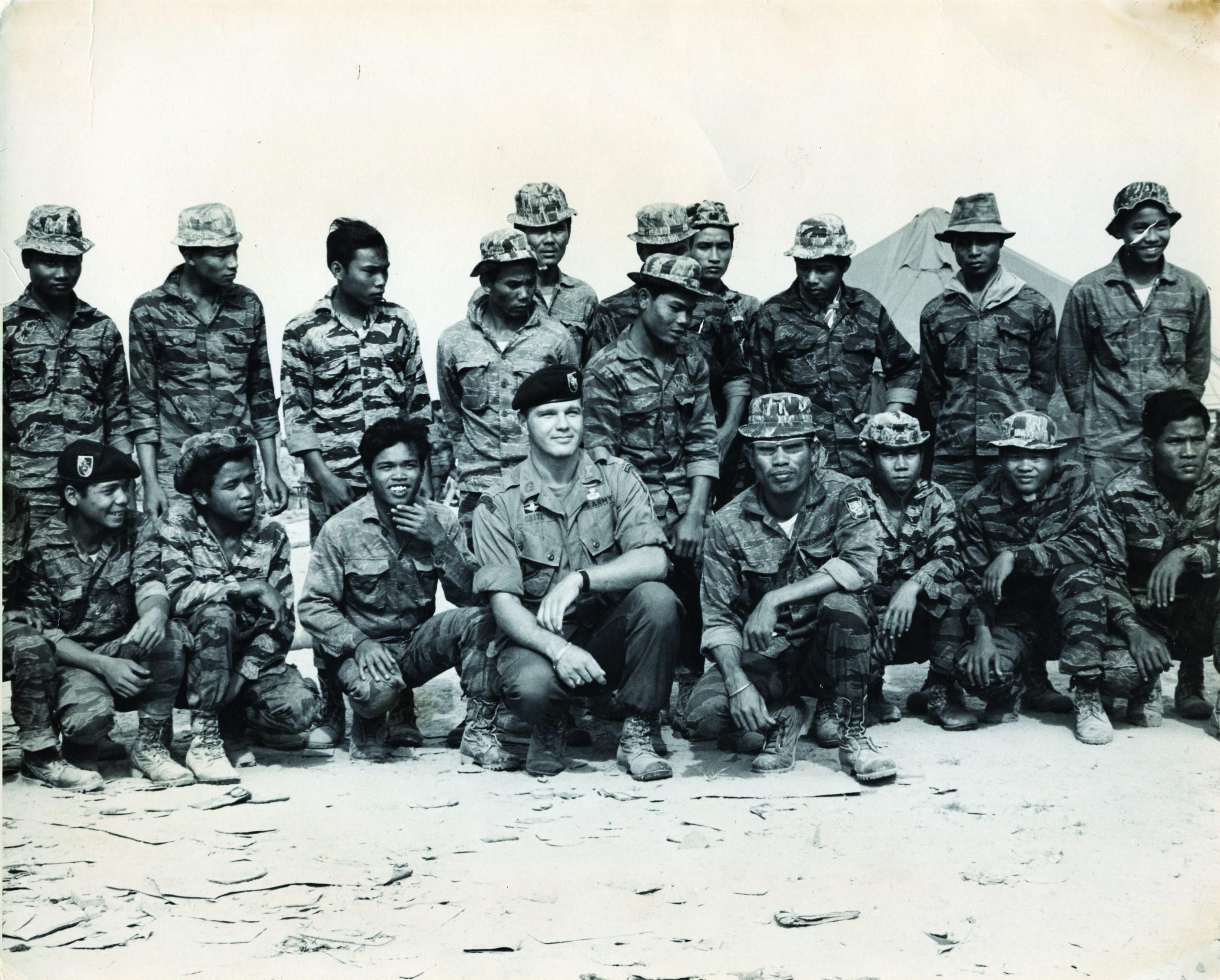
Erase. Courtesy of Bo Gritz
“You already know enough. So do I. It is not knowledge we lack. What is missing is the courage to understand what we know and to draw conclusions.” – Sven Lindqvist3
Lt. Col. James Gordon ‘Bo’ Gritz turned 80 this year. ‘The American Soldier’ for the Commander-in-Chief of the Vietnam War was at the heart of US military and foreign policy—both overt and covert—from the Bay of Pigs to Afghanistan. He was financed by Clint Eastwood and William Shatner (via Paramount Pictures) in exchange for the rights to tell his story. Their funding supported his ‘deniable’ missions searching for American POWs in Vietnam. He has exposed US government’s drug running, turning against the Washington elite as a result. He has stood for President, created a homeland community in the Idaho backlands and trained Americans in strategies of counter-insurgency against the incursions of their own government. What does it mean to have lived a life like this? Gritz’s life is a contested, contentious and very public one, unfolding glaringly in the media age. It is a life made from fragments, from different positions, both politically and in terms of their mediation.
Lights, Camera…
In Erase and Forget my interest is not merely in what ‘really happened,’ but in the actor’s historical becoming, the context of which remains contradictory, able to be assembled only from shards. My experiments with role-play, re-narration, re-enactment and the montage of ‘document’ and ‘fiction’ have been part of a methodological quest to find an expression that promises no immediate or direct access to historical truth, but whose processes articulate and analytically ‘perform’ the dramatic, narrative and generic conditions of the production of historical truth and its personnel.
It is a way of exploring relationships between image, memory and historical representation in a context—covert operations—where such explorations are fraught. It is therefore a film about films, the making of historical actors and ‘superheroes’ in order to justify an enemy. And, crucially, it investigates structures of concealment instead of invisibility, where a profound unmaking of the possibility of seeing with our own eyes is in operation.
The imbrications of Hollywood mythmaking and national policy formation reach back to the first half of the last century. It was not merely that Hollywood directors were seized by the hubristic urge to shape the extraordinary dreams and everyday opinions of the masses, but rather that figures within the administration actively sought to harness such hubris.
Here, fiction cinema offers an access point that allows for both the recovery of logistical detail and the plotting out of a historical mise-en-scene of which such details are elements. Fiction creates reality. Hollywood and political structures in the United States are tightly knit. On a material level, there are exchanges of personnel and funds. Hollywood regularly employs (often retired) covert operators and military staff as advisers, and the story rights of military operations often become the properties of major studios. Where the purchase of such rights is, by definition, often after the fact, on occasion funding precedes the event.
The flow of finance and support between Hollywood and the military is not unidirectional. The Pentagon contributes by providing army assistance (advisers, helicopters, use of bases, etc…) to productions that it deems supportive of US policy. Such films inform the climates of public opinion within which that policy operates. They open imaginative spaces and arenas of ethical consideration in which certain kinds of military operations are validated. Furthermore, Hollywood cinema serves as a curious, discursive space for policy makers (and thus for speechwriters as well as scriptwriters). Ronald Reagan, on numerous occasions, publicly drew on the Rambo series to articulate his foreign policy vision and configure his political aspirations.
…(Covert) Action!
Gritz was part of a world where deniability lies at the forefront of action on the uncertain line between knowing and unknowing. The spectral nature of covert operations lies in their being, officially, ‘neither confirmed, nor denied.’ Thus, the spectral is produced by official discourse, but admissible to it only as that which cannot be admitted. However, rather than a product of official denial, it is the outcome of ‘deniability’. This involves not the denial of a particular event but denying official authorisation of an event.
Dislocating action and intention, cause and effect, creates a shadow realm from which strategic operations march forward like zombies—an operation appears to have been carried out in the absence of an originating order. The action is spectral in as much as it seems to escape the laws of causality that govern the rest of the world—it is an effect without identifiable cause.
The spectral can be thought of as power’s penumbra - precisely an effect of the potential to ‘project power.’ Indeed, the potential for covert operations is variously publicised: covert operations are an acknowledged instrument of policy. Thus, spectrality is more an effect of an administration’s covert operations capability than of any particular operation. Thus, the spectral issues from the encounter between a highly publicised capability and the mechanics of deniability.
While any given mission may be invisible, the spectral threat of those missions is often broadcast in a spectacular fashion. The very visibility of Hollywood renditions of covert operations does nothing to diminish their spectrality. On the contrary, the spectral subsists in the spectacular: if it is the penumbra of power, it is also the shadow of the spectacle.
Covert operations are institutionally accepted as an essential instrument of government policy and today, of course, increasingly privatised. Thus, without the need to invoke shadowy conspiracies, the very machinery of democratic governance produces a host of spectres.
When an image (page 24) of Gritz and his Cambodian mercenaries who fought the ‘secret war’ in Laos was published in General Westmoreland’s memoirs A Soldier Reports (1976), Francis Ford Coppola, making Apocalypse Now (1979) (based on Joseph Conrad’s Heart of Darkness (1899) and narratively transplanted to the Vietnam War) asked for permission to use this image, with the intention that Marlon Brando’s (who played the renegade US Colonel, Kurtz) face be pasted over Gritz’s. This request was refused by the Department of the Army.4
In 1979, Gritz had given up his formal military career to prepare for his prisoner-of-war recovery mission, Operation Lazarus (1982-83). Lazarus was short of money, and this shortfall was collected from various sources. William Shatner, otherwise known for his role as Star Trek’s Captain Kirk, helped bridge the gap by providing US$10,000 in exchange for the rights “to tell his (Gritz’s) life story.” Clint Eastwood provided the remaining US$30,000 in return for an unofficial option on the story rights to the mission itself.
Thus, a future history was at once made possible and purchased. The story of prisoners of war brought home, or in other words, returned, through the initiative of one man operating beyond the law and without official sanction, was just the kind of patriotic tale of heroism and redemption that Hollywood was hungry for. However, a restaging of the mission (i.e. the Hollywood film) depended very much on an initial staging congruent with the conventions and dictates of its Hollywood paymaster.

Erase, Andrea Luka Zimmerman
Operation Lazarus generated sensationalised news coverage on all three major US networks, as well as triggered a campaign to discredit Gritz. He claimed he was prepared for the smears and suggested that his mission, at the highest levels, had a different ultimate objective: was not my idea. I got a letter. Perot admits General Tighe called me to conduct a covert mission into Laos. They thought that because I was Westmoreland’s soldier, if I say there aren’t any, then there was closure on this issue.” See also Gritz’s testimony before the Senate Select Committee Testimony & Depositions, November 23rd, 1992: General Eugene Tighe, Director, DIA, requested H. Ross Perot sponsor a private effort to determine whether or not any U.S. POWs were left alive. “Perot called me to his EDS, Dallas office in April 1979. He instructed me accordingly: ‘I want you to go over there and see everyone you have to see, do all the things you need to do. You come back and tell me there aren’t any American prisoners left alive. I don’t believe it and I’m not interested in bones.’”']“not to recover prisoners of war but to confirm their non-existence.”5 Effectively, what the administration wanted was a spectacular illustration of absence, and the high visibility of ‘nothingness’ was intended to banish the spectres of those supposedly still missing. So, having initially conjured the spectres as a means of prolonging the war and then as a means of negotiating the peace, the administration now wanted to banish those spectres through the spectacle of the covert operation.
Of course, the very notion of a spectacular covert operation is paradoxical. As is the fact that Gritz was chosen to lead the secret mission precisely because of his visibility. In the end, Gritz never returned with any prisoners, but each return was haunted by the spectre of prisoners that his very missions were involved in producing.
In the same period, William Casey (CIA Director during the Reagan years) brought in some of the country’s top public relations firms to advise him on how to sell his two pet projects—supporting the Contras in Nicaragua and the Afghan Mujahedeen—to a dubious American public. He called this “perception management.”6
Ronald Reagan, at the 1988 annual Republican Congress fundraising dinner said, “by the way, in a few weeks, a new film opens, Rambo III. You remember in the first movie Rambo took over a town. In the second, he single-handedly defeated several Communist armies, and now in the third Rambo film, they say he really gets tough. It almost makes me wish I could serve a third term.”7
There is another, rather less widely distributed film that stands as testimony to the Reagan government’s dedication to the ‘Gallant People of Afghanistan.’ Untitled and shot on Super 8 sound stock in the fall of 1986, it is the record of a ‘secret’ training programme for Afghan Mujahedeen on US soil.
Most of the training was carried out in a disused mine in Sandy Valley, not far from the small desert town in which Gritz was and remains resident. At one stage, the footage shows Gritz winding up a detonator cable leading to a huge plastic container-bomb that explodes in spectacular fashion. It leaves behind an enormous crater in the desert earth and is cause for enthusiastic cheering from a largely off-screen crowd. A little further into the reel, Gritz, presiding over a bucket of ball bearings, instructs his traditionally clad Afghan trainees in the making of homemade claymore mines. Explaining what will happen once the many ball bearings penetrate their targets, he makes the allusive suggestion to “just think of it as Hollywood.” These bomblets are baked in apple pie tins and then detonated in close proximity to human-shaped paper targets. After the explosion, Gritz inspects the targets and shouts triumphantly: “All the Commissars are damaged!”
After the post-9/11 US investigation of Afghanistan, editors at a local US news outlet, Channel 8, cut their bulletin item to footage of Rambo. The voiceover explains the unorthodox editing: “You’ve heard of the Hollywood Rambo, who ploughed the cinematic jungle of South East Asia looking for American POWs.” On screen, we see Rambo in a shooting frenzy, firing a 50mm cannon. Rambo shoots the gun from his hip, which is followed by a match-cut to Gritz shooting an even bigger gun, also from the hip. As Gritz shoots, the television voiceover continues: “We’ll meet the real deal, Bo Gritz.”8 The report then went on to reveal the American locale of the Afghan training.
Television conflates Gritz with the fictional Rambo in order to make sensational news. By conflating them, and thus sensationalising the covert, what Channel 8 does is to occlude the conditions by which Gritz’s Afghan training was made. Everything singular about this film is erased, including the terrible events from which it emerged. By producing Gritz as ‘the real deal,’ television produces the irrecoverable historical real (i.e. the past) as merely a parasitic supplement of fiction.
Spectacular realist fiction, then, precedes the events upon which it is ostensibly based. And this is something of an inevitability in a mass media environment which rehearses as well as scripts the conditions of sociability, namely those common fictions through which the world can be apprehended, those conventions that allow for a popular imagination to distance itself from the violence that underpins it.
The violence of Channel 8’s treatment of Gritz’s Afghan training film seeks to erase its detailed relationships with the past—the discursive conditions by which it can be received as evidence of something other than the spectacular performance of a fictionalised character. James ‘Bo’ Gritz becomes the ‘real’ Rambo, for the media (and to himself) because it serves the media precisely to be able to talk about ‘real life’; and it serves Gritz to reinvent himself as the ‘real deal,’ to suture himself into a mise-en-scene in which his own carefully collected documentation can be apprehended as evidence, and be celebrated as a hero. As Gritz says, “Why should I act like Hollywood when it is Hollywood’s job to act like me?”9
In summary, then, we can see how Reagan plots out his foreign policy imperatives along the trajectory of the Rambo franchise, which reciprocates by riding and intensifying the wave of euphoria generated by the apparent success of that foreign policy. There are interesting parallels between these public policy statements, the spectacular renditions of that policy’s effects, and Gritz’s own film record of one of the covert operations that embodied the policy’s strategic implementation. This record becomes an element in the public construction of Gritz’s character, used as it is in the local Channel 8 news report. This construction erases—precisely through violent spectacle—the actual violence of which Gritz was an agent. Gritz participates in this violence through the directorial relationship he forges between himself and Rambo as a fictional character, which finally entails reducing his utterances to fictional clichés.

Erase, courtesy of Bo Gritz
The word ‘secrete’ has two senses that appear to be in peculiar tension with one another: to exude, and to make secret. It is this peculiar tension that informs the relationship between spectacular representations of covert military operations in cinema and the spectral violence of the actual ‘theatres of operation.’ On the one hand, Hollywood is willing to create the conditions of possibility for covert operations so that it might then recover them in spectacular fashion. Shatner and Eastwood both funded covert missions with an eye to their future Hollywood renditions. In this sense, Hollywood has the capacity to secrete a spectral violence. But this secretion, in order that it might be successfully recovered as spectacle, must be secreted as secret. The covert operation must be ‘secret’ in order to be authentic. Here, then, the covert operation is pretext for, and projection of, its own spectacular re-enactment.
This process of secretion, however, is chiasmatic. The covert operation may, in some instances, secrete its own Hollywood creation (for example, Eastwood claims Gritz’s proposal was that he, Eastwood, stage a faux action movie production on the Thai-Laos border to serve as cover for Gritz’s mission). Here the spectral secretes the spectacular in order to make itself secret.10
It is this process of mutual secretion, of projection and reflection, that Erase and Forget aims analytically to perform. The insertion into a fictional scenario of a historical actor whose biography is purportedly the basis of that scenario’s script is a strategy that has yielded rich results. This mise-en-abyme strains the coherence of both the biographical and the fictional scripts, and in so doing, reveals the generic imperatives that guarantee these discourses’ very coherence.
Against Erasure of Relations
Here for Life (2019)
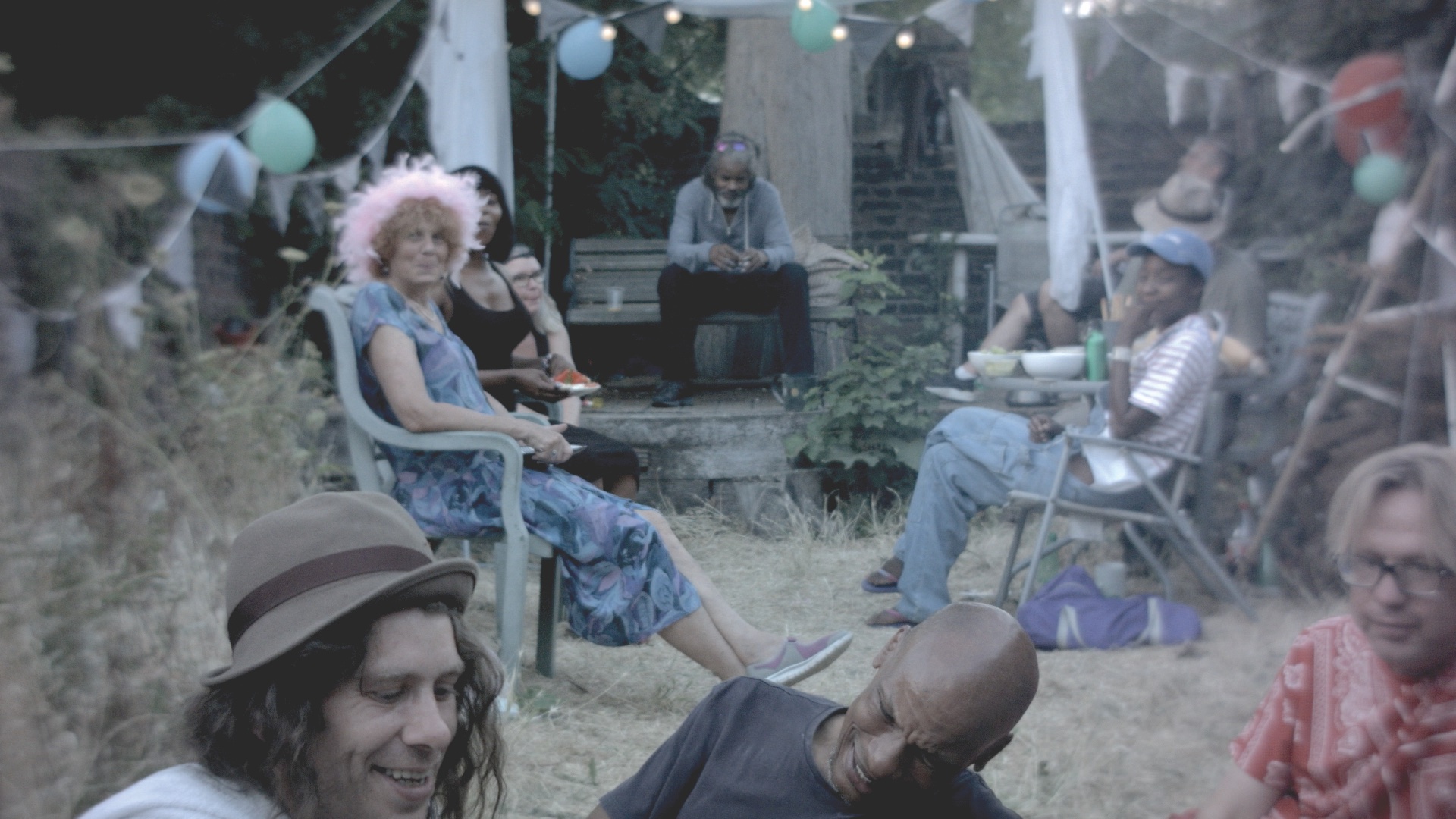
Here for Life, Zimmerman, Jackson, Artangel
A collaboration with Adrian Jackson, founder of Cardboard Citizens (a theatre company comprised of homeless and former homeless people, whose acting method is based on Augusto Boal’s Theatre of the Oppressed) and the performers, Here for Life, travels alongside 10 Londoners. All have lives shaped by loss and love, trauma and bravery, struggle and resistance. They grapple with a system that is inherently stacked against them.
They dance together, steal together, eat together; they agree and disagree, celebrate their differences and share their talents. They cycle, they play, they ride a horse. The lines between one person’s story and another’s performance are blurred and the borders between reality and fiction are porous.

Here for Life, Zimmerman, Jackson, Artangel
Eventually they come together on a makeshift stage in a place between two train tracks. They spark a debate about the world we live in, who has stolen what from whom, and how things might be fixed.
We felt it important to make this film now, with those who are engaged in a daily struggle with the structural violence of our society, as they are so readily exoticised, victimised and ‘othered’ in a number of different ways through widespread and repeated cultural tropes. We worked with our troupe over a long period of time in order to work through these issues, and to allow the participants agency over their stories. So, together, we explored what stories can be told, across and beyond difference and fixed ways of seeing and feeling. Perhaps most importantly, our film seeks a tenderness in this search, in both the making and expression.
I am a perennial observer, wishing to understand how images may be opened up to show us the richer variant meanings contained within them. Misconceptions about one another are largely structural, then internalised as if they were personal, inevitable traits or failings. It has so much to do with relatability. And misconceptions, of course, are shared across these intersections. This awareness played a significant role in our working with the troupe, and also with ourselves: starting from our own stories, what we share, and then how we might give life to another’s story without simply assimilating it into a dominant narrative.
Making a film with people always includes questions of (self) doubt / censorship (what we exclude because we see it from a particular position, fear, etc). This film is about storytelling in a literal as well as more associative sense, where the specifically situated, through rigorous examination and open telling, might speak to the ‘universal’, to the common ground.
For…
My intention in each work has been to create what I could call an activating metaphor; an image or concentration of form that is both actually itself undeniably in the world and also an energising metaphor of larger concerns. In Taskafa, it is the canine; in Estate, the building; in Erase and Forget, military conflict—both overt or covert—speaks to many other ruptures. And in Here for Life, the squatted performance ground holds and meets the marginalised bodies / lives of the film’s performers.
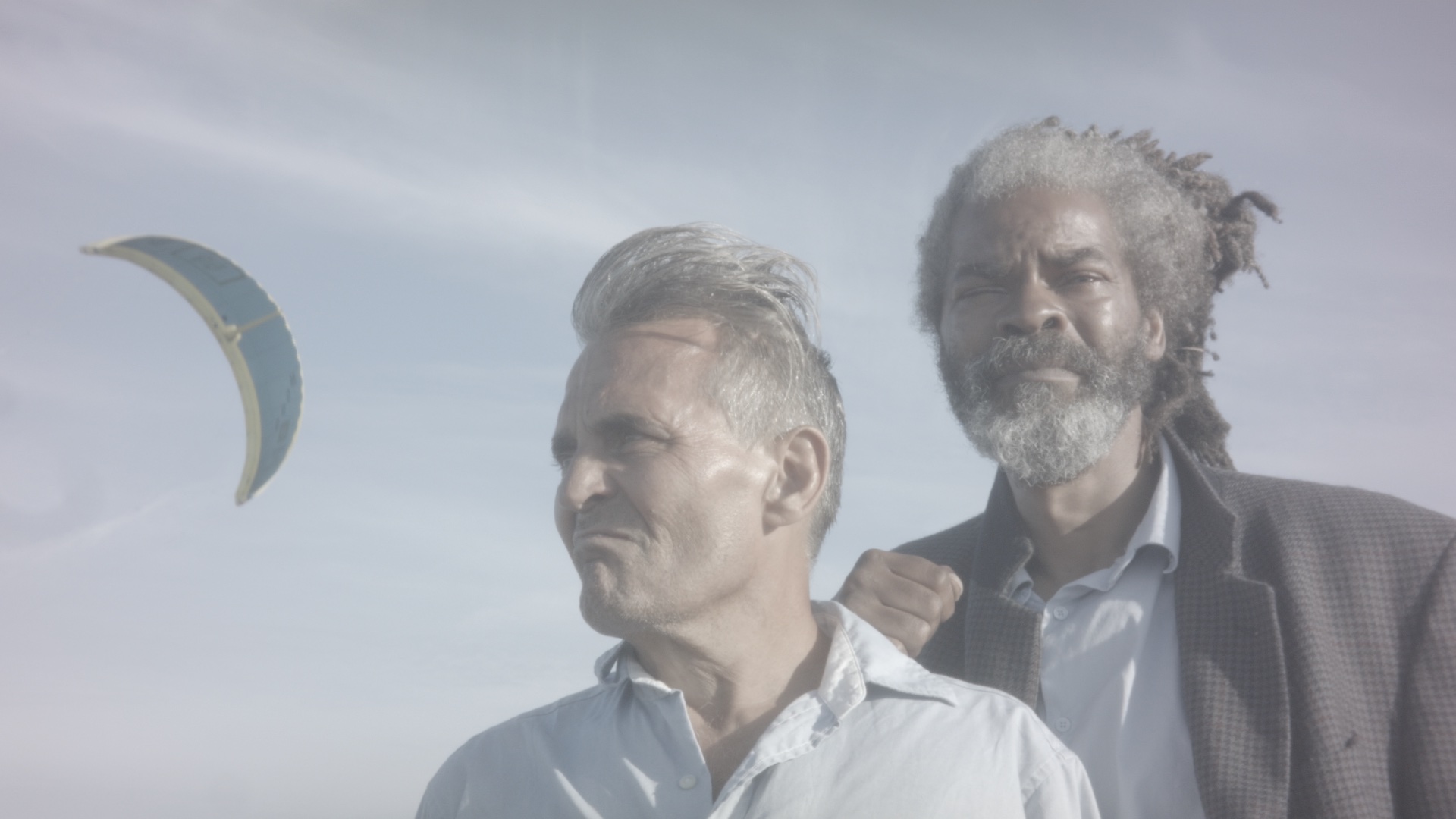
Here for Life, Zimmerman, Jackson, Artangel
I am informed here by what Angela Davis (and others) have observed about the need for new metaphors that convey the truth and lived experience of our times. She says, for example, for most women, people of colour and working-class citizens, it is much less about ‘hitting a glass ceiling’ in which reaching this far are the privilege of only those few, than it is about staying steady on a ‘collapsing floor.’ I am with those who are trying to stand.
Seen
In The Ones Who Walk Away from Omelas (1973), the late Ursula K. Le Guin tells of lives lived in a city of harmony, peace and happiness. When the citizens of this settlement learn that their peace is dependent upon the condition of one child kept in darkness and squalor, initial outrage is soon followed by a general forgetfulness of this suffering. However now knowing, and unable any longer to stay within the city’s wall, some choose to walk away. Le Guin writes that: “The place they go towards is a place even less imaginable to most of us than the city of happiness. I cannot describe it at all. It is possible it does not exist. But they seem to know where they are going, the ones who walk away...”11
*End Note
Three of the films surveyed offer perspectives from the ‘margins’, as it were, from people who live restricted lives within majority structures and find, by various means, ways of co-existing in frames more of their own making (even if temporary). In these terms, it might appear that Erase and Forget is a spectrum pole apart, a commentary from inside one version of that majority structure mentioned, and in this case arguably its apex, the ‘military-industrial complex.’ However, Gritz’s own experience of that machinery lie in closer proximity to the others than might first appear. The working-class son of a combat military family, with few employment options open to him, Gritz’s life (through his own experience and understanding of the workings of power) has turned an inherited class and economic marginalisation into a personal even philosophical one, and has led him to make his own forms of ‘home’, successfully or otherwise, in a variety of locations and scales, where the practice of a direct engagement with social need and aspiration has been as necessary as in the other cases.
Acknowledgements
My thoughts above emerge from many conversations, for Taskafa with John Berger, Gülen Güler and Bill McAllister; Estate with Lasse Johansson, David Roberts and Ruth Marie Tunkara; Erase and Forget with Michael Uwemedimo; Here for Life with Taina Galis, Therese Henningsen and Adrian Jackson. With gratitude to Gareth Evans for his invaluable contribution over many years to my thinking these things through.
Footnotes
1 Online Etymology Dictionary
2 A Man with Tousled Hair 176
3 Exterminate all the Brutes 2
4 Documents sourced by the author, 2006
5 Interview with author, 2003: “Soldier of Fortune puts out a special edition trying to show me as some kind of butt wipe. … [but the mission] was not my idea. I got a letter. Perot admits General Tighe called me to conduct a covert mission into Laos. They thought that because I was Westmoreland’s soldier, if I say there aren’t any, then there was closure on this issue.” See also Gritz’s testimony before the Senate Select Committee Testimony & Depositions, November 23rd, 1992: General Eugene Tighe, Director, DIA, requested H. Ross Perot sponsor a private effort to determine whether or not any U.S. POWs were left alive. “Perot called me to his EDS, Dallas office in April 1979. He instructed me accordingly: ‘I want you to go over there and see everyone you have to see, do all the things you need to do. You come back and tell me there aren’t any American prisoners left alive. I don’t believe it and I’m not interested in bones.’”
6 Cockburn, St. Clair 107
7 Reagan, Annual Republican Congressional Fundraising Dinner, 11 May 1988, USA
8 KLASTV
9 Interview with author, 2005
10 This notion of ‘historical secretion’ grew out of a conversation between Michael Uwemedimo, Josephine Mcdonagh and myself, 2005
11 Le Guin 284
References
Berger, John. “A Man with Tousled Hair,” The Shape of a Pocket. Vintage International, 2003.
Cockburn, Alexander and St. Clair, Jeffrey. Whiteout: The CIA, Drugs and the Press. VERSO, 1998.
KLASTV. Channel 8 Broadcast. 9 June 2002, USA.
Le Guin, Ursula K. “The Ones Who Walk Away from Omelas,” New Dimensions, vol. 3,1973.
Lindqvist, Sven. Exterminate all the Brutes. Granta books, 1992.
Online Etymology Dictionary, https://www.dictionary.com/browse/erase. Accessed 5 May 2019.
Reagan, R. Annual Republican Congressional Fundraising Dinner, 11 May 1988, USA.
Wolf (ed). New Perspectives on Peter Watkins: FUTURE REVOLUTIONS. PogoBooks #115, First Edition, 2018.
Filmography
Coppola, F., Apocalypse No. Omni Zoetrope, 1979. Film, 153 mins.
Zimmerman, A., Estate, a Reverie. Fugitive Images, 2015. Single channel HD Video, 83 mins.
Zimmerman, A., Erase and Forget, 2017. HD Video, 86 mins.
Zimmerman, A., Jackson, A., Here for Life. The Artangel Trust, 2019. HD Video, 90 mins.
Zimmerman, A., Taskafa, Stories of the Street. Yalan Dünya, 2013. HD Video, 66 mins.
Essays
Out, damned spot! out, I say!
One: two: why, then, ‘tis time to do’t.
Hell is murky! Fie, my lord, fie! a soldier, and afeard? What need we fear who knows it, when none can call our power to account?
Yet who would have thought the old man to have had so much blood in him.
Lady Macbeth1
Seeing spots can give one a sense of disarray especially if one is guilty of scheming someone’s disappearance. Spots have an illusionary quality, captivating in its preposition, yet stubborn in how they remain within our field of vision even after one has looked away. Since being introduced to literature in my teens and being somewhat a neurotic at school (I used to double check my daily actions), I have always resonated with the cautionary tale of Lady Macbeth’s ‘red-spotted’ hallucination: the washing of a pair of imaginary blood-stained hands, over and over again. In thinking about erasure in contemporary art, this example, one of obsession, madness and even possession comes to mind. For this preoccupation of the human condition to erase seems to arise from a general inclination for us to remove or correct an error, so as to make it better.
But we never know what ‘better’ is.
The Japanese artist Yayoi Kusama has spent a large part her life painting with dots as a metaphor to obliterate her anxieties. ‘Dots’ would fictitiously appear in her daily life and environment ‘filling up and taking over’ her real space.2 Kusama’s ‘apparition’ of dots is to do with an intense psychological inclination to ‘cover up’ negative and positive space so as to arrive at a new paradigm, one in which the dots ‘float like a caste net’. Whether there is a difference between spots and dots, I believe there is a correlation between Lady Macbeth and Kusama as both ‘see patterns’ due to their sense of trauma and anxiety. These recurring patterns seem like abstract translations of their own biological system of cell networks and particles at play. Both imagine these organisms as shapes that come to life either as bringers of anguish or that of relief. One is tormented and eager to remove them while the other sees them as a protective presence, able to calm and bring about a positive change of mind.
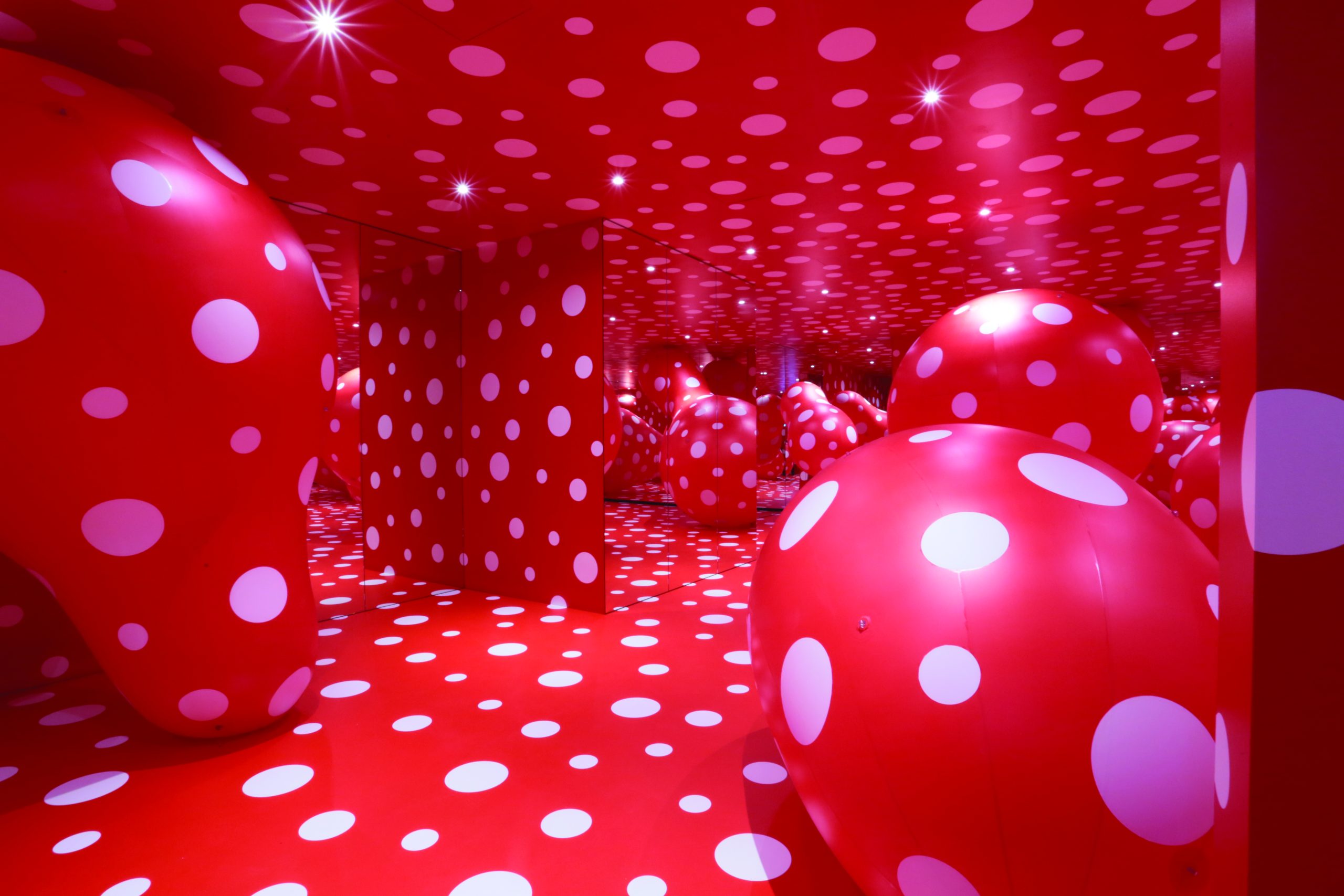
Yayoi Kusama
Dots Obsession
2015
Installation, mixed media. Installation view: Louisiana Museum of Modern Art, Humlebaek, Denmark
Photo: ©YAYOI KUSAMA. Courtesy of Ota Fine Arts, Tokyo / Singapore / Shanghai
As a young art student, I was told never to apply the colour red as an underpainting. The reason was because any tint that is subsequently applied on top of it would be affected by the warm intensity of its source. Red, once seen, is irreversible to the eye. The colour red appears frequently in Cy Twombly’s paintings. Works like The Ferragosta Paintings from the early 60s and Wilder Shores of Love 1985 tend to emerge as a scattered sprawl of paint, where doodle lines and smudges concur. Lines also appear as writing and can dissolve within a span of a single picture frame.3 Lines also appear as writing and can dissolve within a span of a single picture frame. The rubbing away of information or the covering up of it, make up an overall ‘impression’ of expressionistic debris. It’s as if the act of wiping out connects the distances between each element, resulting in a multiplicity of traces. A Twombly painting reveals parts of its former ‘existences’, some more stubborn than others. Representationally, the act of painting (with sticks, hands and rags) and erasing synthesises and romanticises the biological and psychological. In one moment, pigment can be sprinkled to suggest droplets of excrement and another, an implosion of circular smears as if plants were being caressed or stepped on. The example of red, whenever it appears as a hue, it is either left over from a vigorous application or seen as coming through a mist of white and greys, rubbed away or around by a slight of hand.
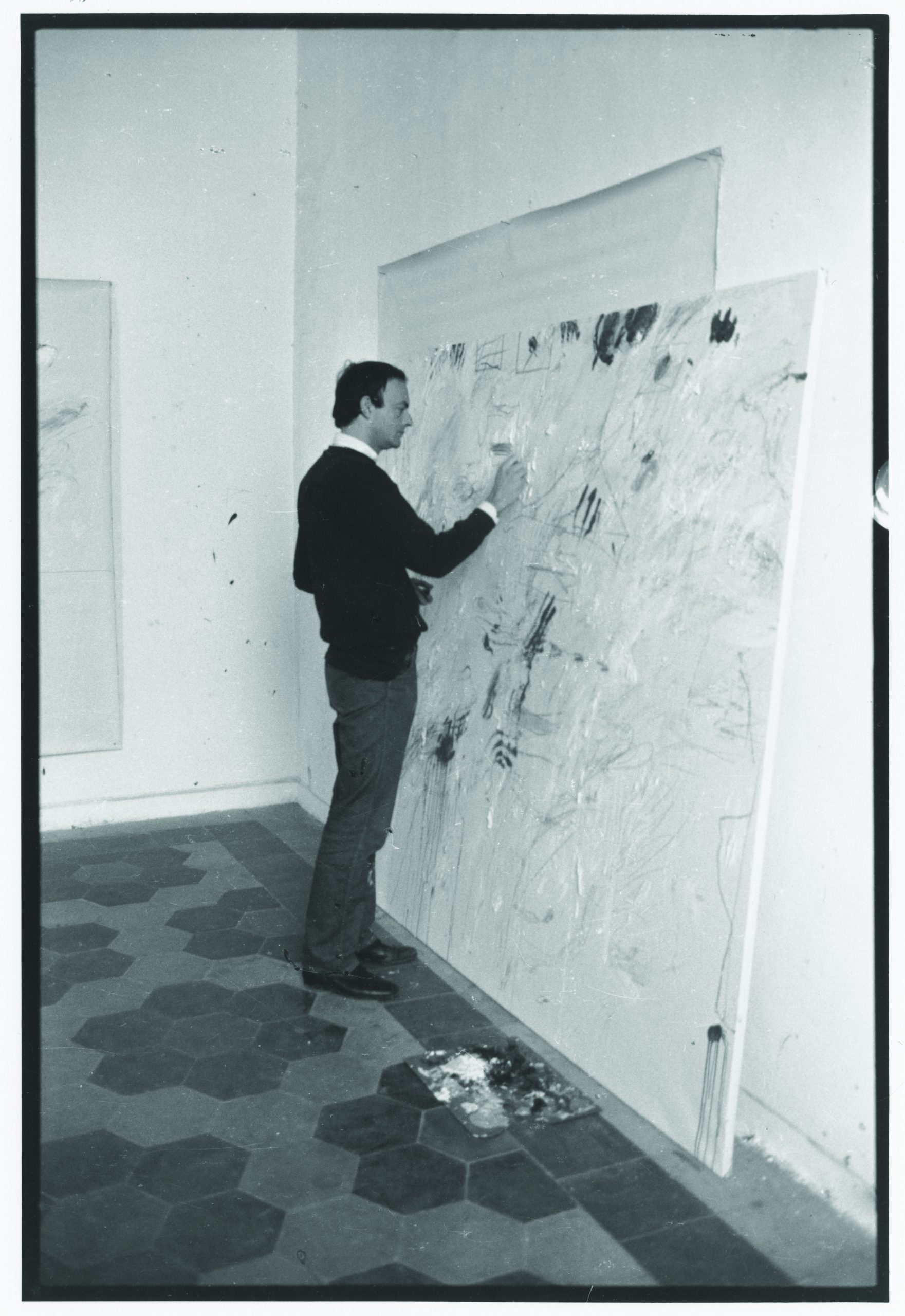
Cy Twombly nel suo studio a Roma, 1962
(Cy Twombly in the studio, Rome 1962)
Photo: ©Mario Dondero

Film screenshot of Notebook on Cities and Clothes (starring Yohji Yamamoto)
dir. Wim Wenders, 1989
Photo: ©Ian Woo
Yohji Yamamoto, who once related that he was not a fashion designer but a seamstress, started his career working on clothes by cutting its material to make shapes as a ‘covering and protection’ for the body. For Yamamoto, designing clothes was about looking for the right balance of the asymmetrical and the body.
What is this sense of balance?
In director Wim Wenders’ film documentary Notebook on Cities and Clothes, the protagonist Yamamoto is seen initialising the pillar of his new shop building in Tokyo.4 He signs the concrete surface with a piece of white chalk, stands at a distance and looks. Seeing that it is not ‘right’, he summons the assistant to rub it out while he has another go. The first attempt at signing is almost unnatural as he corrects the curves by drawing over the initial lines he made. The assistant rubs off the chalk with a wet rag in a combination of circular motions, then completes the task from left to right. One sees and experiences the name disappearing from first name to last name. This sequence occurs several times. We are given a glimpse into how when observing someone write, it engages within us opinions of character that are revealed both in handwriting and body language.
What was Yamamoto looking for while erasing his signature again and again? Throughout the repeated attempts, he ponders his last strike, an awkward pause followed by another probing stance. Perhaps it’s the scale of the signature, which is larger than the usual for signing a document. He goes over a clean slate—carte blanche—in short succession, like a sadistic punishment to himself for being so important. An attempt at making a human mark in response to the architecture of its time, performing the ‘perfect’ move so that his name gathers a sense of proportion while relinquishing an effortless dance.
The scene is tense, but why would it not be?
I first came across Brice Marden’s work at a drawing exhibition in London that was curated by the artist Michael Craig-Martin.5 The exhibition, entitled Drawing the Line, contained a work on paper that comprised Marden’s characteristic drawings of interweaving vine-like lines to form a vertical map. Upon closer examination, I saw white paint being used as a corrective material to hide lines that were of no use. It immediately gave me a sense of comfort to know that he made mistakes! The ‘correction’ later reconciled within me the importance of authenticity and ‘doubt’ in the field of art making. Cancelling and concealing with Tipp-Ex are customary methods used in modern-day office work. But in what spirit is it done? With grace or anguish? Marden develops his work in the former as it is with grace that he wilfully and delicately paints over lines and marks that he has drawn. In Marden’s painting, Cold Mountain 6 (Bridge), lines intertwine organically like branches of a plant bending, tilting, twirling to map its way in accordance to an improvisational force. The series of work which was influenced by the Tang Dynasty poetry of Han Shan, hints at calligraphic writing or a kind of structure that suggests the plotting of directions. Lines appear upfront, back and forth, shifting between the space of a picture.6 His initial process involves drawing a layer of lines, which he later paints over them in white. He then overlays a fresh layer of line drawings which move in completely different directions. The correlation of the two gives the painting an airy movement as if the past (covered) and the present, like the growing stages of a plant, are uncovered before us.
Christopher Wool’s paintings remind me of someone wiping off grease while some of the more elegant gestures seem like the repeated figure eights from an ice-skating ring. Usually, it’s fast, like a quick burst of energy released before you. The use of text figure dominantly in Wool’s work, but before any of it gets read, it is usually morphed by painterly disruption.7 Visually, one can see where the image of writing has been shifted and made to move. The paintings seem to be physically made with large movements as if the words did an abrupt exit from the edges of the canvas. Aesthetically, it’s the opposite of Marden’s slow dive. It is made out of black paint, without overlays, very direct, simple like punk music. The final product is less text than ‘all-over’ image, with the painting suggesting the appearance of an incident: an experience of media glitch, the image of sound, or a close-up snippet from a car chase from some black-and-white movie. The ‘erasure’ of a Wool painting is equivalent to the invisible pulse of a city—alive and in motion.
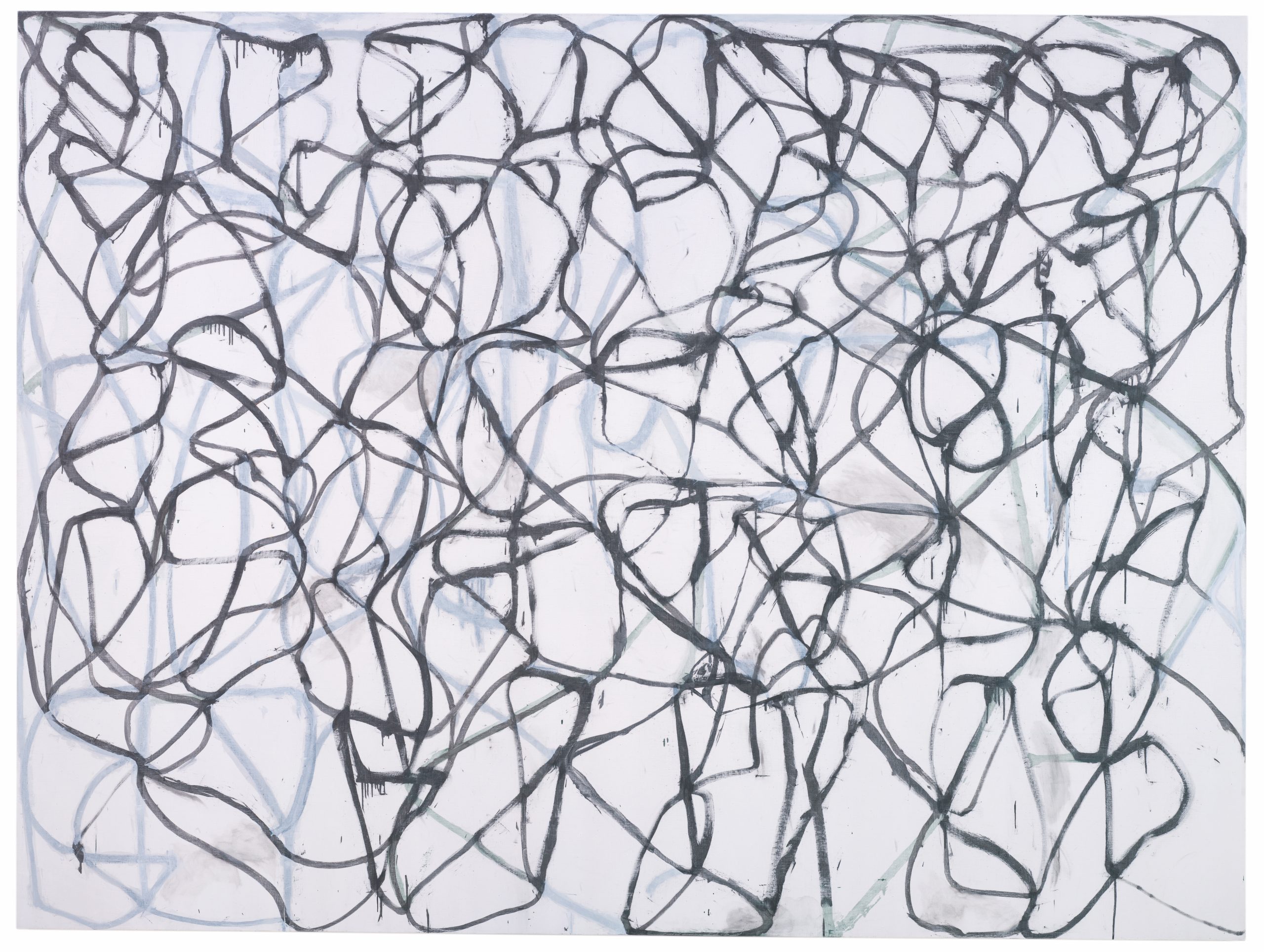
Brice Marden
Cold Mountain 6 (Bridge)
1989-1991
Oil on linen. 274.3 cm x 365.8 cm. San Francisco Museum of Modern Art
Purchased through a gift of Phyllis C. Wattis. Photo: ©2012 Brice Marden / Artists Rights Society (ARS), New York
I discovered 4’33” by composer John Cage and his book Silence when I was an undergraduate student in England. Both of these items dealt with some form of removal of memory, in this case, music as melody. He advocated, in his treatise, the rediscovery of an awareness for the sounds of the real world.8 As a piece of music, ‘4’33” was a three-movement score for any number of performers in which they are not to perform within the specified time and duration. In fact, I once ordered a CD of this particular piece from the now-defunct Tower Records and ended up in an hour-long debate with the sales person about why I should not buy this piece of ‘empty’ music. Since its inception, ‘4’33” has influenced generations of avant-garde contemporary musicians and composers. What it did was provoke an extreme gesture that there was no such thing as silence and that the element of sound, like a piece of found object in visual art, can be considered as real-time music. The idea was to merge the boundaries that govern our audio perception of the world. This provided a ‘passport’ that inspired many musicians to explore timbres and overtones, the extraneous sounds from instruments and the natural environment.
A composer whom I found interesting in his use of erasure in sound recordings from our environment as an instrument was Alvin Lucier. In his iconic music recording and performance of I am sitting in a room, he reads aloud the following self-reflexive text:
I am sitting in a room different from the one you are in now.
I am recording the sound of my speaking voice and I am going to play it back into the room again and again until the resonant frequencies of the room reinforce themselves so that any semblance of my speech, with perhaps the exception of rhythm, is destroyed.
What you will hear, then, are the natural resonant frequencies of the room articulated by speech.
I regard this activity not so much as a demonstration of a physical fact, but more as a way to smooth out any irregularities my speech might have.9
The reading of the above information was recorded and played back repeatedly, each time, gradually emphasising the sound of the frequency and acoustic timbre between the voice, room, microphone and tape machine. At some point, the audio information is no longer audible, but is instead replaced by a pulsing loop of cascading rhythms veering towards feedback. Here, there is a ‘taking over’ of the narrative data by a technological ‘ghost’ which is ‘captured’ by the methods of recording. The sound recording device as an apparatus is unlike that of a brush or rag for painting, but it is used to emphasise the phenomena of body and atmosphere. Abstraction as sonic form is the indeterminate cast, shaped and captured. Akin to the layered bleed of ink on a sheet of paper, erasure as a positive rather than negative activity has taken place. The speech of Lucier’s voice is another kind of ‘handwriting’, characterised by the tremor of the voice like the increments of a person’s handwriting.
My first son, Asher, keeps a sketchbook of animation illustrations. Recently, I found him using a piece of paper as a protective layer to absorb the bleed of the markers from infiltrating the rest of the papers. The resulting ‘protective material’ fascinated me. It was an image in which the history of his ‘decisions’ made from the entire sketchbook was captured to create its own animation. I related this to Lucier’s methods of recording where an element of distortion had been built up by a machine. The absorbent paper in this sketchbook was no different from the machine. The distribution and overlapping of ink marks and animated figures regathered to form a manga palimpsest. In addition to this discovery, it also resurfaced the use of negative information, or rather, support systems of art as ways to discover the ‘unknown’, or rather, ignored activities of the mind and body.

Asher Woo
Absorbent paper from Asher Woo’s Manga sketchbook
Marker on paper
29.7 cm x 21 cm
Photo: ©Ian Woo
In 100 Layers of Ink, Yang Jiechang uses the idea of the arbitrary task as a means to merge the concept of ink painting and Chinese history. The Chinese revolution had ‘put away’ the relevance of ink painting from her people.10 This relevance is the poetry of space and time which characterises the invention and awareness of poetic phenomena in early Chinese paintings. This ‘empty’ space as ambiguous perspective is also the basis for the development of abstraction in America, specifically in the works of Willem de Kooning and Robert Rauschenberg. In fact, Rauschenberg had famously ‘erased’ a drawing of de Kooning’s as a way to ‘find’ what was ‘left’ of it.11 Interestingly, Yang’s approach here is the opposite of subtracting. This is also due to the materiality of ink painting where liquid dries to reveal a state of being. Once ink is dried, it is irreversible. The only way is to layer on top, creating two or more illusions of space or matter depending on the context of what is being expressed. But essentially, Yang sees the act of overlapping in his painting as a form of reduction as found in his interview extract with Li Yu-Chieh:
Li: Is this a kind of addition?
Yang: Well, if you repeat this boring gesture every day, it becomes a means of reduction. I studied a technique fundamental to Song and Yuan dynasty painting in which colours and glue alum solution are applied repeatedly to achieve the saturation of colour: three layers of glue alum solution and nine layers of colour. For example, the red would be a bit transparent but it has many layers and differs greatly from when you apply it only once. 100 Layers of Ink employs a similar technique. Black became not just black; there is light in it.12
Saying that black has a form of light through his layering methods, Yang sees his approach as a way to create a kind of space. This space is complex as layers of the ink’s crystallisation is indeterminate, caused by the way the mineral of the ink dries over what has occurred before.
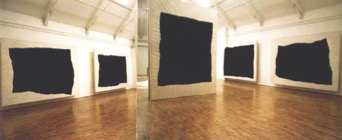
Yang Jiechang
100 Layers of Ink—Silent Energy
1992-1993
Set of 6 paintings, ink on xuan paper and gauze, 410 x 290 cm (each)
Installation view of Silent Energy, Museum of Modern Art Oxford, 1993
Photo: ©Yang Jiechang. Courtesy of Yang Jiechang
If we think that Yang’s use of ink is mystical and abstract, then another example of using the concept of appropriation as well as a similar layering of ink can be seen in Qiu Zhijie’s painting entitled Assignment No 1. Copying the Orchid Pavilion 1,000 Times (1990-95), a photographic documentation of the process of calligraphic learning and writing. Zhijie uses a poem composed in the fourth century by Wang Xizhi as a starting point to overlay the Chinese characters over each other 1000 times on the same sheet of paper to create an ancient and rudimentary form of time lapse.13 This performative act can be read as both a reflection and subversion of the Chinese literati tradition. In contrast to Yang’s pure black space, this work sees the build-up of writing in ink, smudged while morphing from information to material. A change, generating the concepts of learning and memory buried through repetition. Here, erasure as cancellation is an animated critique of a dissolving legacy.
The weight of history is one of the challenges every artist faces within the 21st-century climate of political instability and upheaval. The surreal and grim disappearance of the twin towers has become a key moment in contemporary history that marked how we should be wary of our cultural assumptions or the ways we communicate with each other. In Every Page of the Qur’an, Idris Khan scanned 1953 pages of the Qur’an using a version of his father’s book. It was an experiment suggested by his father, using technology and photography as a way to compress time and image. Khan was also, at the time, influenced by the writings of Roland Barthes and Susan Sontag, authors whose ideas commented on the methods and nature of image reproduction.14 In repeating and overlaying images and texts by digital scanning, a quality of depth develops similarly to the ways in which a computer is able to pick up details through pixilation. This develops into a dense overlay of stacked data, which at some point, begins to pick up the fissures and atmospherics of the image rather than the information. The process also disrupts the precision of the scanner’s eye, allowing the indeterminacy of layering to conjure up an x-ray version of a book that is ‘read simultaneously’ in time and space. This, together with the history of the Qur’an as subject-matter, provides the viewer with new insights into both the still life as a ‘sacred object’ and the ‘Word of God’ as a possible image. The superimposition brings together the new and old technology that celebrates the faith and currency of Islam.
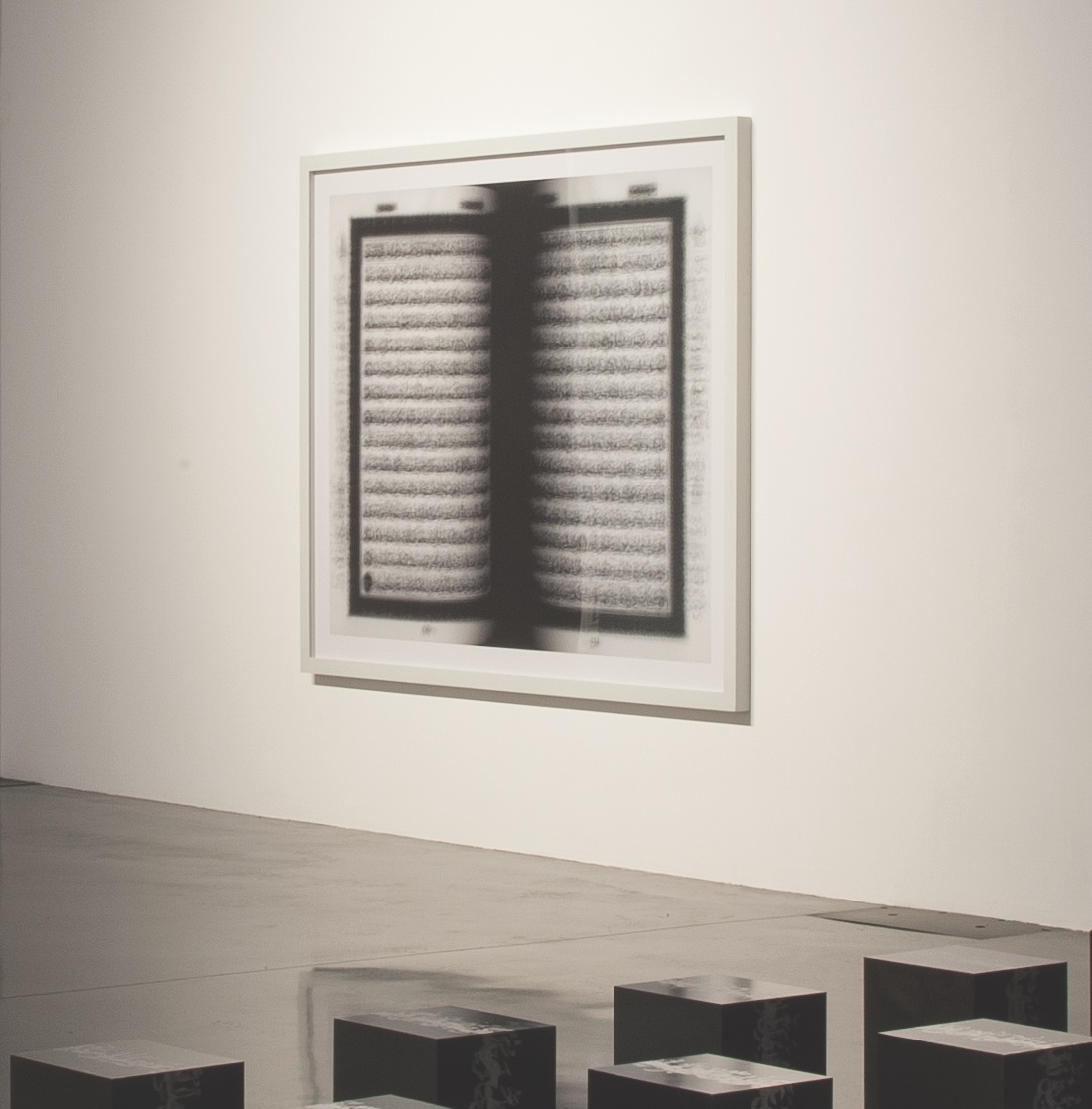
Idris Khan
Every... page of the Holy Qur’an, 2004
Lambda digital C-print mounted on aluminium, 136 cm x 170 cm
Installation view of A World Within, The New Art Gallery Walsall, 2017
Photo: Jonathan Shaw
When you start working everybody is in your studio—the past, your friends, enemies, the art world, and above all, your own ideas—all are there. But as you continue painting, they start leaving, one by one, and you are left completely alone. Then, if you are lucky, even you leave.
John Cage paraphrased by Philip Guston15
The above anecdote had stayed with me since graduate school. An idea like this was important especially for someone coming out of art school and going into the real world. Cage’s resonance about artistic vision, the courage to be different and that last line, “even you leave” is not for everyone. Taken in its entirety, it’s almost a religious calling for a life of dedication and service. Some would say this could be a rather dangerous thing. But it actually sounds rather positive, an encouragement that if you keep at it, you will find something. Here, erasure is seen in the practice of art as a gradual distancing from attachments and influences; to not be sentimental, to move ahead into the unknown.
To erase, whether by removal or building up, situates the eccentric man as of two minds in the search of new forms of communication. From text to speech, signs and symbols, erasure enhances the visual and sonic, heightening the ‘felt’ of the artist’s ‘personality’ trait. These forms of articulated sensibilities reach for ideas of existence that are complex, embracing the primal and intuitive while challenging accepted notions of the rational and proven world. To erase is to make unclear something that previously was or thought to be sufficient in its status. It is to highlight the ‘blur’ as memory, the appearance or disappearance of matter as encounter or visitation; a suspended moment in time to the observer or listener in question. Erasure situates and highlights the body and material world as phenomenological evidence of man’s decisions and actions. Erasure edits and essentialises to ‘discover’ itself.
Footnotes
1 Shakespeare, Macbeth, Act 5 Scene 1
2 Lamberg
3 Cullinan 89-109
4 Wenders
5 Craig-Martin
6 Richardson
7 “Typography: Christopher Wool.”
8 Cage 3
9 Lucier, I am sitting in a room, first recorded in 1969, and performed in 1970 at the Guggenheim Museum, New York
10 Periz
11 Cain
12 Post, MoMA
13 Koch
14 Benedictus
15 Coolidge 4
References
Benedictus, Leo. “ My Best Shot: Idris Khan.” The Guardian, 2 August 2007, https://www.theguardian.com/theguardian/2007/aug/02/arts. Accessed 6 June 2019.
Cage, John. Silence: Lectures and Writings by John Cage. Connecticut: Wesleyan University Press, 1961.
Cain, Abigail. “Why Robert Rauschenberg Erased a De Kooning,” Artsy, 14 July, 2017, https://www.artsy.net/article/artsy-editorial-robert-rauschenberg-erased-de-kooning. Accessed 8 June 2019.
Coolidge, Clark, ed. Philip Guston: Collected writings, lectures, and conversations. Berkeley, CA: University of California Press, 2011.
Craig-Martin, Michael. Drawing the Line: Reappraising Drawing Past and Present. London: Hayward Gallery, 1995.
Cullinan, Nicholas. “Abject Expressionism: The Ferragosto, Paintings.” Cy Twombly: Cycles and Seasons. London: Tate Publishing, 2008.
Jackman, Ian, ed. The Artist’s Mentor: Inspiration from the World’s Creative Minds. New York: Random House Reference, 25 March 2009.
Koch, Franziska. “Art and China after 1989: Theatre of the World.” ASAP Journal, 29 March 2018, http://asapjournal.com/art-and-china-after-1989-theatre-of-the-world-franziska-koch/. Accessed 8 June 2019.
Lamberg, Lynne. “Artist Describes How Art Saved Her Life.” News, 14 September 2017. https://psychnews.psychiatryonline.org/doi/10.1176/appi.pn.2017.9a21. Accessed 8 June 2019.
Li, Yu-Chieh, and Yang, Jiechang. “Action Painting is Not Calligraphy: A Conversation with Yang Jiechang.” Post, MoMA, 15 January 2016. https://post.at.moma.org/content_items/707-action-painting-is-not-calligraphy-a-conversation-with-yang-jiechang. Accessed 2 May 2019.
Lucier, Alvin. I Am Sitting In A Room. Lovely Music Ltd, 1981.
Richardson, Brenda. Brice Marden- Cold Mountain. New York: Dia Art Foundation, 1993.
Periz, Ingrid. “ ‘Art and China’s Revolution’: Art Society, New York, 5 January 2008 –11 January, 2009.” Eyeline, https://www.eyelinepublishing.com/eyeline-68/review/%E2%80%98art-and-china%E2%80%99s-revolution%E2%80%99. Accessed 8 June 2019.
Shakespeare, William. Macbeth. Act 5 Scene 1, edited by Thomas Marc Parrott. New York: American Book Co., 1904. Shakespeare Online. 10 August 2010, http://www.shakespeare-online.com/plays/macbeth_5_1.htm. Accessed 8 June 2019.
“Typography: Christopher Wool.” Hyde: Hypocrite Design Magazine, 24 October 2017, http://www.hypocritedesign.com/christopher-wool. Accessed 2 May 2019.
Filmography
Wenders, Wim. Notebook on Cities and Clothes starring Yohji Yamamoto. Road Movies Film produktion GmbH and Centre Georges Pompidou, 1989. 81:00 mins.
Essays
The Fact Remains
“It is not the literal past that rules us. It is images of the past.”
—George Steiner1
The installation Studio Visit (2012) by the Filipino artist Maria Taniguchi was composed a series of 24 plywood tablets on which the artist had etched notes, scribbles and sketches or diagrams from her diary of 2009-2010. The tablets included words and images that had been then crossed out, indicating what had been erased and rewritten. The work reveals the process of iteration, erasure and revision with all stages documented, if not shown, as part of the finished work. Crossed out, painted over, a trace nevertheless, of what had been marked, remained. The following year in 2013, the fellow Filipino artist Nilo Ilarde produced Erased Eraser, which was the result of rubbing 15 different erasers until their form disappeared. The residue was then “cast using resin, into the erasers’ original form.
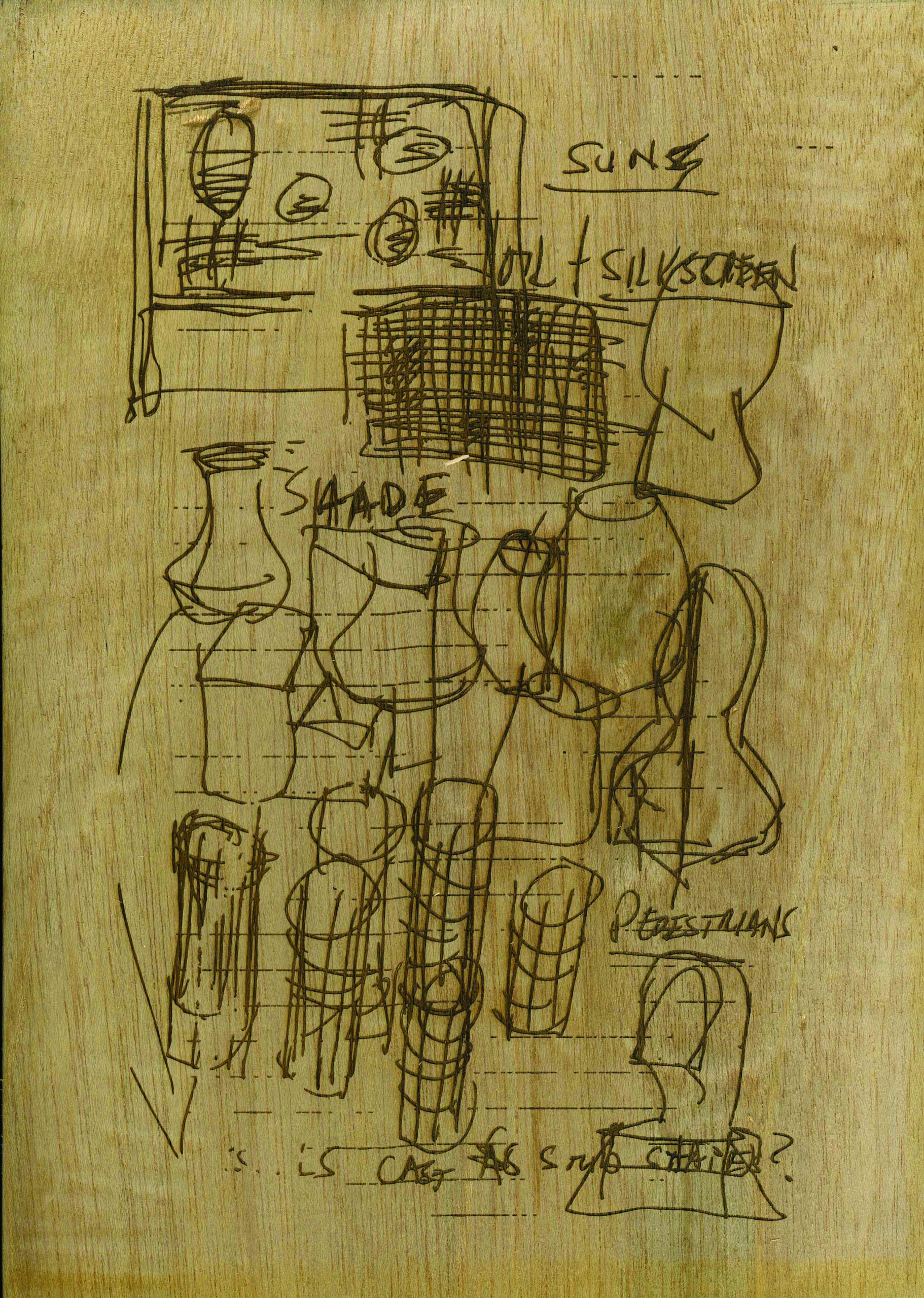
Maria Taniguchi
Studio Visit
2012
Laser etching on 24 plywood tablets
Dimensions variable
Photo: Silverlens and the Artist
Merewether, Charles. The Fact Remains. In ISSUE 08: Erase. Singapore: LASALLE College of the the Arts, 2019. pp. 47-57.
These two conceptual works raised the method of erasure as part of an artistic process of creating a new art work. In the following remarks, I wish to follow some historical use of erasure beginning with its modern origin with the discovery of rubber, the material first used for the eraser.
Rubber was an integral part of Asian and Latin American colonial economies, especially in countries such as Malaysia, Sri Lanka (Ceylon), Java or Brazil and Nicaragua. Ilya Ehrenburg’s novel traces this development of rubber during the colonial period.2 His novel The Life of the Automobile, published in 1929, is a story of rubber taken from Malaysia to Europe. It tells of a Frenchman who, on driving his new Citroën, experiences the modern thrill of speed, only to then crash his car in a fatal accident. The book jumps from the brutal North American intervention in Nicaragua seeking to secure rubber supplies for tire factories to wild gambling on Citroën in the Paris stock exchange. Ehrenburg writes:
There are no people at the stock exchange...There are only names and numbers, the lofty and tender names of three thousand securities. Royal Dutch, Rio Tinto, Malakka – oil, copper, rubber; names and numbers; numbers swarm, whirl, buzz, like locusts. Numbers decide everything here.3
The discovery of latex from rubber trees led to the invention of the rubber eraser in the 18th and 19th centuries. And, the invention of the rubber eraser changed the process of writing and reading of history in small but critical ways. This was long before fake news became a recurrent component of everyday life.
With the rubber eraser, someone could delete what they had written: a word, a text and as a consequence, the history accounted for in written books. That is, an event that had happened could be erased in the re-writing of history. Nevertheless, sometimes, there were and are conflicting accounts in what has been documented in image or written form or recalled verbally. This raised the issue of competing evidence and what might be claimed as more substantive in its claim to truthfulness. And yet, as I wish to show in this essay, there is an indelible difference between an event and its account whether in writing, image or another form and how the event might be ‘re’-presented.
In the editorial proposal brief for this ISSUE 08: Erase, a somewhat benign interpretation of the topic is used to characterise the use of erasure in the visual arts. In the introduction for this ISSUE 08: Erase, the editor writes:
In visual art, to erase is a method of consistently bringing to light a new perspective or dimension. In art, distancing oneself from the need to erase (to forget), is pertinent in unleashing ways of imagining the world and bringing to the forefront ideas deeply buried in the human conscience.4
For sure, erasure can open the way to new spaces in imagining the world. However, forgetting as a form of erasure, is also a necessary part of how memory works, enabling the distancing of oneself from remembered painful or unhappy incidents and, in the process, opening up new spaces for new experiences. In such a way, it can allow for a new perspective on history or events that have occurred. But, equally, the ‘conscious’ erasure of what has actually passed is another dimension of this process of forgetting. This does not happen as a natural process of memory but is the calculated, if not wilful, act of eradicating something. It is not simply to conceal or obscure but to eradicate it as if it never happened.
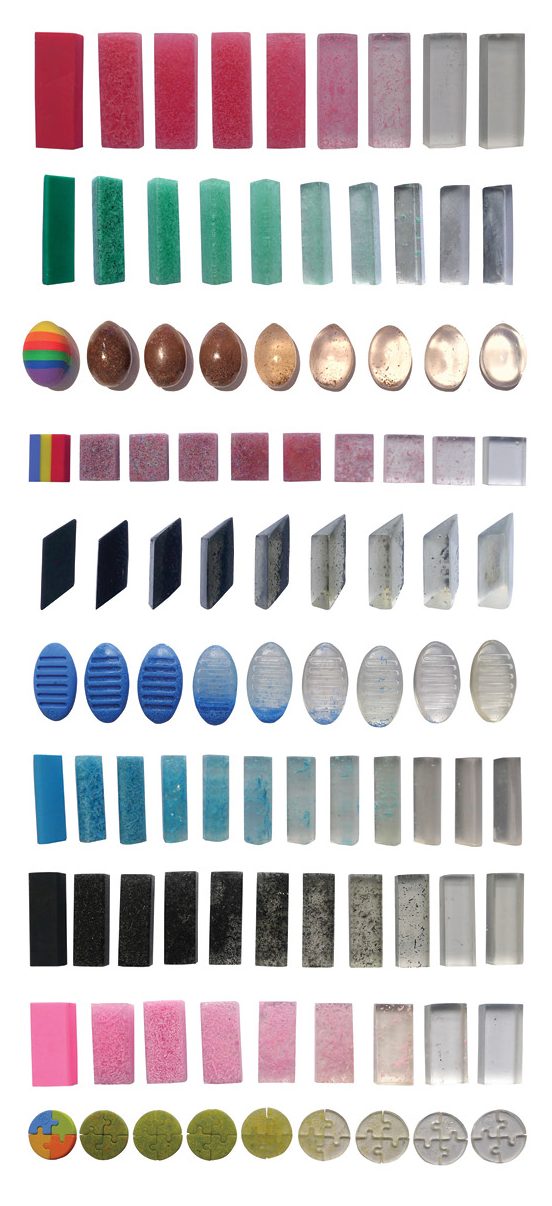
Nilo Ilarde
Erased, Eraser 1–13
2015
Eraser, eraser dust, resin
Variable dimensions
Photo: MO_Space and Nilo Ilarde
The Event, Trace and Evidence
I tell of two studies that characterise well this gap between an event and evidence. In 1993, Chris Marker made a film The Last Bolshevik (Le Tombeau d’Alexandre) in which he explores the great Soviet filmmaker Aleksandr Medvedkin. In it he shows a famous photograph of the storming of the winter palace at the time of the Bolshevik-led revolution in 1917. However, Marker reveals that, in fact, the photograph was that of a 1920 theatrical celebration of the event in 1917.5 Bearing an uncanny resemblance to the original event, it had come to serve as a document and hence an archival record of the event. To the degree to which the photograph in fact documented a theatrical re-enactment not only stood as testament to the veracity of the re-enactment but, more broadly, to the power of the photographic image to assume the authority of the originating referent. This instance provides a key to Chris Marker’s sceptical view towards the photographic document and its tacit claim of authority as regards to the real. Moreover, once this is claim had been disrupted, the character and claims of the archive as proof of an original event began to be contested.
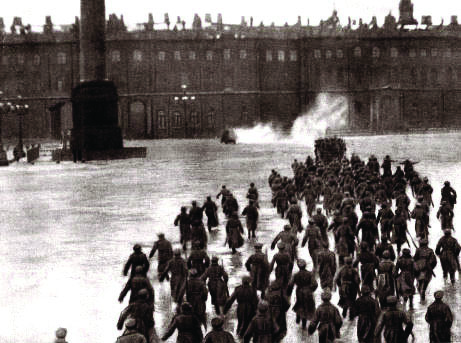
The storming of the winter palace 1917
Staged re-enactment in 1920
Public Domain, https://commons.wikimedia.org/w/index.php?curid=1030309
The second study was by David King who explored in his book The Commissar Vanishes, what had taken place under Stalin in the Soviet Union. King found photographic records documenting public events and leaders of the revolution. Often the same event had been photographed twice or more. But, in comparing photographs, King found systematic changes in which individuals had been erased from the photograph. He shows for example group photographs of Lenin with Trotsky or Lev Kamenev (a leading member of the Bolsheviks), and then those photographs again in which Trotsky and Kamenev have been erased, as if they were never there! The Cambridge English dictionary has an apt characterisation of this technique of ‘airbrushing’: “It is almost as if revolutionary leaders have been airbrushed out of history.”6 This method was a way of re-writing history so as to erase and bury what had taken place as an event or of people who were no longer in favour.
In her 1967 essay, Hannah Arendt issued a warning:
The chances of factual truth surviving the onslaught of power are very slim indeed; it is always in danger of being manoeuvred out of the world not only for a time but, potentially, forever. Facts and events are infinitely more fragile things than axioms, discoveries, theories—even the most wildly speculative ones—produced by the human mind; they occur in the field of the ever-changing affairs of men, in whose flux there is nothing more permanent than the admittedly relative permanence of the human mind’s structure. Once they are lost, no rational effort will ever bring them back.7
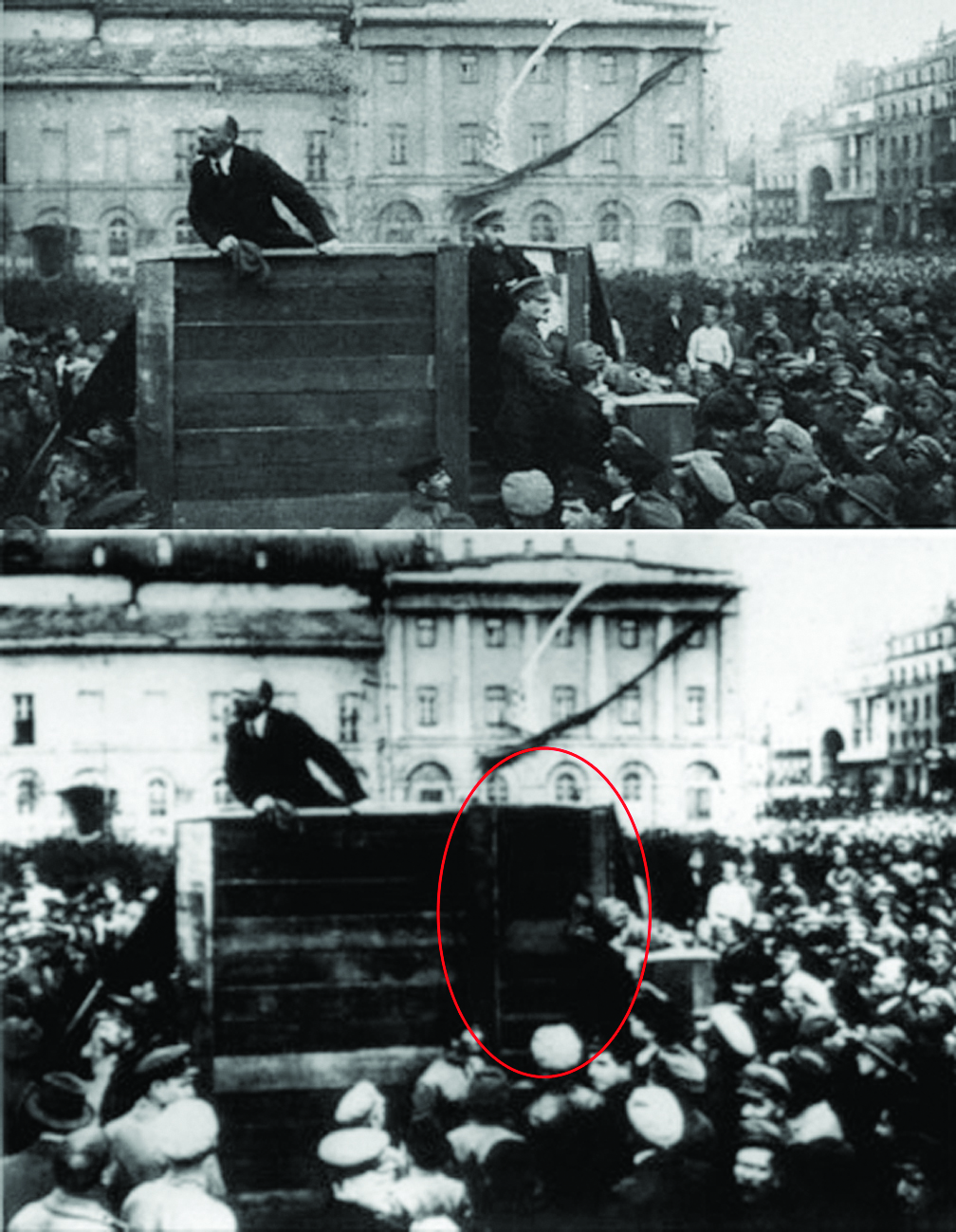
TOP
Vladimir Lenin speaking in Moscow to Red Army soldiers
departing for the Polish front, in 1920. Leon Trotsky and
Lev Borisovich Kamenev, behind, are on the steps to the right.
Collection of Tate. Photo: G. P. Goldstein.
BOTTOM
Leon Trotsky and Lev Borisovich Kamenev have been
airbrushed out of an image of the same scene.
Collection of Tate. Photo: G. P. Goldstein.
Arendt’s reflections are apposite to the instrumental way that photography or film and video began to be used in the documentation of events. The mediums had been used as material evidence that allowed a viewer to visually know and reconstruct or recall an event. However, to view the event in such terms is to suggest that a material memory or trace to do with the past survives in the present, a materiality that can be identified. Is the trace therefore something residual: a remainder that survives, like a fragment? In allowing us to look back, the trace offers a connection to the world insofar as it operates as a memorial form tied to the past but, forever threatened by forgetfulness and erasure. Or, is the trace alternatively, something less, insofar as its appearance is not a matter of survival but, rather more like the hollowed-out imprint of an impression: a past that has never been present? This would be a past which no memory, no-‘thing’ could resurrect, capture, represent as present. This paradox then is that the trace becomes a past that has never been present, that is always under the sign—if it can be called a sign—of erasure. And, yet, if the trace becomes something both less and more than the originating referent, does this not, in some manner, split the figure of the trace.
How do we delimit the trace except by what is inscribed, in effect, through the disappearance of what we may infer produced it? Appearance is constituted by the erasure of such marks. It is not a sign insofar as it is purely indicative or stands in an empirical relation to an event or something once present. There is nothing residual here—no fragments, ruins, marks or evidence—so it does not seek (by way of pathos or nostalgia) an originating moment. In these terms, the past cannot be made present, brought back, resurrected or redeemed. It is past.
The space between the event and evidence of it having occurred, is problematic insofar as a trace can never be the original to which it refers. Rather, the trace is founded within a movement of erasure: an erasure because it is only a shadow or imprint of the impression made. It is constituted through erasure and division. Jacques Derrida refers to the trace as a “still-living mark on the substrate, a surface, a place of origin.”8 Taken in this way the trace no longer finds itself imprisoned within the confines of presence and absence, but is instead conditioned by its movement of repetition and difference. We might say that the work appears to gather its meaning by way of an estranged relation to itself. By neither repeating nor returning us to the place of origin, the index opens up an interval that is discontinuous with what has gone before. This is not a work of nostalgia, a re/turning as if symbolising an experience of loss and desire to recapture the past or an identity of self through an origin. Rather, it marks a space between impression and imprint, neither present nor absent insofar as there is no plenitude either given or referred to as elsewhere. There is here the sense of an aporia, a hollowing out, an encounter with the outside of the self, its exteriority. The encounter with the outside of the self is the self’s origin.
“I mark(s) first of all a division in what will have been able to appear in the beginning.” —Jacques Derrida9
To think the trace in these two ways, is to pursue its trail either back or forward, to see it alternatively, as either attachment or detachment, re-presentation or erasure, proximity or distance, a return or a leave-taking. It is at once bound by the past and open to the future, because it remains to be seen—can only be seen and therefore understood—after the fact. Falling on either side of this divide, the trace either informs and shapes the future by virtue of its ties to the past and yet, bound by the future, always coming after, opening onto a horizon that exceeds its referent. Such a trace would tear itself apart, dividing itself in order to break all attachment. We are now at the place that exceeds the horizon from where we started, a promise of elsewhere, an emancipation. Perhaps, this is what the editor of ISSUE meant when he referred to erase’s power to “unleash(ing) ways of imagining the world and bringing to the forefront ideas deeply buried in the human conscience.”10
Tracing the Event
Let me pick up again my comments about the Event and its definition in the light of the split condition of the trace. That is, to take as a starting point, the incommensurability between ‘eventhood’ and the meaning or significance of the event. This incommensurability between origin and repetition in the artwork need not lead us to declare, or even commiserate about, the impossibility of telling history. Rather, in locating the anachronism between the temporality of the event and that of our writing, we may say there is a form of excess in both the event and its re-presentation. This recognition of the incommensurate – of what has been called a diachronic temporality—enables us to recognise the other through an exposure to the wound within history: the trauma that both disturbs and is revealed through narration, exceeding restitution and forgetting. The artist or historian is exposed, and in turn exposes the reader, to the trace as an encounter between the impression and imprint, and to the formation of a historical and textual unconscious that haunts the present.
The historian Carlo Ginzburg, in his essay, Clues: Roots of an Evidential Paradigm, observed that art history belongs to a family of conjectural sciences that emerged in the late 19th century. He explored how the discipline of art history was like forensic medicine (criminology), philology or psychoanalysis, originally structured around a reading of material traces, such as tracks and fingerprints, which provided evidence of the originating event, scene or person involved. Traces, in other words, were viewed as bearing us or, at least, providing a means of leading us back to the source. Experts could map and differentiate the epistemological evidence that could establish the originating event or author of the case.
While this constitutes a story of origins in itself, it led to the emergence of a discipline (art history) that looked upon art as the shimmering ‘afterlife’ or nachleben of the past. Seen within the present, art represents the survival and transmission of the past, carrying with it traces of another place, time and culture. Art history became a trail leading us back to that inaugural moment in which the object or event comes into existence, itself a form of trace constituted in its separation from the artist and from the culture in which it originates. This is what gives the writings of art historians, such as Aby Warburg or Michael Baxandall, an almost elegiac quality in their prose. It is as if they discover, in the process of their writing, that the very language they use as a means to preserve the object and bring its past to life, is implicated in the loss of that object and its original meaning.
The trace would be like a fleeting shadow doomed by its fatal attachment to something that is irretrievably lost and therefore the subject of mourning or melancholy. The art historian’s practice becomes a redemptive project. They immerse themselves in the archive, seeking to revive the voices and the gazes that stare back at them. Such an approach is reminiscent of the work of the great 19th-century French historian Jules Michelet and his desire to ‘exhume’ the figures of the past for a ‘second life.’ Entering the ‘catacombs’ of manuscripts he noted: “I am not slow to discern in the midst of the apparent silence of the galleries, a movement and murmur which were not those of death.”11
I turn to Sigmund Freud’s Delusions and Dreams in Jensen’s ‘Gradiva’ (1961), an essay that concerns Wilhelm Jensen’s novel Gradiva: A Pompeiian Fancy, written in 1903, about a young archaeologist, Norbert Hanold. Jensen describes Hanold’s consuming passion for a relief of the figure of Gradiva in a museum of antiquities in Rome. While Gradiva serves as an emblem of archaeology, she is equally representative of art history’s relation to the trace. As a consequence, he journeys to the ruined city of Pompeii in search of a bas-relief of the figure at its original site. The presence of Gradiva, Hanold believes, is to be found in the imprint of her footsteps in the ashes of Pompeii. In this way, he hopes to be able to find her traces, and dreams of bringing Gradiva back to life, overcoming the discipline of archaeology, which he views as something conditioned by following the footsteps of the dead.
The trace as it remains, however, is only a trace, everything and nothing, the discovery of which provides no rest for Hanold. His desire for Gradiva does not abate. Her traces seem rather to induce an even greater obsession and Hanold becomes haunted and driven to insanity. For Freud, Jensen’s story concerns the idea of the past being, in some way, still present, as though locked up inside the present.
Freud wants the stones to speak, as if behind the trace there is a footstep to be found. No less than Hanold, Freud wants to recover a full presence, to bring the repressed into the light. Both are driven by a desire to trace the archive back to its inaugural moment just prior to the separation of origin and representation: an irreplaceable and unique moment of truth before its repetition and loss of originality. In this manner, the stories told by Freud and Jensen serve as parables about archaeology and psychoanalysis, where both are defined by the search for a repository that would constitute an ‘origin’, but an origin that can only be traced by the traces themselves.
For Freud, archaeology could provide a way of thinking through the very concept of memory and the unconscious, and art—like writing—like the archive—represented a prosthetic aid to memory. Later, Freud wrote in his essay A Note upon the Mystic Writing Pad (1924–25) that “all forms of auxiliary apparatus which we have invented for the improvement or intensification of our sensory functions are built on the same model as the sense organs themselves or portions of them . . .”12 To illustrate this, Freud used the bloc magique, a popular children’s toy made of a wax surface covered by a sheet of cellophane. When marked, an impression is left on the surface, and when the cellophane is lifted the impression disappears, although it leaves an invisible trace in the wax itself. In his way the toy provides both “an ever-ready receptive surface and permanent traces of the notes that have been made upon it.”13 These traces are not overtly present but, nonetheless, flicker beneath our consciousness.
In his book on Freud and the archive, Jacques Derrida suggested that Freud too was caught up in this pursuit of an originary moment.14 Derrida’s purpose in revisiting this story is to show the way repression and the archive are intertwined. Repression is, he argues, a form of archivation. Traces come after the fact and this evidence is a trace of the event, serving as a document and material for the making of an archive. In this context, traces were not simply signs and clues, but the residual remains, the material evidence and stuff of history.
Moreover, as Derrida argues, the archive, like the trace, is itself divided or disturbed by this repression that lies at its constitutive heart. For Derrida, we never can or do stand before the arche or origin, but are delivered over to the trace, assigned to one archive or another, to one inside another, en abime. He suggests that Hanold recognises that the trace exceeds both its origins and the archive. It is the trace of Gradiva that has taken him to Pompeii, seeking the uniqueness of her impression, of her traces. As Freud writes: “traces in the literal sense; for with her peculiar gait she must have left behind an imprint of her toes in the ashes distinct form all the rest.”15 It is a recognition that the uniqueness is to be found there in the imprint, in this moment of division, its repetition as a trace that comes after and therefore effaces what came before: Gradiva.
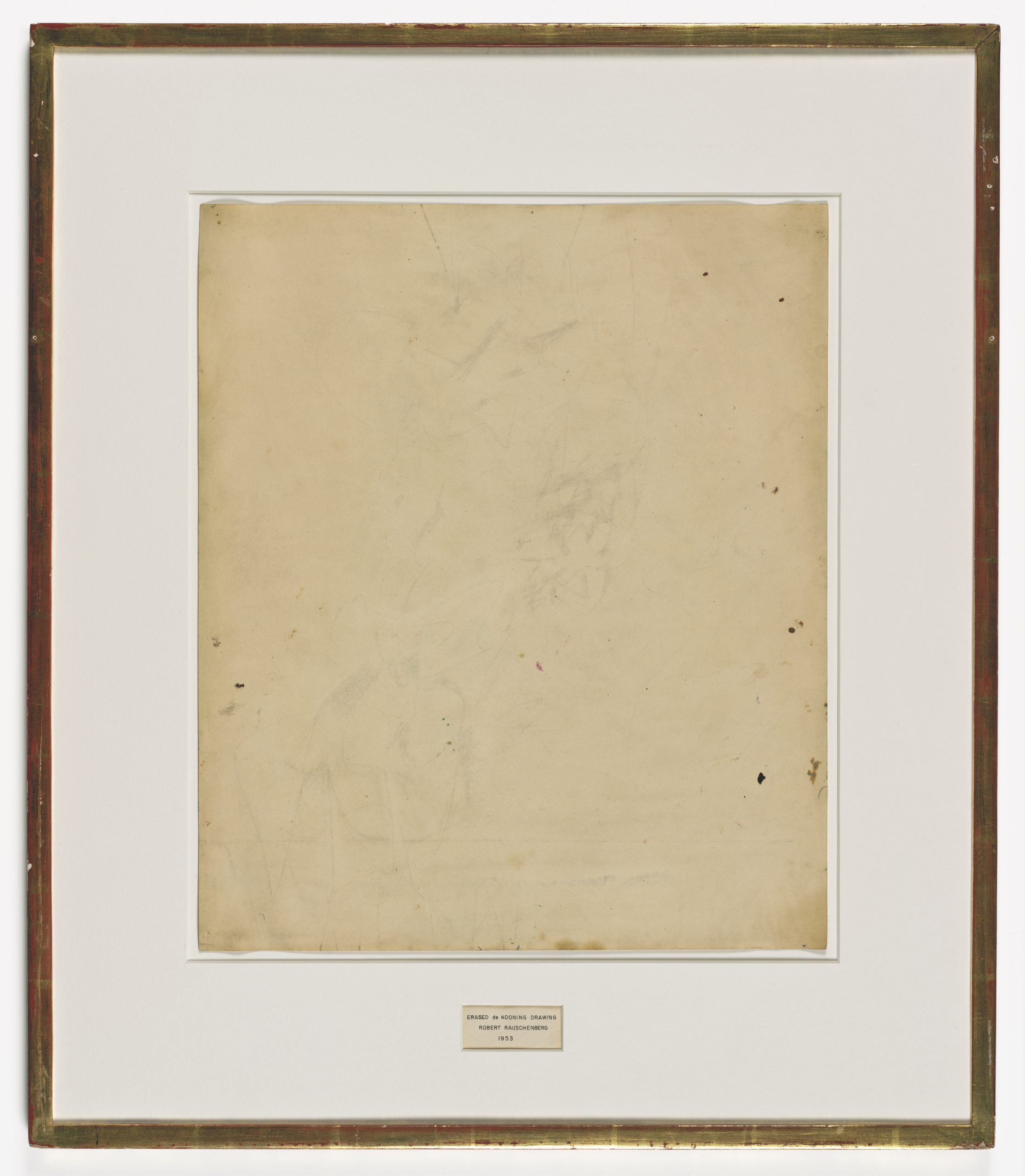
Robert Rauschenberg
Erased de Kooning Drawing
1953
Traces of drawing media on paper
with gilded frame
64.1cm × 55.2 cm ×1.3 cm
Collection of SFMOMA
Purchase through a gift of Phyllis C. Wattis
© Robert Rauschenberg Foundation
Licensed by VAGA at Artists Rights Society
(ARS), NY. Photo: Ben Blackwell
Erasure as a Method of Making
Some four years ago, I organised an exhibition entitled Erasure: From Conceptualism to Abstraction for the Osage Art Foundation in Hong Kong. I began my catalogue essay with a brief discussion of Robert Rauschenberg’s erasure of a drawing by de Kooning. Rauschenberg had bought a recent drawing from his friend de Kooning dated 1951, erased the original and then exhibited it as Erased de Kooning Drawing. Jasper Johns wrote at the time that Rauschenberg had spent a month erasing the work and after the use of 40 erasers, had left “a surface startlingly alive, active, palimpsestic.”16 It was as Johns noted, an “additive subtraction.”17
The exhibition Erasure ranged across a broad reading of erasure as central to an artistic process of making art. It included some 22 artists from across Asia, including Maria Taniguchi and Nilo Ilarde who, as noted earlier here, used the method of erasure as a central component in some of their work.18
Apart from Studio Visit (2012) discussed earlier, other works by Taniguchi also explore erasure and the trace. This is found in the series Untitled, a continuation of her Brick paintings (2008), which is composed of seemingly limitless repetitions of acrylic and graphite lines and hues that create rows of grey brick or box-like forms over the surface of the canvas. There are internal shifts, interruptions to the degree that Joselina Cruz, in Kaleidoscope, characterises as grid-like forms, a skin and method of painting, an ‘archaeology.’ In so doing, viewing the work reveals signs or clues of minute differentiation. As Kathleen Ditzig suggests, Taniguchi generates “ways to see through the surface.”19 Any mark leaves an irreversible trace. Crossed out, painted over, erased, it nevertheless remains, each time different. As with her paintings, the focus is on the space of subtraction. This allows the viewer to witness the process, a process that entails the normal process of alterations and revisions but is etched and therefore resolutely documented.
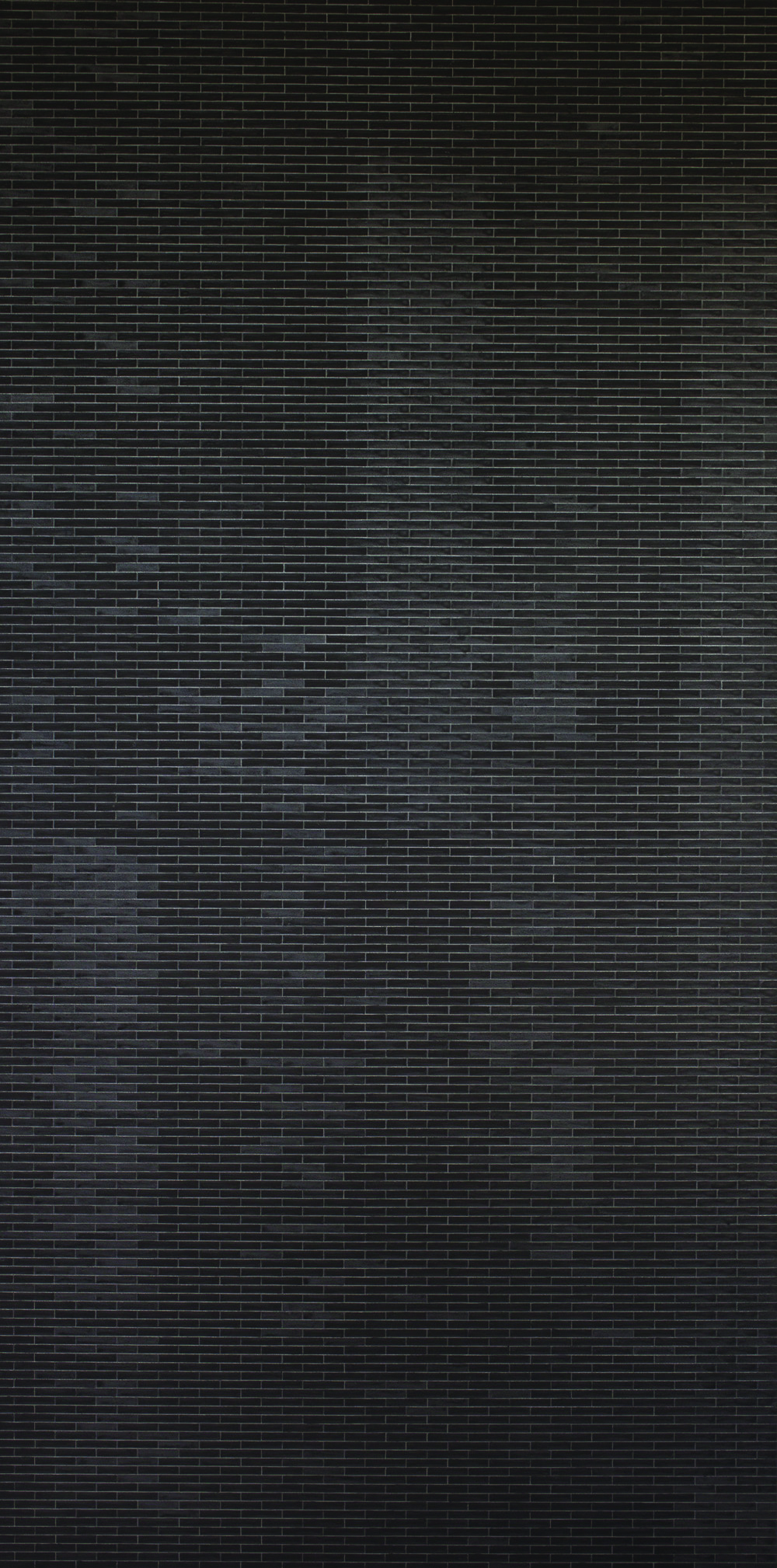
Maria Taniguchi
Untitled
2015
Acrylic on canvas
228.6 x 114.3 cm
Photo: Silverlens and the Artist
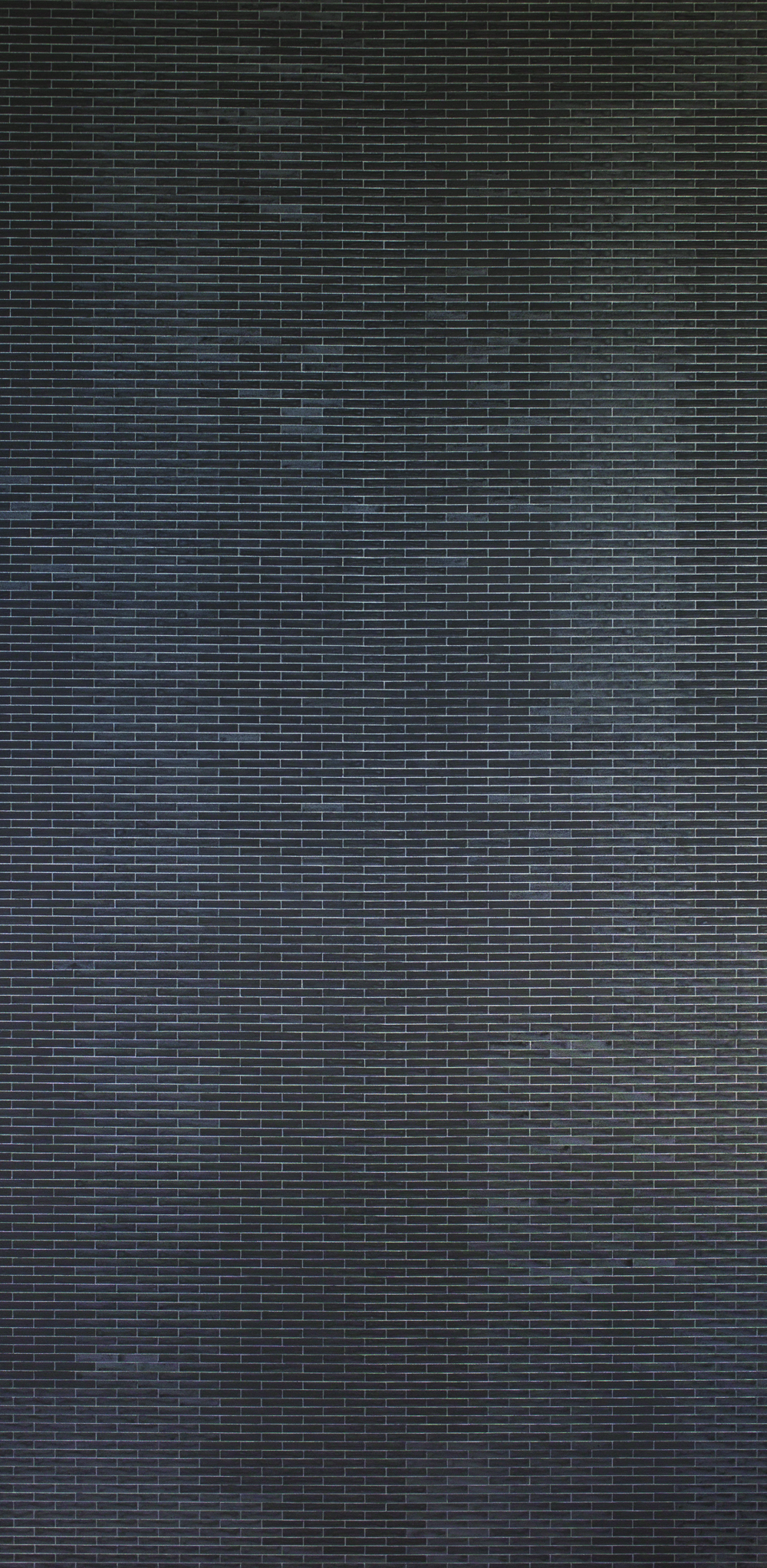
Maria Taniguchi
Untitled
2015
Acrylic on canvas
228.6 x 114.3 cm
Photo: Silverlens and the Artist
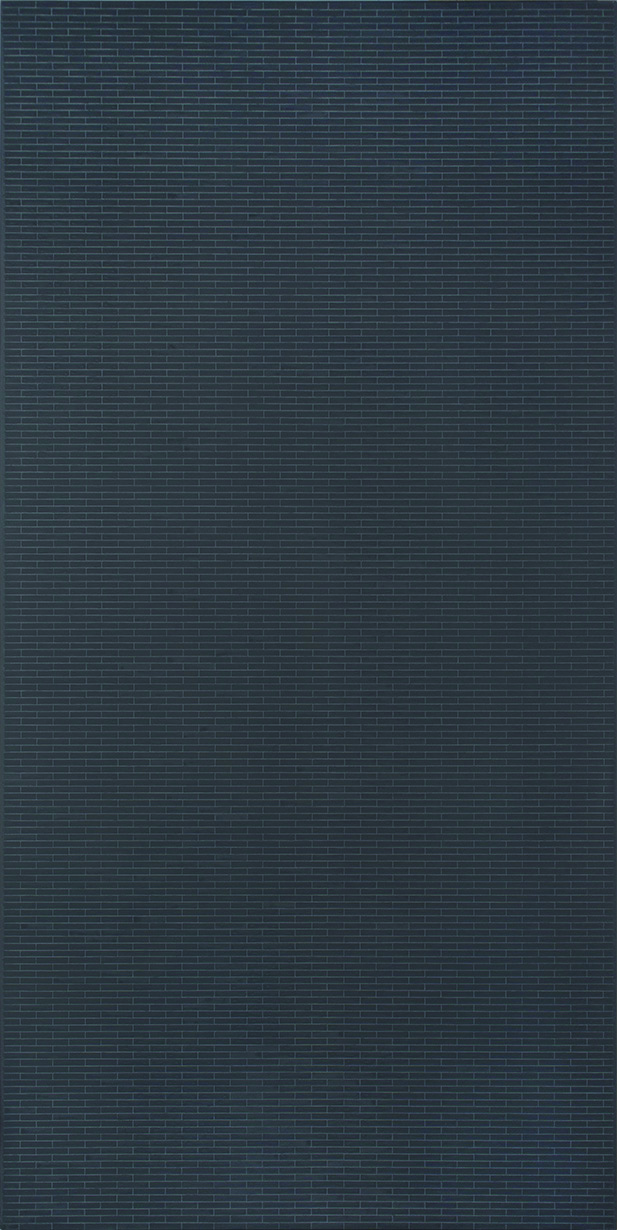
Maria Taniguchi
Untitled
2016
Acrylic on canvas
228.6 x 114.3 cm
Photo: Silverlens and the Artist
Milenko Prvački’s work also engages more broadly with the subject and method of erasure.20 Objects appear in his paintings as incomplete, fragments at best, or an echo of a form elsewhere, losing their immediate meaning or particularity. More often than not, Prvački’s work suggests a movement trapped by the lingering shadows and traces of the past.
The biography is pivotal to an understanding of Prvački’s practice, especially the idea of homeland (Yugoslavia/Serbia) with its recent social history—the Balkan wars—and the cultural context of Prvački’s education and milieu.21 The very idea of logic, if this is even an accurate term of description, that drives the work of Prvački harks back to a former life of his and to a country and world he poignantly remarks “does not exist anymore.” There is no appeal that can be secure whether through a false sense of past unity or the melancholy of nostalgia. This would be a space of lack, of absence has opened, if not cleared, a space for an imaginative re-encounter rather than return to issues concerning his homeland.
In his series Covered Up (2012), there is an ambiguity latent within its colloquial use, suggesting the idea of covering an object or something not to be seen, hidden from view, for instance in the case of a crime scene. Alternatively, the term can refer to painting itself and more specifically, to the process of painting over that which has already been painted. This is a form of landscape that if examined carefully reveals the construction work that has gone on, the various buildings once standing, the now vacant lots and scattered objects, materials and matter. This is the debris of history left behind, the remains of history’s destruction, the remembrance of things past now. In various series, Prvački uses the idea of the visual dictionary, as analogous to not only learning a new language, (as he did with English when he arrived in Singapore) but also to recovering and capturing a visual memory of his past.22
What is critical here is the subject of memory and the process of remembering that are intricately interconnected but also distinct. What happened and what we call memory are never the same. To lay emphasis on the process of remembering is critical precisely because it does not assume any fixed position. Rather, remembering emphasises a process of the now as much as, if not more, than then. The process of erasure will always leave a trace.
Footnotes
1 In Bluebeard’s Castle
2 In the course of this story, drawing it together as the source for the material base of a modernity that characterises the movement of factography in Soviet modernism in the early 1920s
3 Ehrenburg 179
4 Venka Purushothaman, Erase 1
5 Alter 50
6 For a definition of airbrushing, see Cambridge English dictionary
7 Hannah Arendt, “Truth and Politics” and included in a revised edition of her Between Past and Future
8 Derrida, Archive Fever: A Freudian Impression, 97
7 Hannah Arendt, “Truth and Politics” and included in a revised edition of her Between Past and Future
8 Derrida, Archive Fever: A Freudian Impression, 97
9 Margins of Philosophy, 275
10 Purushothaman, Erase 1
11 Michelet 613-14
12 Freud 101
13 Freud, Mystic Writing Pad, 228
14 Derrida, Archive Fever, 83ff
15 Freud, Delusions and Dreams, 65
16 A palimpsest is described as a manuscript or piece of writing material on which later writing has been superimposed on effaced earlier writing. It is something reused or altered but still bearing visible traces of its earlier form. Oxford Living Dictionary.
17 Jasper Johns, as quoted in Cage 75
18 See Erasure exhibition and catalogue 2014
19 Ditzig 102
20 See my book on Prvački: After Memory: Forty Years of Milenko Prvački, 1971-2013
21 In 1991 Prvački moved to Singapore from Serbia
22 The first series was The Ultimate Visual Dictionary 1997-2000
References
Alter, Nora M. Chris Marker. Urbana-Champaign: University of Illinois, 2006.
Arendt, Hannah. “Truth and Politics.” The New Yorker, 25 February, 1967.
———. Between Past and Future, New York: Penguin, 1968.
Cage, John. A Year from Monday: New Lectures and Writings by John Cage, Wesleyan University Press, Middletown: CT, 1967.
Cruz, Joselina. Kaleidoscope, Issue 19, Fall 2013.
Derrida, Jacques. Archive Fever: A Freudian Impression,. Trans. Eric Prenowitz. Chicago and London: The University of Chicago Press, 1995.
———. Margins Of Philosophy, trans. Alan Bass. Brighton: Harvester Press, 1982, Prenowitz. Chicago and London: The University of Chicago Press, 1995.
Ditzig, Kathleen. “Review of Maria Taniguchi at Silverlens Gallery, Singapore.” Flash Art, March-April, 2012.
Ehrenburg, Ilya. The Life of the Automobile (1929). London: Pluto Press, 1985.
Erasure. Exhibition catalogue. Hong Kong: Osage Foundation, 2014.
Freud, Sigmund. “A Note upon the Mystic Writing Pad” (1924–25) reprinted in The Standard Edition of the Complete Psychological Works of Sigmund Freud (Volume I9). London: Hogarth Press, 1961.
Freud, Sigmund. “Delusions and Dreams” in The Standard Edition of the Complete Psychological Works of Sigmund Freud (Volume I9). London: Hogarth Press, 1961.
Ginzburg, Carlo. “Clues: Roots of an Evidential Paradigm.” Myths, Emblems, Clues. London: Hutchinson, 1986.
King, David. The Commissar Vanishes: The Falsification of Photographs and Art in Stalin’s Russia. New York: Metropolitan Books, 1997.
Merewether, Charles. After Memory: Forty Years of Milenko Prvački, 1971-2013. Singapore: Relay Books, 2013.
Michelet, Jules. “Histoire de France” (1833) Oeuvres Completes (vol. 4), Paris: Flammarion, 1974.
Oxford Living Dictionary. https://en.oxforddictionaries.com.
Steiner, George. In Bluebeard’s Castle. New Haven: Yale University Press, 1971.
Essays
The Museum of Emotion, exhibited at the Hayward Gallery, London, February – May 2019, was formulated as the “first UK survey” of French-Algerian artist Kader Attia’s (b.1970) work.1 The show charted Attia’s interdisciplinary practice from the past two decades, which has dealt broadly with transnational histories of colonialism, violence, oppression and dispossession. In Attia’s works, as the Museum of Emotion demonstrated, these histories are not confined to the past. Instead, they continue to resonate through scars and wounds that, in their visibility, come to denote the simultaneous absence and presence of the violence of their origination. The scar’s paradoxical status in Attia’s work recalls Jacques Derrida’s notion of writing ‘under erasure,’ which was visualised in his writing through the chiasmic device of overlaying words with an X. According to Gayatri Chakravorty Spivak, Derrida used this strategy to indicate the simultaneous necessity and inaccuracy of writing itself, and the manner in which its existence implies the absence (or deferral) of the object to which it is supposed to refer.2
In this review of the Museum of Emotion, I situate my argument within and against the Hayward Gallery’s concept of the exhibition as a ‘survey’. That is, by focussing on only one room in the show, I aim to trace a fissure (or a scar) within its totalising aims. In this sense, by resisting the temptations of the ‘overview’, this re-view is written as an attempt to inhabit the logic of Attia’s practice itself, and the manner in which the artist places the postcolonial discourse ‘under erasure’ in order to interrogate its epistemological foundations. This process is apparent in the naming of La Colonie, a space in Paris founded by Attia, Zico Selloum and their families. La Colonie functions as an independent platform for performance, art, activism and critical discussions that all aim to give voice to marginalised minority groups.3 As with Derrida’s writing ‘under erasure,’ the crossing out of La Colonie indicates that the colony is, like the scar, both ‘post’ and ‘present’.4 Moreover, in using the term ‘colonie’ to refer to this grouping of academics, artists and activists, the discursive relationship between colonised and coloniser comes to exceed the logic of the latter. In other words, while the legibility of the word ‘colonie’ is an indication of its continued legacies, crossing out the term is a political gesture that refuses to reduce the activities within this space to these terms. At the same time, the presence of La Colonie in Paris could also be understood as a counter-colony; a ‘colonisation’ of the centre by the periphery. However, this process does not establish another centre, but instead underlines the provisional nature of La Colonie’s authority.
From this methodological basis, the second room of The Museum of Emotion might be similarly conceptualised as a colonie within the exhibition as a whole. The room contains three works. The first of these is The Body’s Legacies, Pt 2: The Postcolonial Body (2018) comprising a documentary video running 48 minutes and a broken plastic chair stitched together with metal staples. Also displayed is a selection of re-printed archival photographs of dictators, singers and musicians in a work entitled The Field of Emotion (2018–19); and a selection of photographs of Algerian transgender women living in Paris from Attia’s series La Piste d’Atterrissage (The Landing Strip) (2000–02). These works are drawn together as a coherent totality through their use of documentary media, such as photography and video, as a way to represent the ‘reality’ of their subject-matter. At the same time, this pretence to intelligibility is undermined by the fact that these ‘representations’ consistently fail in their ability to reveal a truth that might be grasped through ‘actual’ experience. In this way, they are constantly ‘under erasure’.

Kader Attia
The Field of Emotion
2018 – 2019
Site-specific wall installation of
31 fine art inkjet prints
Exhibition view of Kader Attia:
The Museum of Emotion,
Hayward Gallery, London, 2019
Courtesy of the artist and Hayward Gallery
Photo: Thierry Bal
The Body’s Legacies, Pt 2 finds its ‘origin’ in an incident in February 2017, when a youth worker, Théo Luhaka, was beaten and raped by police officers who were arresting him in the Parisian suburb of Aulnay-sous-Bois. This assault sparked widespread protests against racially motivated police violence. These were met with counter-reactions from the far-right National Front (FN), who framed the protests as evidence of growing civil unrest in France, and the country’s need for a strong political leader to “restore order.”5 In Attia’s video, surveillance footage of Luhaka’s assault becomes the starting point for extensive interviews with four individuals—activist and writer, Olivier Marboeuf; journalist and decolonial activist, Louisa Yousfi; philosopher Norman Ajari, and theatre writer Amine Khaled– who discuss issues of racialised humiliation and violence directed towards the postcolonial body.6 In these interviews, Luhaka’s assault is not framed as an anomaly, but instead becomes indicative of a broader cultural and historical context characterised by the dehumanisation of racialised bodies through ‘horrorism’.7

Kader Attia
The Body’s Legacies. Part 2: The Postcolonial Body (video still)
2018
Single channel HD video projection, colour,
sound, 48:00 minutes, plastic chair, wire
Courtesy of the artist, Galerie Nagel Draxler and Kunsthaus Zürich

Kader Attia
The Body’s Legacies. Part 2: The Postcolonial Body (video still)
2018
Single channel HD video projection, colour,
sound, 48:00 minutes, plastic chair, wire
Courtesy of the artist, Galerie Nagel Draxler and Kunsthaus Zürich
As the interview subjects in Attia’s film explain, this dehumanisation is found in the requirement for the postcolonial body to be both in-visible and hyper-visible. Indeed, as Olivier Marboeuf articulates in his interview, the black body is a body that is “devalued in terms of its singularity as belonging to a person, and overvalued in terms of its sexuality.”8 In other words, this body is hyper-visible as a potential threat, yet invisible in its individuality and humanity. In this regard, Marboeuf’s statement implicitly parallels Frantz Fanon’s identification in Black Skin, White Masks (1952) that colonisation necessarily implies the denial of black subjectivity.9 It was also Fanon who, in examining “the racial situation psychoanalytically,” gave “considerable importance to sexual phenomena,” positioning the fear and hatred of the black male body as yoked to the eroticisation of the “black athlete.”10 The violence enacted against these bodies (of which Luhaka’s assault is just one example), must then be seen as a manifestation of this desire/fear, which takes place within an epistemological system that reduces the colonised body to its “biological existence” through a denial of its subjectivity.11
The framing of the colonised body in these terms has, historically, been reliant on technologies of vision. For example, in context of 19th-century colonial ethnographic photography, instruments of measurement and visualisation were used to produce taxonomies of racialised ‘types’. Here, the apparent quantification of physical differences (which were in turn believed to illuminate cultural and moral differences), relied heavily on the totalising ‘objectivity’ of photography as mode of documentation.12 The standardisation of photographic conventions, such as the use of the Lamprey grid backdrop to facilitate anthropometric measurement, thus became evidence that in turn legitimised the racist ideologies of Social Darwinism. These photographs exemplified the mutual imbrication of anxiety and desire that surrounded, and continues to inform, the representation of the postcolonial body. On the one hand, the representation of the colonised body through the ‘objective’ medium of photography demonstrates a convergence between the desire for visualisation and control. Yet this is always coupled with an anxiety that the postcolonial body, as that which is reduced to the ‘biological’, will exceed or undermine such systems. This is due to the fact that while the colonial photograph legitimises the violence perpetuated against colonised bodies, this horror must be ‘erased’ from the image itself. Therefore, as Christopher Pinney has argued, within colonial discourse, there is the ever-present fear that the ‘totalising’ vision of the state might be polluted by the re-emergence of that which it seeks to erase.13
One such re-emergence is found within the surveillance footage of Luhaka’s assault which was publicly circulated one year after the incident. Yet, as Ana Teixeira Pinto has posited, despite the promise that this visual evidence would result in justice for Luhaka, once the video was released “the commentariat began to switch its position from mildly sympathetic to outright dismissive.”14 This is because the video did not stand alone but was bracketed by media commentary. As Pinto explains, “[v]iewers were repeatedly told that Théo was costaud (sturdy), that he resisted the officer’s commands, that police officers were simply ‘doing their job,’ and, most importantly, that the video footage did not support Théo’s claim that he had been raped by the officers involved.”15 From Pinto’s perspective, these framings were possible because of the video’s failure to perform its documentary functions: the surveillance footage provided was “choppy” due to the limitations of digital cameras with low frame rates.16 Similarly, Louisa Yousfi, speaking in The Body's Legacies Pt 2, contended that the public misreading of the assault also had something to do with the fact that the video has no audio, meaning that one could “project whatever [one] wants onto it.”17
In their readings of the surveillance footage’s literal and metaphorical silence, both Pinto and Yousfi place emphasis on the importance of testimony, in the form of Théo’s own account of what happened to him, as well as the experiences of others who have witnessed or experienced similar assaults by the French police. The significance of these accounts (if one is open to listening to them) is that they have the potential to ‘correct’ the French media’s falsified readings of the surveillance footage. In this manner, Pinto and Yousfi reverse the emphasis placed on images in colonial discourse and counter these representations with the ‘truth of presence’. Within this conceptualisation, an image by itself can signify very little, as its meaning is dependent on one’s own experience, or the testimony of those who were present. The low-quality surveillance footage with no audio thus appears analogous to Siegfried Kracauer’s reading of the photograph, which in the absence of testimony becomes “the residuum that history has discharged.”18
Pinto and Yousfi’s views regarding the paucity of the image in the absence of testimony are literalised in Attia’s The Field of Emotion, displayed adjacent to The Body’s Legacies Pt 2 in the Hayward Gallery exhibition. This work comprises a series of black-and-white archival photographs of dictators and politicians—including Adolf Hitler, Josef Stalin, Fidel Castro and Ayatollah Khomeini—together with musicians—such as, James Brown, Aretha Franklin and Oum Kalthoum —who are all represented in mid-speech or mid-performance. In previous editions of the work there was a clear, gendered distinction between the politicians (who were all men) and the musicians (who were all women), a divide that is not maintained in the Hayward show. Additionally, in the earlier edition, Attia contextualised some of the images by presenting them in their original form as book covers or as illustrations for newspaper articles. However, in the Hayward show, any contextualising information about the photographs’ subjects is erased. These changes to the work effectively problematise a reading that posits a contrast between the politicians and musicians, and thus a “difference between propaganda and artistic expression.”19 Here, the contingency of ‘all’ images as representations, despite their subject-matter, is brought to the fore.
As with The Body’s Legacies Pt 2, the question of silence, or more accurately the erasure of sound, comes to indicate the image’s inability to represent the ‘truth’ of its subject-matter. Indeed, while the majority of the photographs’ subjects are pictured in the midst of an oration or performance to an audience, the photograph itself cannot contain any sound, even though the image evidences signs of its erasure. There is also another type of erasure at play here, with all of the images implying the presence of an audience to which the orations and performances are directed, while simultaneously eliminating this group from the photographic frame. The audiences’ visual absence in this field of emotion means that their constitution can only be grasped as a shadow. However, we must accept the existence of this undifferentiated mass in order to recognise the famous subject as an icon. In this respect, a reading of these images is dependent on the audience’s recognition of each of the photographs’ subjects. However, as with the surveillance footage of Théo Luhaka’s assault, this ability is necessarily dictated by one’s position, experience and knowledge. Thus, in the pairing of The Body’s Legacies and The Field of Emotion, one becomes not only aware of the paucity of images as deviations from (and erasures of) an ‘original’ reality, but also the necessarily partial nature of reading positions.
On the one hand, this recognition of the partiality of perspective undertakes an important critique of the totalising ambitious of the ‘objective’ vision implicit in 19th-century anthropological photography, as part of the larger colonial epistemological schema. In Attia’s work, this takes on added significance through the emphasis on voices that are placed under erasure within this discursive schema: that is, those who have been reduced to the ‘biological’. At the same time, to comprehend the ‘partial’ is also to posit the possibility of ‘completeness’, a contention that participates in the perpetuation of the colonial by merely reversing its terms. Following this logic, to the extent that The Field of Emotion and The Body’s Legacies Pt 2 respond to a “demand [for] reparation,” they might initially appear to offer a supplement for whatever is lacking in the image’s ‘partiality’.20 In the case of The Body’s Legacies Pt 2, this is the presentation of the interview subjects’ testimonies that frame Luhaka’s “gestures in terms of self-defence, and situate them within “a larger genealogy of violence constricting the racialised body as a body that does not belong to itself and can therefore be captured.”21 In The Field of Emotion, the repair could take the form of granting the silent photographic subjects and their absent audiences the qualities of sound and voice. In The Body’s Legacies Pt 2, the audibility of the four speakers’ testimonies seems to represent the work’s successful reparation of the wounds opened by Luhaka’s assault. However, in The Field of Emotion, redressing the “silent cry…emit[ted] between official History and the one lived endlessly in the secret of family and community stories,” remains impossible.22
Nevertheless, the difference between the ‘unsatisfactory’ and ‘satisfactory’ resolutions of these two works as “reparations” remains itself unsatisfied. This is indicated by the other component of The Body’s Legacies Pt 2: a broken plastic chair that has been visibly stapled back together. The ‘wound’ of the chair has been repaired in a manner that presumably makes it functional again, but its stapled scar remains prominent. Here, Attia’s work draws an important distinction between ‘reparation’ and ‘restoration’. ‘Restoration’ connotes the desire within western modernity for the possibility of absolute repair, of completely restoring what has been lost in order to erase the violence of injury or destruction, in a manner analogous to the erasure of violence in colonial photography.23 In contrast, ‘reparation’ demonstrates the oxymoron at the heart of this process. That is, reparation has to involve an acknowledgement of the wound and the history that it represents, for “to deny it is to maintain it.”24
This important distinction between restoration and reparation, between a denial of history and the acknowledgement of the wounds of time, also explains why Attia’s installations might appear “confounding” to a viewer seeking completion or resolution.25 The Field of Emotion thus appears unsatisfactory because it reflects the limits of such desires. Indeed, one can never retrieve the voices of those who are pictured in the photographs that make up this work. However, more significantly, one cannot comprehend those who are excluded from the image but make its framing possible: the undifferentiated mass, the audience, the massacred, the oppressed. This necessary absent presence might be conceptualised in Spivak’s recognition that for the “subaltern group whose identity is its difference, there is no unrepresentable subaltern subject that can know and speak itself.”26 A similar problematic is articulated in The Body’s Legacies Pt 2 by Olivier Marboeuf when he describes the “accomplished speaking body,” who in making “demands becomes absorbed in discursive space.”27 In other words, for Spivak (and I would also suggest for Marboeuf), there is no possibility of retrieving the absolute, essential voice of a body which is reduced to the ‘biological’, without subsuming it within the representational structures that simultaneously deny and desire its in/visibility. Yet, such a recognition does not foreclose the potentialities of representation as a ‘speaking for’ and re-presentation as a process of imaging. According to Spivak, radical practice is developed by attending to the interrelations between these two types of ‘representations’ without subsuming them into one another. In other words, one must attend to how “the staging of the world in representation… dissimulates the choice of and need for ‘heroes’, paternal proxies, agents of power.”28
It is this attention to the politics of ‘representation’, in both senses of the term, that is imbued in the relationships between Attia’s works in this exhibition space. In The Field of Emotion, the silence of the speakers and musicians outline the chasm that exists between them and those that they represent. In The Body’s Legacies Pt 2, the talking heads appear to represent the communities they speak for effectively, but the re-presentation (the video of Luhaka’s assault) fails. Yet, in both of these works, the emphasis on either ‘re-presentation’ or ‘representation’ might easily be reversed. Indeed, in The Field of Emotion, the absence of sound could also indicate the photographs’ status as re-presentations of an always, already-lost experience. And in The Body’s Legacies, despite the apparent neutrality of the interviews, the backgrounds behind each of the speakers might implicitly shape the manner in which we imagine the absent-present communities that they represent: wallpaper in the style of African wax prints in the case of Louisa Yousfi; Olivier Marboeuf in a scene with colours that recall the French flag; Norman Ajari in what appears to be a university building, and Amine Khaled on a rooftop, behind which is a city skyline. What is drawn into focus in both cases is the impossibility (yet absolute necessity) of attempts to ‘represent’ and ‘re-present’ that subject/body that exists in a state of in/visibility, in the space traced by the scar.
As a way of concluding I would like to draw together these thoughts on representation through the third work in this exhibition space, The Landing Strip, which comprises photographs of transgender women who came to Paris, largely to escape during the Algerian civil war. According to Attia, the term ‘Landing Strip’ is used by these women to refer to an area in the outskirts of Paris where they work as sex workers, along roads that look very much like airport runways.29 This reference dovetails with Attia’s interest in slum housing areas which are often adjacent to airports. As he explains, “…our vision of these quarters ‘from above’ is no doubt related to the kind of voyeurism we have when the airplane flies over poor areas during take-off or landing.”30 At first The Landing Strip appears to offer a ‘remedy’ to this situation, by “show[ing] the viewer something that they had no idea about.”31 Thus, the objectifying, totalising view from above is replaced with one of intimacy: the majority of the photographs are taken in interior spaces, depicting the transgender women applying their makeup, or in moments of celebration. Additionally, the aesthetics of the photographs recall those of family photographs: they are often over-exposed and blurred, capturing the subjects in self-conscious poses, their gaze meeting the camera, or in more informal moments of joy and spontaneity. The intimacy of these images clearly reflects Attia’s close relationship with this community, particularly given the fact that they also comprise at least part of his audience.32
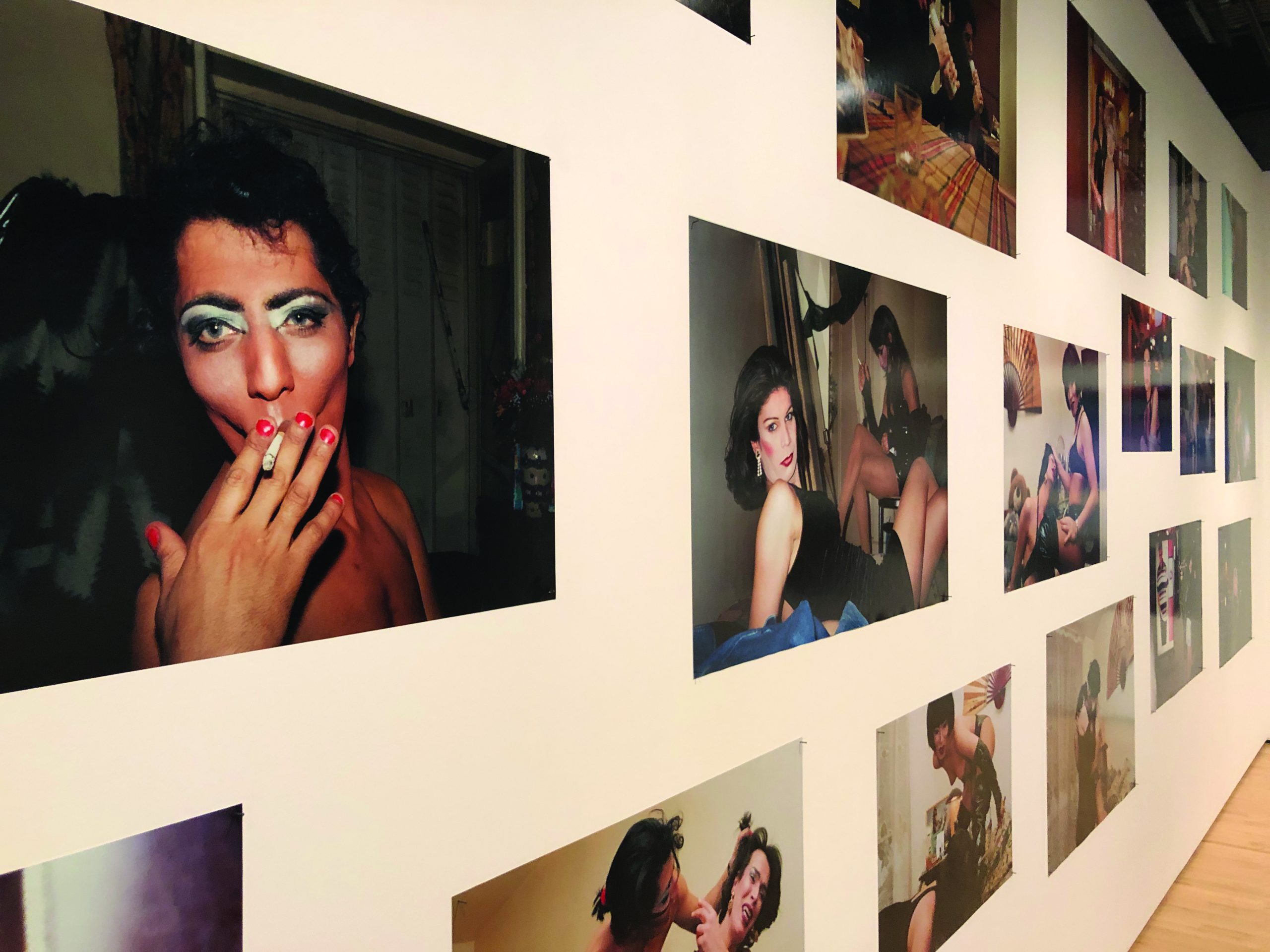
Kader Attia
La Piste d’atterrissage (The Landing Strip)
2000-2002/ 2019
Site-specific wall installation of fine art inkjet prints on archival paper
Exhibition view of Kader Attia:
The Museum of Emotion,
Hayward Gallery, London, 2019
Courtesy of the artist and Hayward Gallery
Photo: Thierry Bal

Kader Attia
La Piste d’atterrissage (The Landing Strip)
2000-2002
Series of c-print photographs
Courtesy of the artist
At the same time, The Landing Strip does not simply replace the objective with the intimate in a manner that would merely imply shifting registers of voyeurism. As one reads the work from left to right, the installation finishes with photographs of protests organised against the French government’s immigration policies, which have life and death implications for the transgender women that Attia represents and re-presents.33 Here, the subjects of Attia’s photographs are literally caught between, on the one hand, the potential violence that they would face in Algeria at the hands of fundamentalist Islamic factions and, on the other, in France where they are denied residency status.34 As Hannah Feldman outlines, these situations are, in fact, two sides of the same coin: the French government’s policy of enforced assimilation and relegation of visible religious difference to the private sphere has alienated populations living in Paris’ outer suburbs, the majority of whom are of African and Maghrebian descent. It is these individuals, she explains, who become “susceptible to the separationist identities marketed to them like so many other commodities by Islamist (and other) groups seeking to augment their numbers with bodies reaped from the fertile grounds of social discontent.”35
As Attia’s The Landing Strip intimates, what is at stake here, as in all of the works in the exhibition space, is not only a recognition of the inadequacy of ‘representation’, but rather what Judith Butler calls the possibility of a “livable life.”36 That is, in placing the images in this space “under erasure,” Attia performs a double gesture in recognising the limitations of representations and re-presentations of those communities still living with the legacies of colonialism, whilst maintaining the fundamentality of these for “persistence and survival.”37 This is an erasure that maintains its trace, simultaneously absent and present, visible and invisible. It charts the unthinkable depths of the chasm of the wound and the possibilities/necessities of living with scars.
Footnotes
1 Kader Attia: The Museum of Emotion
2 Spivak, “Translator’s Preface” xxxii
3 Zapperi, “Kader Attia: Voices of Resistance” 121
4 Spivak, “Translator’s Preface” xxxii
5 Samuel Earle, “Lords of Disorder”
6 As Attia states, “The Tunisian psychoanalyst Fethi Benslama, who I interviewed for my video dealing with phantom limb syndrome, says that colonisation is exploitation, is rape, is expropriation– but colonisation is also humiliation.” from “Kader Attia and Ralph Rugoff in Conversation” 14
7 The term ‘horrorism’ is a neologism drawn from Adriana Cavarero and that is used to refer to a scene that moves beyond directed violence towards total destruction. For more information, see Cavarero’s Horrorism. The term is used by Norma Ajari in The Body’s Legacies Pt 2 and by Attia in The Body’s Legacies Pt 2: The Postcolonial Body
8 Attia, The Body’s Legacies Pt 2: The Postcolonial Body
9 Fanon 1
10 Fanon 121–23. It is important to note here the feminist criticism of Fanon’s work on the basis of his erasure of black women’s subjectivity in his text. For a nuanced treatment of these issues, including the potentials/ limitations of Fanon’s text in the context of sexual difference see Lola Young et. al., “Dialogue” 102–113
11 Fanon 127
12 Brown 632
13 Pinney 33–46
14 Ibid 33
15 Ibid
16 Pinto 33
17 Attia, The Body’s Legacies Pt 2: The Postcolonial Body
18 Kracauer and Levin 429
19 Zapperi, “The Ambivalent Power of Emotions” 60–63
20 Attia, “The Field of Emotion”
21 Zapperi, “Kader Attia: Voices of Resistance” 125
22 Attia, “The Field of Emotion”
23 Étienne 74
24 Attia, “The Field of Emotion”
25 For example, Tabish Khan
26 Spivak, “Can the Subaltern Speak?” 80
27 Attia, The Body’s Legacies Pt 2: The Postcolonial Body.
28 Spivak, “Can the Subaltern Speak?” 74
29 “Kader Attia and Ralph Rugoff in Conversation” 10
30 Durand 73
31 “Kader Attia and Ralph Rugoff in Conversation” 10
32 As he explains, Attia was asked by members of the community to document their parties and “fake” weddings. “Kader Attia and Ralph Rugoff in Conversation” 12
33 A text outlining the plight of Algerian transgender women written by the journalist, critic and activist Hélène Hazera and illustrated with Attia’s photographs from this series was published in Têtu, a French magazine marketed to LGBTQ readers in 1999. In it, Hazera detailed how Attia had been involved with his photographic subjects’ legal battles to obtain residency papers. See Feldman 64
34 Ibid 65
35 Ibid
36 Butler 1
37 Ibid 4
References
Attia, Kader. The Body’s Legacies Pt 2: The Postcolonial Body, 2018.
———. The Field of Emotion, 2018. http://kaderattia.de/the-field-of-emotion. Accessed 24 March 2019.
Brown, Elspeth H. “Racialising the Virile Body: Eadweard Muybridge’s Locomotion Studies 1883–7.” Gender & History, 17, 2005, pp. 627–656.
Butler, Judith. Undoing Gender. New York: Routledge, 2004.
Cavarero, Adriana. Horrorism: Naming Contemporary Violence, trans. by William McCuaig. New York: Columbia University Press, 2009.
Derrida, Jacques. Positions. Trans. by Alan Bass, Chicago: The University of Chicago Press, 1981.
———. Speech and Phenomena. Trans. by David Allison. Evanston: Northwestern University Press, 1973.
Durand, Régis. “Kader Attia in Conversation with Régis Durand.” Nka: Journal of Contemporary African Art, vol. 26, 2010, pp. 70–79.
Earle, Samuel. “Lords of Disorder.” Jacobin, 2017, https://www.jacobinmag.com/2017/03/national-front-theo-luhaka-police-protest. Accessed 25 March 2019.
Étienne, Noémie. “Bodies, Spaces and Artifacts. Montage and Reparation as Forms of History.” Kader Attia (ex. cat.), ed. by Nicole Schweizer. Lausanne: Musée Cantonal des Beaux-Arts de Lausanne, 2015, pp. 73–76.
Fanon, Frantz. Black Skin, White Masks, trans. by Charles Lam Markmann. London: Pluto Press, 2008.
Feldman, Hannah. “As the World Constricts: Kader Attia’s Pictures of Spacelessness.” Nka: Journal of Contemporary African Art, vol. 26, 2010, pp 60–69.
Kader Attia: The Museum of Emotion, Hayward Gallery, 2019, https://www.southbankcentre.co.uk/whats-on/exhibitions/hayward-gallery-art/kader-attia. Accessed 25 March 2019.
“Kader Attia and Ralph Rugoff in Conversation.” Kader Attia: The Museum of Emotion (ex. cat.) London: Hayward Gallery Publishing, 2019.
Khan, Tabish. “A Cheetah and a Carnival: A Diverse Double Bill at Hayward Gallery.” Londonist, 2019. https://londonist.com/london/art-and-photography/politics-and-photography-a-diverse-double-bill-at-hayward-gallery. Accessed 24 March 2019.
Kracauer, Siegfried, and Thomas Y. Levin. “Photography.” Critical Inquiry, 19 (1993).
Pinney, Christopher. “The Prosthetic Eye: Photography as a Cure and Poison.” Journal of the Royal Anthropological Institute, 14 (2008), pp. 33–46.
Pinto, Ana Teixeira. “What’s in an Image?” Camera Austria, 2018.
Spivak, Gayatri Chakravorty. “Can the Subaltern Speak?” Colonial Discourse and Post-Colonial Theory: A Reader, ed. by Patrick Williams and Laura Chrisman. New York: Columbia University Press, 1993.
———. “Translator’s Preface” Jacques Derrida's Of Grammatology. Trans. by Gayatri Chakravorty Spivak. Baltimore: Johns Hopkins University Press, 2016.
Young, Lola, Bell Hooks, Gilane Tawadros, Martina Attille, Mark Latamie, Homi K. Bhabha, and others. “Dialogue.” The Fact of Blackness: Frantz Fanon and Visual Representation. Ed. by Alan Read. London: Institute of Contemporary Arts, 1996.
Zapperi, Giovanna. “Kader Attia: Voices of Resistance.” Afterall, vol. 46 (2018), pp. 116–125.
———. “The Ambivalent Power of Emotions.” Kader Attia: The Museum of Emotion (ex. cat.) London: Hayward Gallery Publishing, 2019, pp. 60–63.
Essays
Abstract
In this essay, I present a phenomenological approach to knowing, learning from, and teaching with what I call ‘orphaned matter’—that is, images, objects or artefacts that are commonly regarded as ‘mute’, deactivated, or redundant because the meanings that accompanied their creation and journey into the present have been erased. Here, research is not directed towards the reconstruction of those lost contexts. Instead, counter-intuitively, researchers honour the gaps and losses that have occurred, however catastrophic, and work with what remains so that alternate insights, situated in the present for the sake of a different future, might begin to reveal themselves. Phenomenology is particularly well suited in this regard because, with its embrace of epoché, a profound openness to erasure is methodologically central to it. Epoché (or phenomenological reduction, and more broadly the suspension of judgement) sets in motion an investigative attitude in which researchers seek to have their inherited habits of thought—their presumptions—illuminated and where necessary disposed of. Notably, this occurs through the agencies of the phenomenon under investigation as it progressively reveals itself, on its own terms, as far as this is possible.
Erasure and Epoché:
Phenomenological Strategies for Thinking in and with Devastation

Figure 1. Ikat and other Southeast Asian textiles on display in the Goldsmiths
Textile Collection’s Constance Howard Gallery on 21 February 2019
Photo: Jorella Andrews. Reproduced with permission
Andrews, Jorella. Erasure and Epoché: Phenomenological Strategies for Thinking in and with Devastation. In ISSUE 08: Erase. Singapore: LASALLE College of the the Arts, 2019. pp. 69-79
How Might We Learn With Loss?
How might we most productively come to know, learn from, and teach with what I will call ‘orphaned matter’? That is, with images, objects or artefacts that are commonly regarded as ‘mute’, deactivated, or redundant because the contextualising meanings that accompanied their creation and journey into the present have been lost? Take, for example, an almost forgotten archive of 43 objects from Southeast Asia with which I have recently become acquainted. They count among the 4,000 or so textile, print and related objects that are stored in the Goldsmiths (University of London) Textile Collection (GTC)—a research and teaching collection that was inaugurated in the 1980s by the radical embroiderers and teachers, Constance Howard and Audrey Walker.1 The Southeast Asian collection consists mainly of clothing (several produced by the Hmong people, an ethnic minority group living transnationally in Southern China, Vietnam, Laos, and Northern Thailand with many now having emigrated to North America and Canada), fragments of clothing such as ribbons, apron strings, and panels, several (Hmong) cushion covers—one showing villagers fleeing from soldiers, crossing a river, and reaching the safety of a camp— and ceremonial items including three rolls of Ikat, ceremonial textiles from Borneo, created through an extraordinarily complex set of weaving and dyeing techniques.2 In most cases, records exist indicating broadly where these varied items have come from and what they are, or were originally, used for. But details of their provenance, and accounts of how they traversed the globe to become part of a small university collection in Southeast London, are generally unknown. As such, they might justly be described as dislocated, diasporic objects, objects that might be judged to have lost their sense of history, biography, and voice. And yet they are compelling. When they were collectively brought out of their seclusion during a recent workshop—unpacked, unwrapped, unfurled, laid out (Figure 1)—we asked ourselves how we might best begin to work with them. My hope was that we might do so in a way that respected their facticity, materiality and specific modes of self-showing here and now. I didn’t want to find myself speaking for them.3
A second, globally-reported scenario marked by erasure—with which I am acquainted only at a distance—(not, of course, the most recent) is also worth referencing at this point: the catastrophic losses to Brazilian culture, science, memory and learning which occurred on Sunday, 2 September 2018, when the Museu Nacional in Rio de Janeiro was devastated by fire. Its archive of around 20 million items was almost entirely obliterated. Included were records of indigenous South American languages which are no longer spoken and priceless fossils (although the Lucia fossil—the skull of a woman who lived 11,500 years ago in Brazil—is believed to have been recovered) as well as ancient Egyptian, Greco-Roman and other irreplaceable objects from around the globe many of which, of course, were accumulated and transported under European colonisation. Here, not only are we dealing with material that is now irretrievably lost (an appeal has gone out to scholarly communities and to the general public for reproductions of photographic or any other records of the now-destroyed materials and their modes of display). We are also dealing with individuals and communities, for whom these materials were experienced as crucial in terms of heritage, self-understanding and identity. In relation to these losses, these persons too might be described as finding themselves in an orphaned state.
The modes of real and presumed muteness associated with these archives of ‘orphaned matter’ differ, as do the conditions that designated them as such. In the first example, at issue were processes of transfer and displacement. The objects in question were then further removed from the circuits of visibility and use by being placed safely into storage. In the second example, the impact of sudden and shocking obliteration was at issue. This brings me back to my opening question: how might we learn with, and from within, loss?
The Restorative Impulse
A prevalent assumption is that research, learning and teaching within such situations are at their most robust when they are involved in trying to recover or restore the contexts, histories and knowledges that once gave these materials meaning. Analogously, without adequate retrieval, orphaned materials are often assumed to remain in a more or less deactivated state, without the vital epistemological agency required to shape the present and the future. In this essay, I will challenge such assumptions by drawing on insights from phenomenology—a philosophical orientation that limits itself to examining the world as it offers itself to us ‘in perception and in experience,’ suspending or bracketing concerns with the world as it might be supposed to exist in and of itself. As such, and as already indicated, the intention will be to honour and work ‘from within’ the gaps and losses that present themselves, however catastrophic, without nonetheless letting loss have the last word. But first, and in order to more effectively illuminate the distinctiveness of such a phenomenological approach, I would like to reflect briefly on what is arguably the most open and speculative of restorative approaches, the creation of so-called ‘object-biographies.’ The website for Oxford University's Pitt-Rivers Museum includes a section introducing such biographies as one of several possible approaches to engaging afresh with its collection. “All objects have a life (or series of different lives),” we read. “All are made, bought and sold, used, treasured or discarded. Some then come into a museum where they can be involved in a number of different life-trajectories (stored, displayed, used in teaching etc). Pretty much every artefact in a museum has an interesting story of some kind that can be told about it and this part of the ‘Rethinking Pitt-Rivers’ website aims to tell some of those stories.” In clarification, among other references, Jody Joy's 2009 essay, Reinvigorating object-biography: reproducing the drama of object lives, is cited: “The biography of an object should not be restricted to an historical reconstruction of its birth, life and death. Biography is relational and an object biography is comprised of the sum of the relationships that constitute it.”4 The site then links to a growing archive of explorations of this kind.
Object-biographies generally begin with careful descriptions of an object’s appearance followed by explorations of its materiality, construction and actual or probable use. Actual or possible dates associated with its creation, use, and entry into a given collection, are also listed along with any other available information concerning its source and provenance. Where basic information is unavailable researchers are prompted to explore more widely, looking for objects that bear apparent family resemblances and about which more may be known. Additionally, objects that are similarly constructed or thought to have had a similar use might be researched, and, with certain degrees of speculation and best-guessing, a background story is constructed. If the object is known to have been made by a particular person or people group or within a given historical period, specific cultural, social, political, economic and other such forms of information will also often be brought into play. Thus, referencing those Hmong items in the GTC about which little is known, descriptive information gleaned from the physical items themselves might be supplemented with material gleaned from other recorded or lived sources. One such source, for instance, might be the geographer Sarah Turner’s 2012 essay, Making a Living the Hmong Way: An Actor-Oriented Livelihoods Approach to Everyday Politics and Resistance in Upland Vietnam, which includes an examination of the production and sale of Hmong textiles. Indeed, visual documentation in the essay depicting Hmong textile traders selling their wares in Sa Pa town marketplace (Northern Vietnam) includes a range of objects that are strikingly similar to several objects held in the GTC. Local economic opportunities suggest that these were most likely made for the tourist market.5
Or take the Australian scholar Astri Wright’s extensive 1994 examination of Ikat—of which, as noted, the GTC has three examples—which also took a restorative approach. In ‘Ikat’ as metaphor for ‘Iban’: Women artists’ creative, ritual and social powers in Borneo, Wright described her project as “an exploration into the meaning, centrality, and anatomy of art-making in an indigenous tribal culture … [which] due to the processes colonialism, modernisation and urbanisation … has now largely disappeared.”6 Having begun with careful descriptions of Ikat (which, like those in GTC, were housed thousands of miles from their place of origin), she went on to produce “a construction … a fiction based on selections from among other people’s rendered facts—scholars, colonial officials, missionaries, travellers and poets of Euro-American and Borneo backgrounds” in which she speculated, as best she could, on the possible mythical, symbolic as well as socio-political meanings of this unusual cloth-making practice.7 Worth noting is that subsequent to the publication of Wright’s essay, scholarship on Ikat has increased, including the book, Ties That Bind: Iban Ikat Weaving, by the Borneo weaver and researcher Datin Amar Margaret Linggi; Linggi also founded the Tun Jugah Foundation Textile Museum & Gallery in Sarawak which is dedicated to the preservation of Ikat.8
Phenomenological Interventions –
description, intentionality and epoché
Phenomenological approaches to research, learning and teaching also begin with description. Indeed, description is key to phenomenological method. In the words of the 20th-century French philosopher Maurice Merleau-Ponty—I will frequently draw on his work in this essay—’the first philosophical act’9 involves ‘describing’ our (perceptual) experience of the world before presupposing it. But phenomenological method differs from the restorative approaches just outlined because rather than depart from initial descriptions of lived experience and encounter it attempts to enter into this terrain ever more deeply by exploring the structures of intentionality. Intentionality, which is again central to phenomenology, has to do with how we are directed towards that which we call the world and with how that ‘world’ is also experienced as being directed towards us. Intentionality may also be described in terms of its noetic-noematic structure. Noesis refers to the intentional act itself—that of perceiving or thinking, for instance—whereas noema refers to the intentional content, to that which is perceived or thought. Phenomenologists attend to both of these aspects. And here, perhaps, an example will be useful—a description of the first few minutes of an encounter with two items, two skirts, from the GTC’s Southeast Asian collection (see also Figure 3). It takes the form of a list organised in the order in which the observations occurred:
A generous curve of stitched and patterned cloth
Adjacent to a still-loosely folded textile (skirt)
A discoloured edge – did it once habitually drag along the ground?
Worn? Used?
All the more obvious against that vibrant ‘DayGlo’ mix of shocking pink, yellow, green and black
A thin strip of vibrant blue
Lines of many variations
Stripes upon stripes
Pleats
Gatherings
A density of layered fabric
‘Dayglo’ versus muted, earthen tones—different qualities of radiance, absorption That strip of blue again. And a green one, nearby
My eye keeps returning to it. It is like a visual pivot, certainly a point of repeated return, and also a resting place for my eyes which otherwise dart rapidly and apparently randomly amongst the abundance of patterns presented to me
A greater sense of verticality (I think) with the skirt on the left
A language of stitches and folds—a material language that keeps my senses and my thoughts in motion and seems to exercise them
An intensity of making—all those stitches, layers, patterns; a super-abundance
A re-use of fabrics?
Programmatic, repeated patterns in the cross-stitched band of squares—mainly orange and yellow, in relative containment, alongside that undulating flow of blue
There is also what looks like more spontaneous patterning in certain bands of appliqué (in contrast to the dominant geometric forms elsewhere, these appear to be fragments of a more organically patterned printed fabric)
Other paler and less immediately obvious rectangular patches
Notice the multiple variations of zigzags across both skirts—appliquéd, literal in the form of folds, stitched …
The care, the labour, the sheer amount of time involved
The stitching together of a thick, layered, heavy garment—for warmth? For dramatic movement? For the purposes of strengthening or repair, in places?
Geometry; geometries
Vibrancy
Intricacy
Why so much labour?
In each skirt, a dark base of printed geometric pattern that is then worked into and over
Suddenly an area of dark green/blue and black textile, intersected by two red appliquéd strips, has become a point of focus for me—I hadn’t paid attention to it until now
There is something atmospheric about these darker, softer colours; they have triggered memories of being embraced by calm, balmy evening air when I was on holiday somewhere hot. They also remind me of the dark luminosity often experienced at dusk.
It’s another place where my senses are able to settle
Handmade; handmadeness; although some of the printed pieces of fabric might be machine-made
Running stitches contrasting with overlapping textures of cross-stitching
Imagining the sounds of making, the effort, the pricking and pressing and turning
Imagining the attention needed to keep areas of detailed cross-stitched or appliquéd pattern going
Noticing where there might have been pauses for improvisation and consideration—should this patch of colour or pattern go here, or there?
Room for trial and error
Imagining tired fingers
[…]
As noted, this is a partial list of first impressions. But already different modalities of description are evident. Sometimes areas of cloth, colour or pattern are the points of focus; what they look or might feel like or how they are arranged; sometimes contrasts are noticed. Then, suddenly, there is a shift of awareness to the activity of seeing or of sensing. A good deal of explicit self-awareness is recorded; a tracking of attention that veers between the active and the responsive. Sometimes description triggers memory, feeling, imagination or speculation; sometimes questions are raised to which description alone may not be able to yield answers. There is also repeated attention on questions of making; the intensity of labour, for instance, that was so clearly involved in crafting these garments. All in all, an energetic material scene of ever evolving complexity has been opening up.
Returning now to the theme of erasure, also central to phenomenological immersion in the structures of intentionality as just described is the experience of epoché (or phenomenological reduction) which sets in motion an investigative attitude characterised, precisely, by loss. Here, researchers seek to have their pre-existing habits of thought, their presumptions, illuminated and where necessary disposed of through the agencies of the phenomenon under investigation. As a consequence, the phenomenon is increasingly released to reveal itself on its own terms, as far as this is possible. In fact, the term epoché (ἐποχή / epokhē) has a long history. In Hellenistic philosophy it referred to either the suspension of judgement or the withholding of assent. The Pyrrhonist philosopher Sextus Empiricus, for instance, used it to describe a state of the intellect which neither denies nor affirms, a meaning that was carried over into academic skepticism. An additional inflection to epoché for the Pyrrhonists was that such suspensions of judgement about non-evident matters had the value of inducing freedom from anxiety (ataraxia). In other words, here, epoché created a mental or attitudinal structure capable of pre-empting the anxiety that tends naturally to arise within contexts of uncertainty. In Stoicism the concept was and is used to describe the withholding of assent to impressions (phantasiai). Much later, Descartes’ epistemological ‘method of doubt’ may also be seen as an enactment of epoché.
Where phenomenology is concerned, epoché was pointedly brought into play by Husserl in his Ideas I (1913),10 in alignment with his notion of the phenomenological reduction. It referred to a procedure in which a thinker systematically suspends judgement about the existence or nature of an imputed external ‘world in itself’, beyond experience, in order better to examine how ‘the world’ that is experientially available to us—the realm of phenomena—is presented to consciousness. For Merleau-Ponty, who defined consciousness as embodied, perceptual, and situated, epoché, understood as an ongoing process, was again central. Examinations of its character, including its perceptual character, and of its philosophical consequences, are consistently found within his writings from the Phenomenology of Perception (1945) onwards. In his late, unfinished work, The Visible and the Invisible (1964) for instance, albeit without explicitly naming epoché or the phenomenological reduction as such, he wrote: “It is necessary to comprehend perception as this interrogative thought which lets the perceived world be rather than posits it, before which the things form and undo themselves in a sort of gliding, beneath the yes and the no....”11 He continued—and this is crucial with respect to the question of engagement with that ‘mute,’ ‘orphaned’ matter on which this this essay is focussed:
It is … a question put to what does not speak. It asks of our experience of the world what the world is before it is a thing one speaks of and which is taken for granted, before it has been reduced to a set of manageable, disposable significations; it directs this question to our mute life, it addresses itself to that compound of the world and of ourselves that precedes reflection ... 12
Using now-contemporary terminology, the decolonising potential of the phenomenological method as presented here is evident. When we are involved in what Merleau-Ponty called “that compound of the world and of ourselves that precedes reflection,” we are embedded in a relationship of open and pre-critical connection with self-showing phenomena which we experience as having the capacity to ‘undo’ what we think we know, and certainly to reposition us. As indicated, this is an ongoing process – also known as the hermeneutic circle – with no determined end in sight. Along the way, though, we do become aware of significant moments of insight and perceptual shift which we may want to dwell on and explore more deeply (Figure 2).
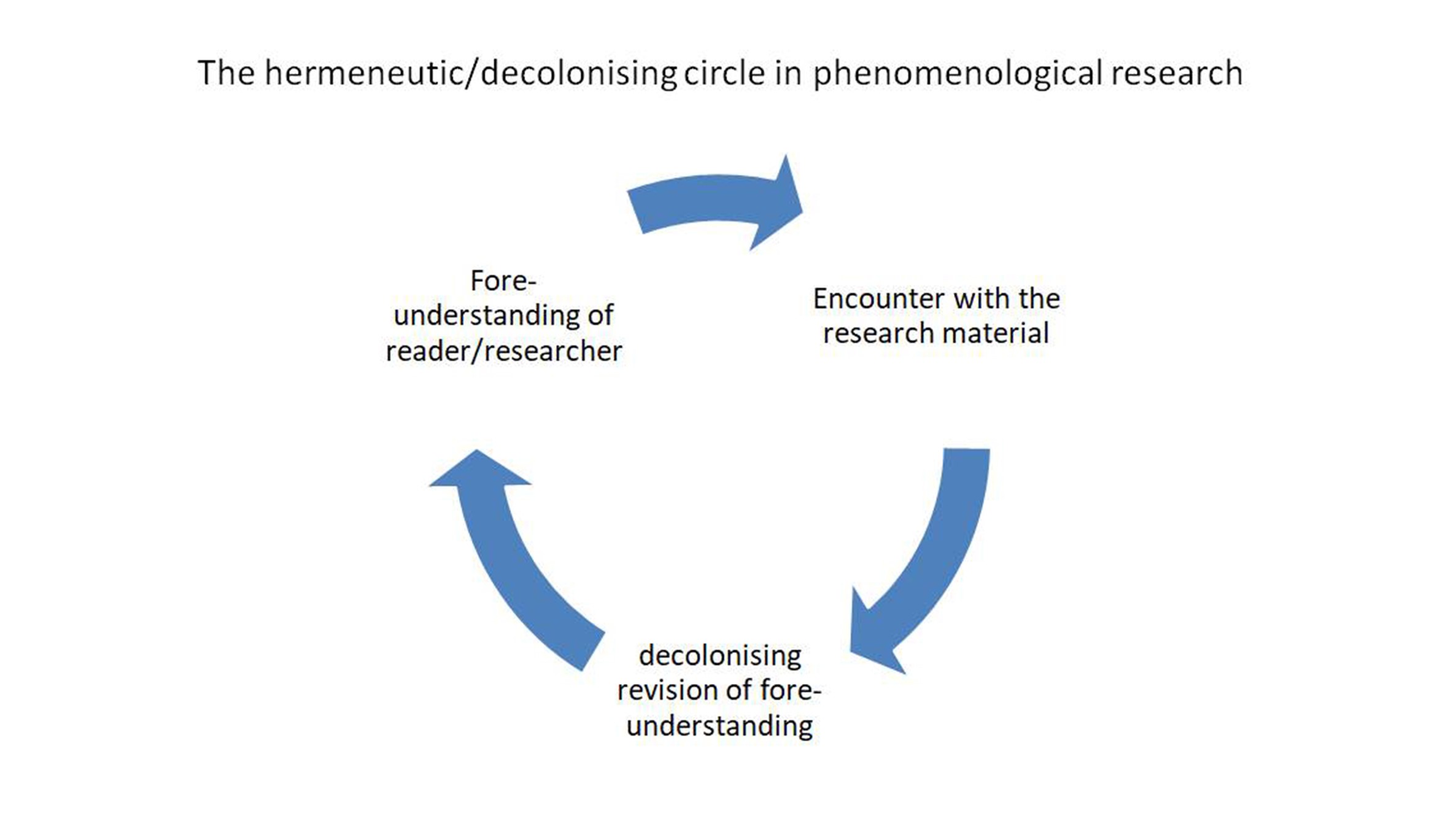
Figure 2. Diagram representing one way of articulating
the decolonising effects of the ‘hermeneutic circle.’
Image: Jorella Andrews
Here, attempts to research, learn and teach within scenes of erasure are positioned far from the intention to salvage or reconstitute lost meaning, whether through forensic or fictional/fictioning means. On the contrary, a doubled scene of erasure is opened up and extended in which the researcher, learner or teacher are themselves implicated. Crucially, this scene of doubled erasure is not experienced as detrimental to knowledge but as its pre-requisite.
This brings me to an explicit discussion of a further dimension of phenomenological epoché. It is crucial since it provides a basis for becoming sensitised to what is, or so I argue, the irrepressible agency of ‘orphaned’ and mute matter within, and for, the context of the present. It is the notion of the ‘I can’ (which Merleau-Ponty adopted from Edmund Husserl) as that which fundamentally structures the perceived world. “Everything I see,” wrote Merleau-Ponty in Eye and Mind (1961), “is in principle within my reach, at least within reach of my sight, and is marked upon the map of the ‘I can.’” “Each of these two maps is complete,” he added. “The visible world and the world of my motor projects are each total parts of the same Being.”13 Here, though, Merleau-Ponty should not be misunderstood. ‘Complete’ does not mean ‘hermetically sealed’ and in a state of finality, in which there is nothing new to be learned or done. Instead he is describing an always still open relational whole characterised by a range of ‘self-directed’ capacities and agencies; a paradoxical scenario in which epoché, precisely because of its embrace of loss and lack as crucial for learning, releases awareness of the world’s irreducible agency. I will develop this idea in what follows.
‘Orphaned’ matter, the painter’s question, and Merleau-Ponty’s ‘I can’
“… to philosophise is to seek, and this is to imply that there are things to see and to say. Well, today we no longer seek. We ‘return’ to one or the other of our traditions and ‘defend’ it.’”—Merleau-Ponty.14
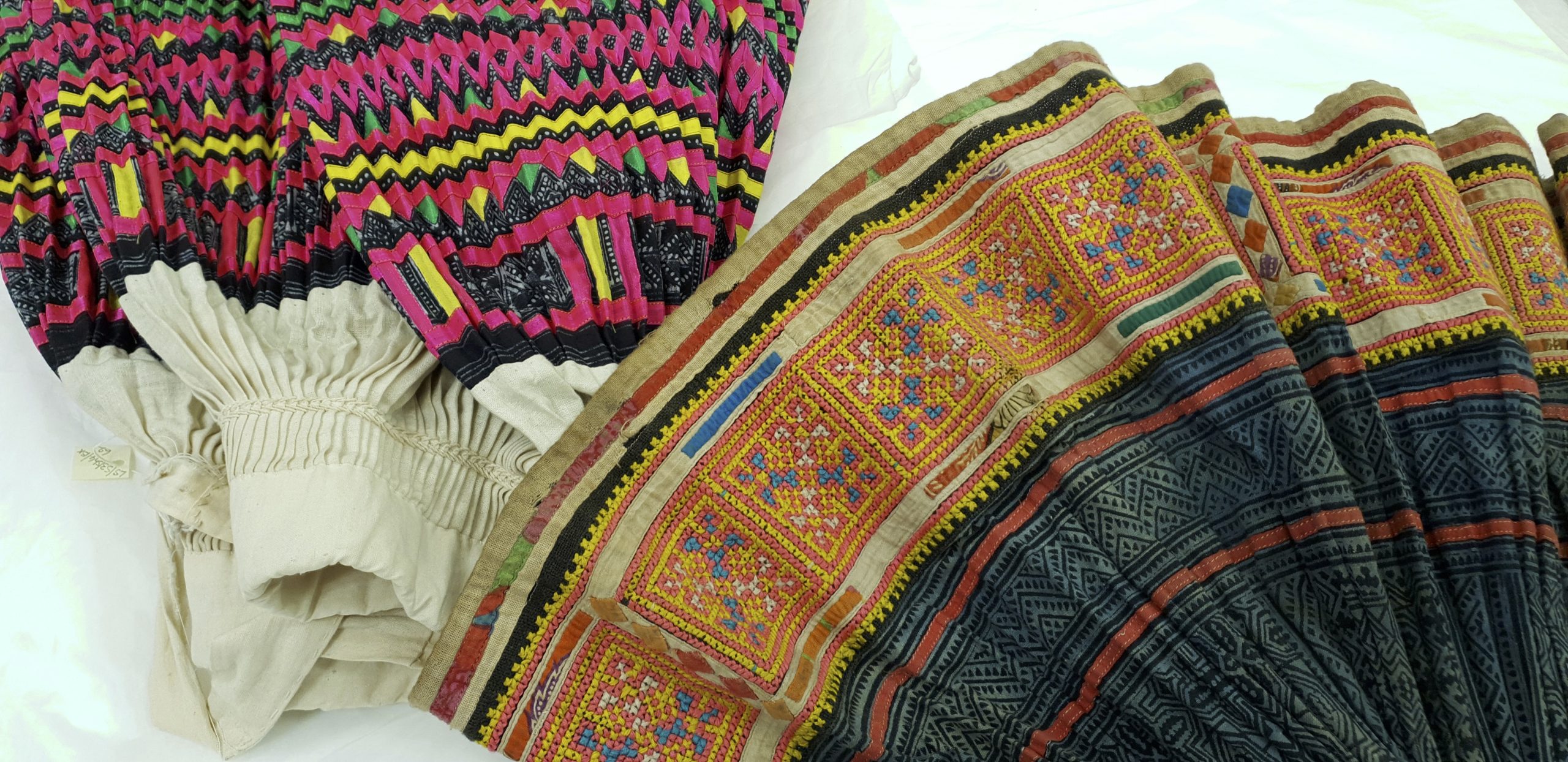
Figure 3. Details of two Hmong wrap skirts on display in the
Goldsmiths Textile Collection’s Constance Howard Gallery on 21 February 2019
Photo: Jorella Andrews. Reproduced with permission
As already indicated, my aim in this essay is not to undermine scholarly attempts at retrieving lost context and meaning within scenarios marked by erasure. Rather, I wish to propose an additional and alternate approach that moves not from a devastated present to a lost past but, operating outside of a logic of melancholy, across different trajectories of the present with an eye to the future. Here, the aim is to stay with the remains and to ask how, if we will let them, objects affected by erasure may function as teachers out of their particular qualities of what-ness, here-ness, and now-ness. How might ‘these’ aspects of their being ‘be allowed’ to take on new meaning, legacy and agency, provoking us to see, think and act differently and to reach out into the not-yet-known? At issue here is their capacity to inaugurate these new possibilities in concrete, material ways.
Again, epoché is vital. Certain assumptions about learning, and about the nature of productive learning environments, must be relinquished. In Merleau-Ponty’s terms, the schoolmaster’s question must become the painter’s question.15 Recalling our earlier discussions, this is a mode of questioning which again addresses ‘what does not speak’, our ‘mute life’, and “that compound of the world and of ourselves that precedes reflection.”16 It is also a mode of learning in which the conventional roles of the interrogator and the interrogated are reversed. The painter’s question is:
… not a question asked of someone who doesn’t know by someone who knows — the schoolmaster’s question. The question comes from one who does not know, and it is addressed to a vision, a seeing, which knows everything and which we do not make, for it makes itself in us … The painter lives in fascination. The actions most proper to him — those gestures, those paths which he alone can trace and which will be revelations to others (because the others do not lack what he lacks or in the same way) — to him they seem to emanate from the things themselves, like the patterns of the constellations. Inevitably the roles between him and the visible are reversed. That is why so many painters have said that things look at them.17
It is here, within these reversals, that the experience of ‘I can,’ referenced earlier, comes into play; the ‘I can’ is discovered to be internal to, and emergent within, the noetic-noematic structure of intentionality. This is illuminated in Eye and Mind. In the context of developing his understanding of painterly questioning, Merleau-Ponty wrote that painters “know” the world by “lending” or “donating” their bodies to it, enabling a deeply felt experience of communicative exchange to take place.18 His aim here was also to present a counter-argument to a dominant conception of vision as an “operation of thought.”19. Thus, he defined it instead as an operation of “the actual body,” which is “an intertwining of vision and movement.”20 While this might be experienced in part as a relinquishment, as involving a certain loss of self, it may also be perceived and experienced differently, in terms of change, extension and enrichment. In any case, the world towards which this body is directed is not some rationalist construct, some ideation or idealisation. Rather such bodily modes of perception are directed towards, and navigate, what Merleau-Ponty described as those two intertwining or overlapping maps of the ‘I can’ in which two centres may be found, one in the visible world and the other in our motor projects. It is clear therefore that several agencies, human and non-human, are at work here. Indeed, it is from this lived experience of bodily donation that we are able to understand and accept that the scope of the self-showing world expands far beyond human aspirations and intentions. More than that, as Kaja Silverman puts it in her book World Spectators (2000), citing Hannah Arendt: “It is . . . not the perceiving subject but rather the perceptual object which plays the initiating role in this scopic transaction . . . When we look at other creatures and things . . . it is also in response to their very precise solicitations to us to do so.”21
To summarise then—and, yet without wishing to present a set of reductive protocols —phenomenological contributions to engaging within sites and scenes of loss in as enlivening a manner as possible might be seen to constitute at least four (inter-related) moments:
- Activating and being activated by perception and description as ways of drawing near and learning to attend to the as-yet unarticulated possibilities of mute being.
- Activating and being activated by the intentional structure of perception understood, following Merleau-Ponty, as a “compound of the world and of ourselves that precedes reflection,” that is, as an internally-related, pre-critical form of communication.22
- Activating and being activated by epoché as core to intentionally in order to create space for the things to self-show, as far as this is possible.
- Activating and being activated by the 'I can'—which is itself illuminated and activated by epoché—this ‘I can’ again being understood as an intercorporeal, ‘compound’ phenomenon. Here, as Merleau-Ponty wrote of Cézanne: “The landscape thinks itself in me … and I am its consciousness.”23
Reflecting back on that partial, descriptive, pre-explanatory investigation of portions of Southeast Asian textiles from the GTC, it is clear that all of these moments, or dynamics, are present in embryonic form. On the one hand, though, it is true that this terrain—while materially detailed, intricate and ever-evolving, as well as inevitably personal and situated (what might someone else’s list have itemised?)—is perhaps also fairly abstract and formal even if also emotive and thought-provoking. As such, we might question the value of these experiences as compared to the specific, even if often also relatively speculative, social, historical, economic, political and cultural values that featured in the restorative approaches referenced earlier. But on the other hand, as already argued, the phenomenological strategies presented here are not intended to stand alone or replace those other approaches. They provide alternative modes of awareness and are critically useful for their capacity to keep openness in play. As such, they disrupt general tendencies for investigation and problem-solving to be approached (or mis-approached) reductively, through what is already thought to be known. Phenomenology, rather than position the investigator’s potential as central, brings the wider realm of material intelligence—materiality’s ‘I know’ and ‘I can’—into perceptual and conceptual range. And, when it comes to thinking and responding within cultural scenes indelibly marked by erasure, phenomenology offers structures and strategies in which – albeit perhaps too-uncomfortably slowly and incompletely – rather than feeling overwhelmed by loss we begin to feel overwhelmed by how much is still here; despite everything, the world is experienced as information rich and resource-full. But it takes time for this to come to awareness and in the most devastated of conditions such time-making will most often appear non-viable. But it is precisely here that Merleau-Ponty’s self-showing “compound of the world and of ourselves that precedes reflection” might most beneficially be allowed to declare its agencies and propositions and gradually become more broadly communicable. A very small contribution to the development of the work begun in this essay therefore will be a series of phenomenological investigations of the ‘orphaned’ Southeast Asian items in the GTC, ideally involving a diversity of differently situated participants and stakeholders. Where such investigations might lead must, of course, remain an open question for now.
Footnotes
1 For more information see the GTC’s website and related links: https://www.gold.ac.uk/textile-collection/. Accessed 10 June 2019. Items from the collection may be viewed via VADS, the online resource for visual arts https://vads.ac.uk/collections/CHM.html
2 See for instance “How an Ikat is Made” (2012), Youtube
3 These items were displayed in the context of a workshop, facilitated by me (Goldsmiths) and Clare Veal and Jeffrey Say (LASALLE College of the Arts, Singapore): Using Phenomenology in Contemporary Arts Research and Pedagogy – Workshop 2. Subtitled “Phenomenological Encounters with Non-Western and Diasporic Objects-Images-Archives-&-Artworlds (Phenomenology, Displacement and Decoloniality),” it took place on 21-23 February 2019, Goldsmiths, University of London
4 Joy 552
5 Turner 413. In Turner’s words: “With the opening of the uplands again to overseas independent tourists in the early 1990s, a few (initially elderly) Hmong women identified an opportunity to sell their colourful and ‘exotic’ cloth once more, as they had during the French colonial period. Tourists were keen to purchase ‘authentic’ cultural artefacts such as full pieces of embroidered hemp clothing (Michaud and Turner 2000, 2003). Hmong women grow, spin, and weave these as part of their gendered livelihood portfolios, with segments then intricately batiked and embroidered with motifs that have symbolic meaning for their producers (Mai Thanh Son 13, 24)”
6 Wright 135
7 My thanks to Dr. Clare Veal for drawing my attention to this source
8 Heppell 143-153. Details of the Tun Jugah Foundation Textile Museum & Gallery may be accessed via http://tunjugahfoundation.org.my/textile-museum-gallery/
9 Merleau-Ponty, Phenomenology of Perception 71
10 Ideas: General Introduction to Pure Phenomenology, 1931
11 Merleau-Ponty, The Visible and the Invisible 102
12 Ibid
13 Merleau-Ponty, The Primacy of Perception 162
14 In Praise of Philosophy 41
15 Merleau-Ponty, The Primacy of Perception 167
16 Merleau-Ponty, The Visible and the Invisible 102
17 Merleau-Ponty, The Primacy of Perception 167
18 Ibid 162
19 Ibid
20 Ibid
21 Silverman 129. I explore this point in my book Showing Off! A Philosophy of Image. See pages 173, 174, 182, 190 and 195
22 Merleau-Ponty, The Visible and the Invisible 102
23 Merleau-Ponty, Sense and Non-Sense 17
References
Andrews, Jorella and Leah Durner. Painting, Largesse and Life—A Conversation with Leah Durner, 2019, https://www.leahdurner.com/bibliography. Accessed 4 April 2019.
———. Showing Off! A Philosophy of Image. London: Bloomsbury Publishing, 2014.
Heppell, Michael. “Women’s War. An Update of the Literature on Iban Textiles.” Moussons: Recherche en sciences humaines sur l’Asie du Sud-Est, 8/2005, pp. 143-153, http://moussons.revues.org/2267.
“How an Ikat is Made” (2012). Youtube. https://www.youtube.com/watch?v=3OAnnvPEOl8. Accessed 4 April 2019.
Husserl, Edmund. Ideas: General Introduction to Pure Phenomenology. Translated by W. R. B. Gibson. Oxford, England: Macmillan, 1931.
Joy, Jody. “Reinvigorating object biography: reproducing the drama of object lives.” World Archaeology, 41: 4, 2009, pp. 540-556.
Merleau-Ponty, Maurice. “Cézanne’s Doubt” (1945). Sense and Non-Sense. Translated by P. Allen Dreyfus & H. L. Dreyfus. Evanston: Northwestern University Press, 1964, pp. 9-25.
———. “Eye and Mind” (1961). The Primacy of Perception and other essays. Evanston: Northwestern University Press, 1964, pp. 159-90.
———. “In Praise of Philosophy.” In Praise of Philosophy and other Essays (1953), Evanston: Northwestern University Press, 1970, pp. 3-64.
———. Phenomenology of Perception. Translated by Colin Smith. Abingdon: Routledge and Kegan Paul Limited, 1962.
———. The Visible and the Invisible (followed by working notes). Evanston: Northwestern University Press, 1968.
Mai Thanh Son. Craft Tradition and Practice: The Hmong of Ta Phin, Sa Pa, Vietnam. Hanoi, Vietnam: Vietnam Museum of Ethnology and Craft Link for MRDP Vietnam, 1999.
Michaud, J., and S. Turner. “The Sa Pa Marketplace, Lao Cai Province, Vietnam.” Asia Pacific Viewpoint 41 (1), 2000, pp. 85–100.
———. “Tribulations d’un marché de montagne du nord-Vietnam (Tribulations of an upland market in north Vietnam).” Études rurales 165–166, 2003, pp. 53–80.
“Object biographies.” Rethinking Pitt-Rivers: Analysing the activities of a nineteenth-century collector. Pitt-Rivers Museum. http://web.prm.ox.ac.uk/rpr/index.php/objectbiographies.html. Accessed 10 June 2019.
Silverman, Kaja. World Spectators. Palo Alto: Stanford University Press, 2000.
Textile, Museum and Gallery. The Tun Jugah Foundation, http://tunjugahfoundation.org.my/textile-museum-gallery/. Accessed 10 June 2019.
Turner, Sarah. “Making a Living the Hmong Way: An Actor-Oriented Livelihoods Approach to Everyday Politics and Resistance in Upland Vietnam.” Annals of the Association of American Geographers, 2012, 102:2, pp. 403-422.
Wright, Astri. “‘Ikat’ as metaphor for ‘Iban’: Women artists’ creative, ritual and social powers in ‘Borneo.’” Penny Van Esterick and Lynn Milgram (eds.), The Transformative Power of Cloth in Southeast Asia. The Canadian Council for Southeast Asian Studies/The Museum of Textiles, 1994, pp. 135-163.
Conversation
… to make a stone feel stony, man has been given the tool of art…By ‘estranging’ objects and complicating form, the device of art makes perception long and ‘laborious’ …
—Victor Shklovsky1
… You can pick up any given stone anywhere in this country and can be certain that something happened at that very place in those dark times, too … —Michaela Melián, in conversation.
… The iterability of the trace (unicity, identification, and alteration in repetition) is the condition of historicity—as too is the structure of anachrony and contretemps …
—Jacques Derrida 2
Plath, Nils. The Trace of Stones and Memory Work: Michaela Melián on the Historicity of Re-representations. In ISSUE 08: Erase. Singapore: LASALLE College of the the Arts, 2019. pp. 81-105.
Like so many others, this city is built on sand. The city, any city, our city that continues to challenge us to reflect, in the words of Paul Valéry,3 on how it creates and shapes us, in its role as a surface and ground for the many assemblies that Judith Butler dedicated some notes to in recent years, concerning the future of democracy.4 One where the “descent of structures to the street” took and takes places, as Jacques Lacan pointed out to Michel Foucault, looking back at the May of 1968.5 A ground on which to position oneself temporarily, in view of the history in which youthful demonstrators here and elsewhere, once upon a time 50 years ago, seemed hopeful of discovering an unlikely utopia, seemingly promised in one of their popular slogans, which was coined by the protagonists of the Situationists International and painted in translation across many walls, not only those in what had been known as the ‘Capital of the Nineteenth Century’6: “Sous les pavés, la plage (Beneath the pavement, the beach).” Even deeper run the layers here that Sigmund Freud failed to mention in Civilization and its Discontents, where he came up with the analogy of the city of Rome as the human psyche7: 13,000 feet underground, the oldest volcanic stones from the geologic era of the so-called early Permian era, almost 290 million years old; then 6000 feet of mighty salt crusts and 2500 feet of cap rock (coloured sandstone), 890 feet of Muschelkalk, 446 feet of Keuper, and finally 164 feet of loose sediment from the Quarternary period. Sealed by artistry and craftsmanship the ground covers the results of several thrusts of the Scandinavian inland ice and multiple tectonic movements during thousands of years and many long-forgotten reigns, which created these layers invisible to the human eye. In this city, the stone floor made for walking is traditionally composed of slit massive, polished granite rocks millions of years old from the Silesian landscape, each about three by four feet, enclosed by random rows of small cobblestones that run like a mosaic along the fronts of the houses and the edge of the sidewalks. This pavement pattern remains the signature of the public sphere in this city, even when, over time, other natural and prefabricated stones have supplanted the cut and worn-smooth granite rocks in more and more areas. It is this city, the capital of more than one Reich, that had witnessed its own destruction into rubble. Pedestrian sidewalks: a regular texture over which couples and passers-by come together and part, where they head to a destination or meander aimlessly, meet or disregard on-comers, where they invite attention and long to be watched, only to finally disappear behind the facades or in the next side street. Eighty years later, with some massive interruptions and breaks in local and global history, these sidewalks are also crowded by those who have no choice but to conduct themselves as Bertolt Brecht advised illegal and political activists in the poem in his Handbook for City-Dwellers from 1939—a book that might be still purchasable from the second-hand bookseller around the corner:
Part from your comrades at the station
Go into town in the morning with your coat buttoned up
Find yourself a quarter, and when your comrade knocks
Do not open, O do not open the door
But
Erase the traces!
If you run into your parents in the city of Hamburg or elsewhere
Pass them like a stranger, turn a corner, do not acknowledge them
Pull that hat they gave you down over your face
Do not show, O do not show your face
But
Erase the traces!8
Right here on my block, as well as elsewhere, the arrangement of the signature stones is broken up in front of several building entrances. Single concrete cobblestones, bearing a brass plate with engraved names and dates, have been embedded in the mosaic. Markers of events from a still-current past that most will gloss over without awareness; these events can be read about in the preface of another book long out of print and possibly found on the shelves of bookstores. It is a preface that connects stories about streets and locales with very personal memories of one of the most crucial days in German history:
I remember being eight years old; one night, lying in my room facing the main street, I was suddenly woken up by a loud, high pitched sound. At first, I thought I had heard laughter, and once I was fully awake I perceived a clanking noise, the loud shattering of glass, and then the dull thuds of riding boots, with shouting in between. Then, a shrill cry was audible, more yelling and muffled voices, and at the end of it, engines started up, their sound soon receding. The next morning I saw a completely wrecked and ransacked store. The shop window with the name Hertz was in smithereens, and among the shattered glass on the sidewalk I remember seeing red spots washed over with water. 9
Engraved on the so-called Stolpersteinen—literally, “stumbling stones”—are the names, dates, and some very brief information about the fate of those who lived in those houses at one point, those who were deported and murdered during the Nazi era in Germany. As the result of a private initiative, more than 70,000 of these stones have been placed in the sidewalks of many German and European cities and towns since 1992. As impediments or obstacles, they are meant to make the passers-by pause and reflect upon the history of the place in memory of those victims. Yet, the stumbling stones are not uncontroversial, and not everyone embraces them as well-intentioned memory aid. While some property owners dislike them and consider them perpetual eyesores, others view them with good reason as examples of an all-too-simple mode of remembrance, as a form of memory kitsch. A vocal part of Munich’s Jewish community rejects them as an inappropriate means of commemorating the dead and has circumvented the laying of any stones in the city, arguing that they would only invite desecration and that stepping on the names of the ones murdered would be disrespectful and degrading.
Instead, since 2010, Munich as the capital of the state of Bavaria has a virtual memorial for the victims of National Socialism: Memory Loops by the artist Michaela Melián. Multi-layered and large in scale, intangible, highly complex, and made to incite a shift in one’s perception of the visible layers of this city, where the Bavarian royalty formerly resided, the piece comprises 475 audio tracks—300 in German and 175 in English. Each one of the tracks is a collage of one or several voices thematically tied to the individual location in the cityscape. All of them can be downloaded or listened to online (www.memoryloops.net) or via phone on site. Memory Loops—an intermediate work that has garnered several art awards—recounts the history of the city the Nazis called the “capital of the movement,” by using historical materials from the time of National Socialism (NS) and later accounts of witnesses, describing the discrimination, persecution, and exclusion to which people in Munich—Jews, oppositional political activists and resistance fighters, the gay population, church members, Romani people, and others—were subjected to under the NS regime. Michaela Melián, who studied art and music in Munich, is deeply connected to the city, as an artist who has worked there for decades. Today she lives in a nearby Bavarian village. In her works, dating back to the 1980s, Melián focusses on body and gender politics and issues, on memory work, and on representations of German history. She applies multiple media in her work: using installation and performative formats, producing classic works for the wall and on paper, as well as audio works, radio plays, and recordings on vinyl and CD, as well as sound works for public spaces and the internet.
The following conversation took place in early 2019 in Hamburg, Germany, where Melián works as a professor of time-based media at the Hochschule für bildende Künste (HFBK). It was conducted in German and translated into English by Nils Plath:
Nils Plath
Can you say something about how you developed Memory Loops, its structure and various elements?
Michaela Melián
First, it is important to know that for this invitation-only competition, I came up with the idea for a monument that had no preconceived or designated location in town to start with. Because the politicians involved could not decide on a place where to put it. I had gotten the impression that they hoped somebody would come up with ideas that allowed them not to sacrifice a piece of property at all. The complex history of Munich is the very reason for this. All the prominent locations it would have been destined for—like the Odeonsplatz or the Königsplatz—are in the heart of town, but do not belong to the city. It is the state of Bavaria that has the say over them. And while the city government that had this idea for the monument for the victims of National Socialism in Munich was a progressive one at the time, the state was ruled by a conservative right government. The two do not share any common ground when it comes to cultural projects. When invited to participate, I thought the whole thing would just be a dud, something that would not come off, and would not be realised in the end. That is why I came up with the idea for an immaterial work of art, an audio work. I also find it highly problematic in principle to place a symbolic stone somewhere in the public sphere so that it then serves a political function. While certain city tours lead to it, of course, most pedestrians and drivers passing by are unaware of what it stands for. It is nothing else but a form of official political relief effort to come to terms with the past symbolically. To counter this, I wanted something different. It was my idea then to somehow tell a story about this uncannily massive history of erasure that had taken place here—an erasure of personal narratives that depict politics, as well as life itself. Thus I thought of ways of how to recount stories and histories from lives back then, which might happen today, too. Thinking about this makes me, in fact, a bit wary and fearful in today’s world. I knew there were many sources, oral histories that a generation before me, the one of 1968, had already collected and saved. Eyewitness accounts from survivors. Most of the materials were scattered in various, often private archives—of documentary filmmakers, for instance. Like Katrin Seybold’s; she was a leftist filmmaker and writer who did a lot of research about the family and circles of Sophie and Hans Scholl, members of the resistance group Weiße Rose who were both murdered by the Nazis. As well as about the lives of Romani families and communists. For a long time, her films were hardly shown in official institutions, because she was regarded as a sympathiser with the radical left. I was lucky that I got access to some of her films right before her death, and I used passages from several of her works for my audio tracks. Today, parts of many of her films can be seen at the NS documentation centre in Munich, where they are part of the permanent collection. I also used other people’s archives, as well—radio journalists’, for instance. And from the Dachau concentration camp memorial site. The latter was originally initiated by former inmates. They did not want to lose their memories and started recording each other’s stories early on. My first sources were those audio files that I had transcribed. That was a very labour-intensive endeavour. Most of the material had only been published in excerpts, never in full. It was my idea to link particular traces to particular locations in the city. So that it all would form a nexus or network of stories that could be tracked and explored. At certain locales there would be clusterings: the police headquarters being one of them. Several different stories took place there: some policemen’s, as well as the story of a demonstrator taken into custody, stories of Romani people and communists. Some of their stories would continue at different places: the train station for instance, because someone was arrested, or deported from there. And so on. The stories allowed me to weave a matrix over the entire cityscape. The research was very time-consuming, and it took long hours to transcribe everything with the help of students. Followed by half a year in the studio for the recordings, and the score that accompanies all of the tracks. While already in production, we continued to develop the project to see how to connect the stories with each other in the best possible way. And in coming up with more ideas on how to program it all in order to make sure that listeners are not guided all too much. It was important to me not to take the listeners by hand.
Nils Plath
In order not to create a didactic piece of work…
Michaela Melián
I did not want to design just another guided walking tour or course through town that you just have to follow. It was my aim to enable everyone to come up with her or his own narrative path while listening. To explore new layers every time. In the beginning there was still the idea to devise some kind of guided tour that would get visitors from one important site to the next. But it would have meant giving them instructions on how to progress through the city. I wanted to avoid that by any means. And guarantee the experience of a more mental tour of their own.
Nils Plath
What I find striking about the project is how different layers of time collide. How experiencing Memory Loops makes you realise the asynchronicity of the various spaces present at once. All the documents and witness accounts continue into the past and the future. They force us to wonder how laws and ordinances came into effect in the first place, and what this could mean for our own future. At the same time, when experiencing the public sphere through the audio files, you can think of the many other events particular places in the city have seen: the Bavarian Soviet Republic of 1919 for example, the days of the Olympic Games in 1972 (and the Munich massacre by Palestinian terrorists), or the gay life of Rainer Werner Fassbinder.
Michaela Melián
That is exactly it. All places allow for various interpretations, invite them; the architecture embodies several moments at once. And in the case of many laws, it is very apparent how they continued to be like echoes from the past. Section 175 had long-lasting repercussions. [It was a provision of the German criminal code that made homosexual acts between men a crime in 1871; it was broadened by the Nazis in 1935 and brought thousands of men into concentration camps. The law was not removed from the books until 1994.] Those men affected could not apply for indemnity without outing themselves and thus running the risk of being prosecuted again in postwar (West) Germany. This is just one strain of the many terrible, enduring situations in the German legal system. Without specifically alluding to them, those are connections I narrate with the help of different tracks.
The various sources I used should make it clear that very different forms of narratives are possible when constructing a history and images of the past. There is one track in which you learn about all the cultural events that took place on November 9, 1938, the day of the pogrom. It is 12, or maybe even 15 minutes long, and lists every movie and every theatre performance on that evening. When listening to the narrative voices and hearing the names of theatres that are still there today, you cannot but wonder what the audiences must have seen on their way home. The Münchener Kammerspiele, one of the leading theatres in town, is right across from where an orthodox synagogue, a school, and a kindergarten once stood. It is quite clear that people who walked home from the theatre must have passed by and seen what was going on that night. But why do we only have the eyewitness accounts of the victims? My father was the one who made me aware of this. He was a child back then, ten years old, and a member of the choir for the opera house. They performed that evening, and got out rather late, and had to walk by the synagogue. If kids had walked by there that evening …
Nils Plath
… where were the ladies in the fur coats? And what did they witness? And what did they erase from their memories?
Michaela Melián
Exactly, we do not have any public accounts from them. My dad only told me about his memories when I inquired about it. I was curious to find out how it felt for him to live in Germany back then, as the son of a migrant worker, coming from Spain, in this very nationalist society. That is when he told me about witnessing that November 9th.
Nils Plath
This is already an answer to the question about what you think are some of the “strong motifs,” as the author and filmmaker Alexander Kluge calls them, in your own work. Because of how analytical they appear to be, your works do not seem to deal with you as a primary figure at first glance. There is a certain sense of distance at play. And yet, your works cause viewers to ponder questions about belonging and origin, about the historical contexts we are part of, and thus, the role of observer and producer, of which you are an integral part.
Michaela Melián
As an artist, I always found it very difficult to take myself as the starting point for inquiry. That is not what I wanted. There are many female artists in a certain feminist tradition that make their own faces, their own bodies the first point of analysis. I am interested in a more conceptual approach: a mode of translation. This has a lot to do with me, too, of course. It is very much my own mode of translation, my way of analysis. For one of my works, titled Studio, I rephotographed rooms, inspired by Virgina Woolf’s A Room of One’s Own. I wondered what rooms in which a female artist can work in would look like. This is still a pressing matter today: How to divide work and life, how to integrate it? This is why rooms became of interest to me. From the study of Karl May, the inventor of the German notion of the Western who never travelled to America; to Sigmund Freud’s consulting room and couch; to Eileen Gray’s studio and the rooms at the Weissenhof-Siedlung in Stuttgart, an offspring of the Bauhaus. In many of the photographs and Xerox copies I took, my own hand is present while holding the book or turning the pages. I am in the image. And then I connected all of the reproduced black and white images by hand, by stitching them together with colored thread. There are very personal aspects like this in many of my works.
[In his “Theses on the Concept of History” (1940), the theorist Walter Benjamin—for whom questions about housing were also of foremost importance for his thinking on aesthetics and politics, because he saw them as central for the various notions and realisations of concepts of work and social existence, the individual and the collective—marks the point that historicism “virtually erased” the memory of the revolutionaries and theorists of the Paris Commune of 1871. In the seventh of his theses, Benjamin writes: “And all rulers are the heirs of those who conquered before them. Hence, empathy with the victor invariably benefits the rulers.”10 It is not only the historical materialists mentioned by Benjamin who know what that means, and what it means to try to come to terms with the fact that, as he writes, the cultural treasures “owe their existence not only to the efforts of the great minds and talents who have created them, but also to the anonymous toil of their contemporaries. There is no document of civilisation which is not at the same time a document of barbarism.” With her various works produced over the course of more than three decades, Melián is part of this very tradition as a critical observer of the history of erasures in various strands of history writings affecting the multiple and asynchronous here and now. Her interest for a long time had lain primarily with the effacing of female protagonists and their creative and critical productions in art and culture. That was a starting point. Visualisation became a way for Melián to counter the dominant forms of the transmission of cultural artefacts and ideas from one owner to the other (always tainted by barbarism, as Benjamin had pointed out) as well as the perpetual constructing of a certain lineage through which the self-acclaimed “victors of history” (Benjamin) attempt to legitimise themselves.]
Nils Plath
Since the early works in the 1980s and 1990s, a number of female figures have appeared prominently in your work (such as Tomboy, 1995), such as Emma Goldman, Tamara Bunke, Erika Mann, Bertha Benz, Annemarie Schwarzenbach. Patsy Montana, Renate Knaup-Krötenschwanz …Those were comments on the erasure of female figures from the histories of culture, politics, and art … and signs for upholding traditional hierarchies and the patriachichal order …
Michaela Melián
I was looking for female role models. I wanted to see how to shape a context for work and life, and how others had coped with the challenge. It was difficult enough then to get some information about certain women who interested me. Emma Goldman, for instance. There were just a few feminist archives and initiatives one could contact and correspond with via post. Today, all research seems much easier. But it is still very surprising how much is lost forever or difficult to rediscover. I noticed that once again during my current research about some of the highly prolific women from the Bauhaus. Very little is known about many of them, and very few to none of their works are still there. The internet promises permanence, but things do disappear. Or they were never present in the first place. Much of the information about my parents’ generation never found its way into the archives of the World
Wide Web. These are facts and processes that we have to be critically questioned. I am interested in finding these gaps or vacancies, to either fill them in my own way, or shed light on why they might be there …
Nils Plath
You were trained as a musician at the conservatory in Munich before studying art, then became a founding member of F.S.K. (Freiwillige Selbstkontrolle), which started as a well-regarded art school band in the early 1980s and still exists today. You have also released three solo albums of electronic music on one of the leading music labels in Germany—Monika Enterprise. Music seems to play a much greater role than ever before in your artistic work in recent years, too.
Michaela Melián
It is totally true that the music and audio plays a more crucial role now. After studying music, I was convinced that I could only ever perform in a band context. F.S.K. was of great importance for me, as an artist collective and platform for discourse. All of the members were involved with different artistic forms of expression: Thomas [Meinecke] as a writer, Justin [Hoffmann] as a curator, Wilfried [Petzi] as a photographer and documentarist of exhibitions, Carl [Oesterhelt] as a musician. We had our very own discursive apparatus. As it was for so many in my generation, it was most important for me not to limit myself to one mode of expression or one medium. What I learned from playing in the band was how to avoid identifying with something that might be taken for granted as a given entity. We were all about rejecting the idea of the origin and all notions of originality. Instead, we aimed to deconstruct the myth of artistic existentialism and therefore re-appropriated found materials…
Nils Plath
Attempting your very own form of participant observation … in accordance with Roxy Music’s slogan “Remake/Remodel” ... 11
Michaela Melián
Absolutely. Adapted to ever-new circumstances and conditions. That is still very valid for me today. I was educated by the band, and I find nothing more appalling than the claim that you do what you are or have become. There are certain motifs and themes I continue to pursue, of course, and particular procedures are important for me. But I want to readjust them constantly and make them fit for contemporary modes of viewing.
Nils Plath
... as well as listening. Your exhibitions most often transform public locations or galleries into audio spaces. Temporarily. Making one aware of the often invisible histories of architectual places and their utilisation that affect the way we perceive meaning via sight and sound. From Ignaz Guenther House (2002), to the most recent radio works performed at the broadcasting hall of the Deutschlandfunk.
Michaela Melián
That came over time, when it was getting easier to realise certain audio works. With the help of the computer, of course. As an artist who could only afford so much for producing new works, it made a big difference to me to be able to record my own audio tracks. I have always worked with galleries, but I did not have access to great budgets. The computer changed the game for me. It was also a historical turning point, because many female artists started to record and produce. Even though there are still not enough of them. I got really involved in this audio world, because it started to be great fun for me and I realised that I know a lot about it. During my time at the music conservatory, I even considered becoming a sound engineer at one point. I think the importance of music in my work is still growing.
Nils Plath
One could say this audio practice is another mode of weaving or stitching for you. Materiality has always been a focal point in all of your works. In a previous conversation you stated that it is all about incorporating theoretical reflections into the materiality of the individual work. One can see this in the various needle-and-thread works of yours, as well as hear it in your most recent release, the album Music From a Frontier Town (2018). As a kind of homage to Don Gillis’s eponymous tone poem from 1940, you used a selection of audio tracks from the record collection of the Amerikahaus in Munich (a cultural centre run by the US government) consisting of 1630 LPs that were left behind when it closed in 1997, to record four movements, with audible scratches and grooves.
Michaela Melián
For me, weaving is a pivotal practice. Because there is never one standpoint that can be taken as undisputed, because things are all related. Multiperspectivity is always a given for me, and I have yet to take a stance and position for myself. I am interested in marking modes of production that have a certain allure. And problematise their own contexts. This is what draws me to time-based art and media. I like the fact that these works can potentially withdraw from the art market, are easier to reproduce—think Andy Warhol and Walter Benjamin—and more difficult to archive and be sold. The complex relationships of the narrative and the structure necessarily demand some sort of translation that leaves the analytical behind and finds a new artistic expression in and through the handling of the work’s material. It is a rather difficult task to forget about the analytical, or to let it sink in, so that other transformational forces can take over. What I like about music is that words are often unnecessary and that music can affect the body in its own, very unique ways. It can be very seductive. Words can play a role, as well as the materiality, of course. It is usually a long search for me. The work must not be a mere illustration. So much is certain.
Nils Plath
Music has something ephemeral about it. In the early 1990s, your husband Thomas [Meinecke], who also works as a radio DJ, once told me that he preferred talking about sounds and music on the radio than writing about them. Because on the air, words can be send off so perfectly, instead of fixing them in print on a page, he said. What kind of notion of history is inscribed in your work? All of them seem to be informed by a certain site-specificity [even very different works, such as Bertha Benz (1998), Festung (1999), Triangel, (2002), or Electric Ladyland (2016)]. They convey some institutional critique of historical writings [Rückspiegel (2009), Speicher (2008)] or a salute to impactful predecessors [Sarah Schumann und Silvia Bovenschen (2012)], and often deal with female representations. A point of contact seems to be a certain interest in the structure for social coexistance or living together…
Michaela Melián
The social, yes. The contexts in which life is made possible. In the end I am interested in the history of ideas of artists that indeed tried to have an influence. Starting with Bertolt Brecht and Walter Benjamin ... where analysis meets poetology. And at the same time a utopian longing. I would not want to forget or erase that.
Nils Plath
Not to forget or to erase a certain utopian longing … do you mean in their work or in yours?
Michaela Melián
Both in theirs and in mine. Can art change something, is a question often raised. You cannot put it that way, of course. But there can be a longing within yourself, that it could potentially have that ability. As something that you hope for and can incorporate, even if only in very subtle way. So that it might be deciphered over time or conveyed in unforeseen ways. Such things do play a role. What fascinates me most about artistic production in general—be it in the so called fine arts, literature, or film—is the delivery of a certain worldview or a snapshot in time of a historic situation. The very best art work on the Holocaust is Claude Lanzman’s film Shoah. The author or artist is very visible in it. Even if you think that he goes too far when he shows up some of the people in certain moments of the film, it still remains a great statement and a very important work of art.
Nils Plath
... especially due to the length of some scenes and the film’s duration as a whole, nine hours, which makes it impossible to conceive and comprehend the film in its entirety.
Michaela Melián
You can’t forget about it, once you’ve seen it. There are images as well that have such an impact. With many layers. Paintings from the Renaissance, for example, might apparently convey a religious content, but simultaneously also transport other layers that provide a closer look at some sociotheoretical contexts—gender relations, the relations between church and state, the economic conditions of the time. I find it fascinating how artworks allow you to immerse yourself in them. I find that exemplary. My own view of history might be a time-based, historical image; and while I am interested in the places where I work and live, and the places I’m familiar with, it is Germany that I am interested in as a country. A country with a history that makes us stumble everywhere.
Nils Plath
Germany is the environment where you hit upon traces of the Shoah anywhere you go, you once stated in an interview about Memory Loops.
Michaela Melián
Every institution—even the ones founded after 1945, owing to their predecessors—and every family history is marked by Germany’s past. You can pick up any given stone anywhere in this country and can be certain that something happened at that very place in those dark times, too. I find it important to bring that to mind today, when many are newly attracted to old ideas of racism and nationalism.
Nils Plath
A search for traces is what your work entails. Traces of the circumstances that got others and you to the site where you meet [like Föhrenwald, 2005, a reconstruction of the history of a small community near Melián’s home, a former work camp and camp for displaced persons after WWII]. You do deliberately avoid the German term Heimatkunde in it, this compound word that cannot simply be translated into English as “homeland studies,” because of Germany’s haunting past. [An exemplary past (in its negativity) that some in today’s world like to erase from the collective memory once and for all; whereas art works show a decisive resistance towards closure, all too easy attribution, and populist amnesia—like those paintings by Gerhard Richter displayed in 2016 under the title Birkenau, or the memorial for the victims of the Shoah in Hamburg-Harburg’s city hall square (near where Melián teaches), conceived by Jochen Gerz and Esther Shalev-Gerz: a 12-metre lead-covered pillar erected in 1986, meant to be written over, that was then lowered into the ground over the next seven years and thus became a symbol for the burying of memories.]
Michaela Melián
I have a troubled relationship with the term Heimat (homeland) … because it is just a construct. Naturally, I was born somewhere, but I feel a sense of belonging only where my longing or yearning find some correspondence. That can be in a very different place from the one I was born in. And maybe even far from where my mother tongue is spoken. Right at the time of the German unification, our band tried to distance ourselves from this new German Heimat, after we had invested quite some time and effort into researching and rerecording some of the remains of German and central-European musical traces in the U.S.A. in the second half of the 1980s. It became clear to us that there was a new positive stance towards German nationalism in the country, which we rejected and did not want to be part of. This missing sense of belonging and the sense of being uprooted also play a dominant role in my own work, along with the longing to leave one’s country or town of origin that sometimes is implanted over generations. The idea of trying to find a better life somewhere else can be strong, and can yet also create some ghost pain when one feels rejected and unwelcome in the new place.
Nils Plath
This attention to people’s longings and to socio-political determinations is something that spans your entire body of work, from the early works dedicated to Tania Bunke, Che Guevara’s East German girlfriend, to your latest works for bridges over the river Rhine in Cologne, for which you referred to the history of the composer Jacques Offenbach, who had a Jewish family background in Germany.
Michaela Melián
This attentiveness comes with my looking at the contexts I grew up in as a musician and an artist. Not seeing many professional female musicians making it on the classical circuit while I was studying music, and even fewer composers and conductors. And then finding out about women in the arts, through Fluxus. I have always tried to discover potential spaces that enable the procedures necessary to realise my interests and my work. How can one combine a specific female longing with a professional longing? Who are the potential role models? Circumstances might appear to be better today, with much more information at hand. But that does not mean that the struggle is all over. Far from it. As Silvia Bovenschen once stated: When resources grow smaller, everything is subject to renegotiation. Not the greatest prospect, for sure. We will see.
In his essay on some of Bertolt Brecht’s poetry, Walter Benjamin commented on the last verse of the poem quoted above:
‘Make sure, when you turn your thoughts to dying
That no gravestone reveals where you lie
With a explicit inscription indicting you
And the year of your death, which convicts you!
Once again,
Erase the traces!’
This instruction might be the only one that is already obsolete; taking care of the illegal has already been the on-going task of Hitler and his men.12
One can count no less than 53 Stolpersteine on the sidewalks of the four streets surrounding my block, one of them named after the German national poet, Johann Wolfgang von Goethe, one other being the address of the only synagogue in the city that was not torched during the government-organised pogrom in November 1938 (although still vandalised and desecrated), because neighboring apartment buildings are so close they would have been in danger of also going up in flames. These are the names on the stones: Richard Benjamin, Charlotte Benjamin, Bertha Jacoby, Josef Nadler, Frieda Plotke, Benno Itzig, Hedwig Itzig, Heinz Itzig, Hans Witkowski, Frieda Witkowski, Lieselotte Witkowski, Jakob Schmul, Anna Schmul, Jenny Basch, Kurt Salomon, Clara Oberski, Max Keil, Gertrud Keil, Ruth Keil, Georg Herrmann, Gertrud Herrmann, Alfons Themal, Julie Bernstein, Karin Jenny Ascher, Anna Krone, Margarete Krone, Zilla Krone, Paul Francke, Selma Schubert, Martin Lwowski, Hedwig Holschauer, Wolfgang Gehr, Käthe Gehr, Franz Gehr, Hedwig Wolfsohn, Else Wolfsohn, Julius Oppenheim, Ernestine Zeida, Haim Zeida, Karoline Frey, Fritz Frey, Lilli Reisner, Alfred Nathan Reisner, Paula Baer, Caspar Baer, Joachim M. Aronade, Esther Weiss, Hanns Kornblum, Sally Kornblum, Josef Chaim Weinberger, Anna Weinberger, Irma Noomi Weinberger, Norbert Naftali Weinberger. Almost all of them were deported and murdered. Some committed suicide after suffering humiliations and being deprived of their rights. Two of them were able to escape on child transports to England or into exile to Palestine. One survived the camps.
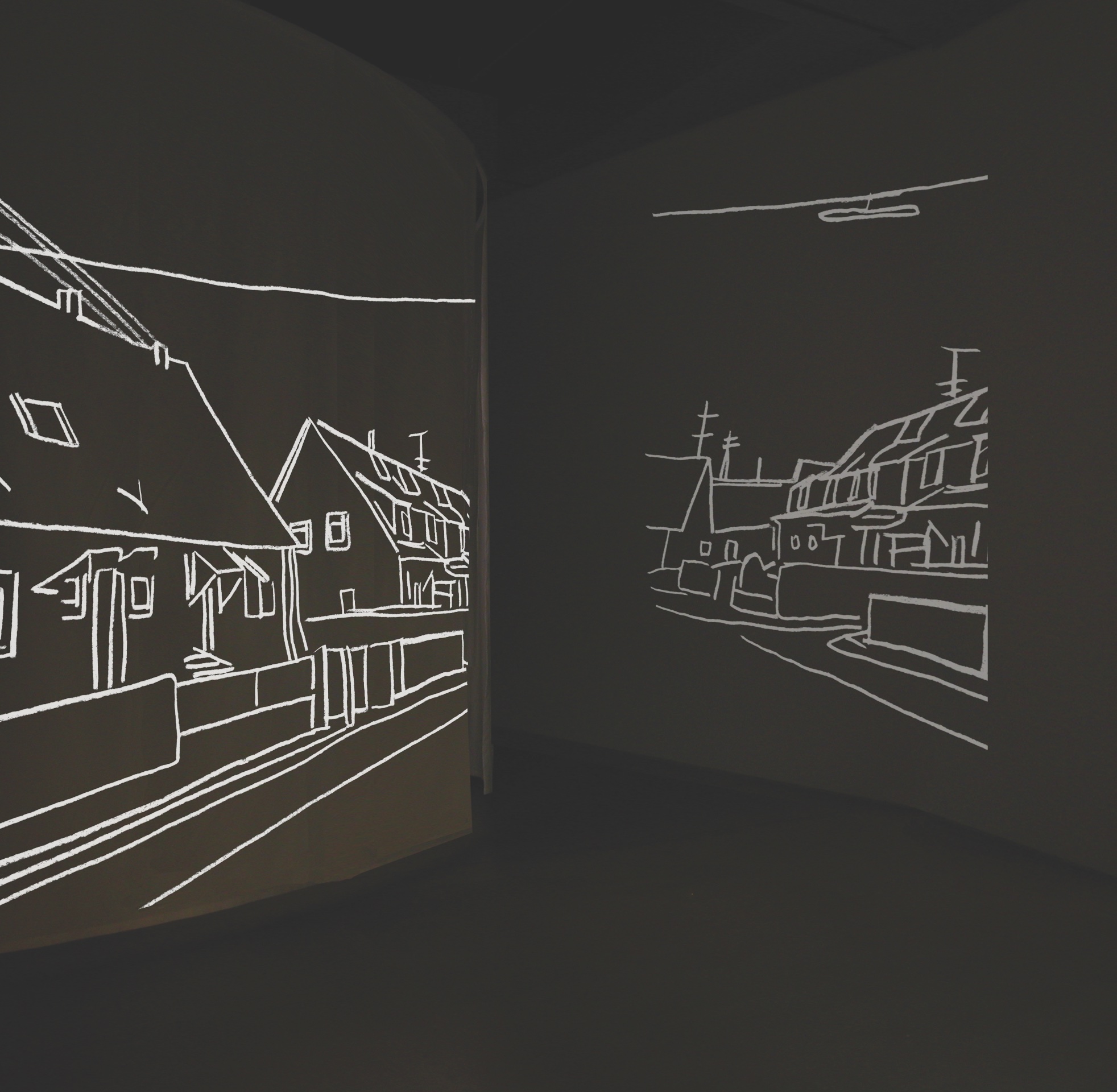
Michaela Melián
Föhrenwald
2005
Double slide projection with sound, 160 slides + 1 CD (Master), 59:35 mins
Photo courtesy of Galerie Barbara Gross, Munich, and Michaela Melián
Printed with kind permission
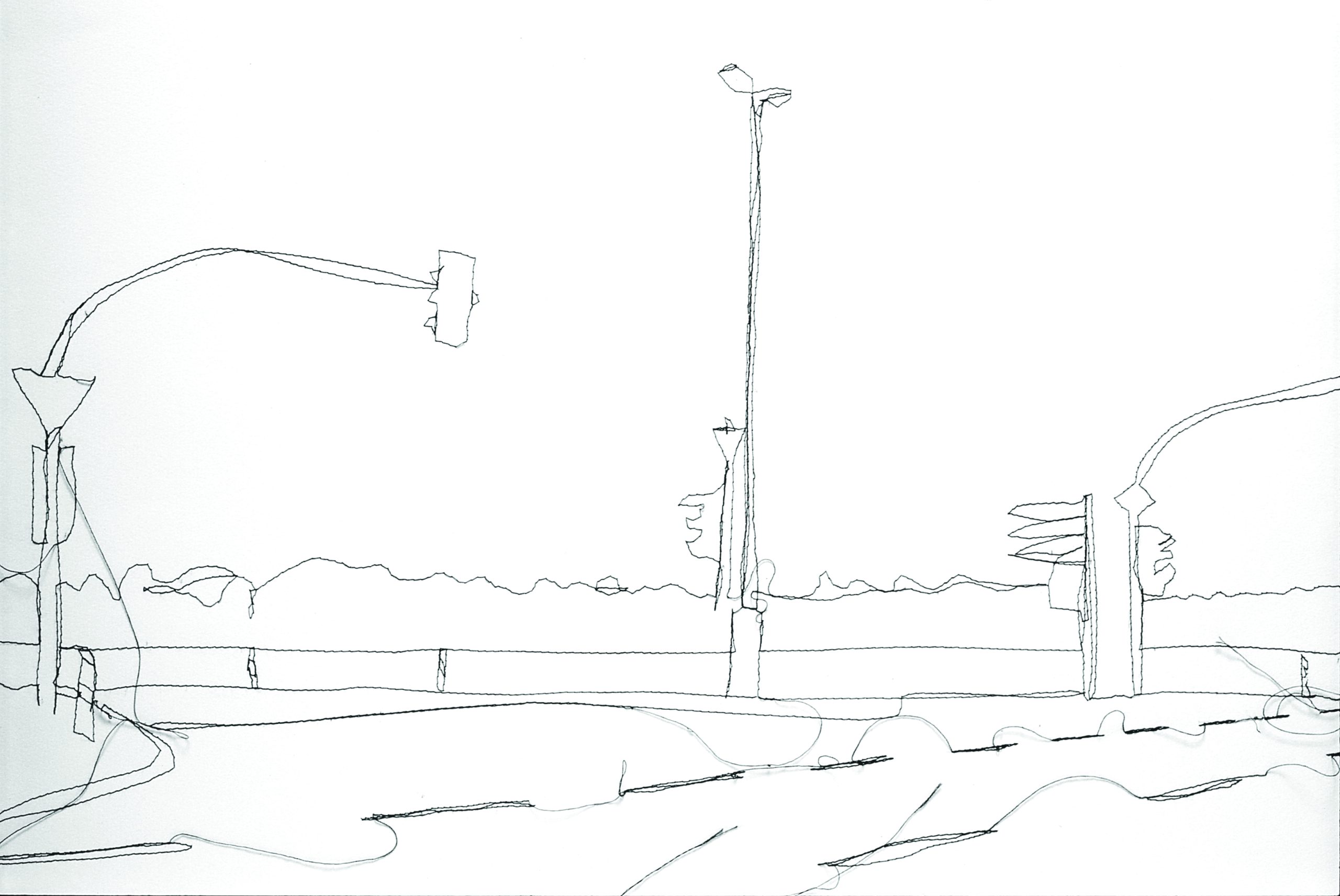
Michaela Melián
Straße
2003
Sewn drawing, thread, paper
42 x 56 cm
Photo courtesy of Galerie Barbara Gross, Munich, and Michaela Melián
Printed with kind permission
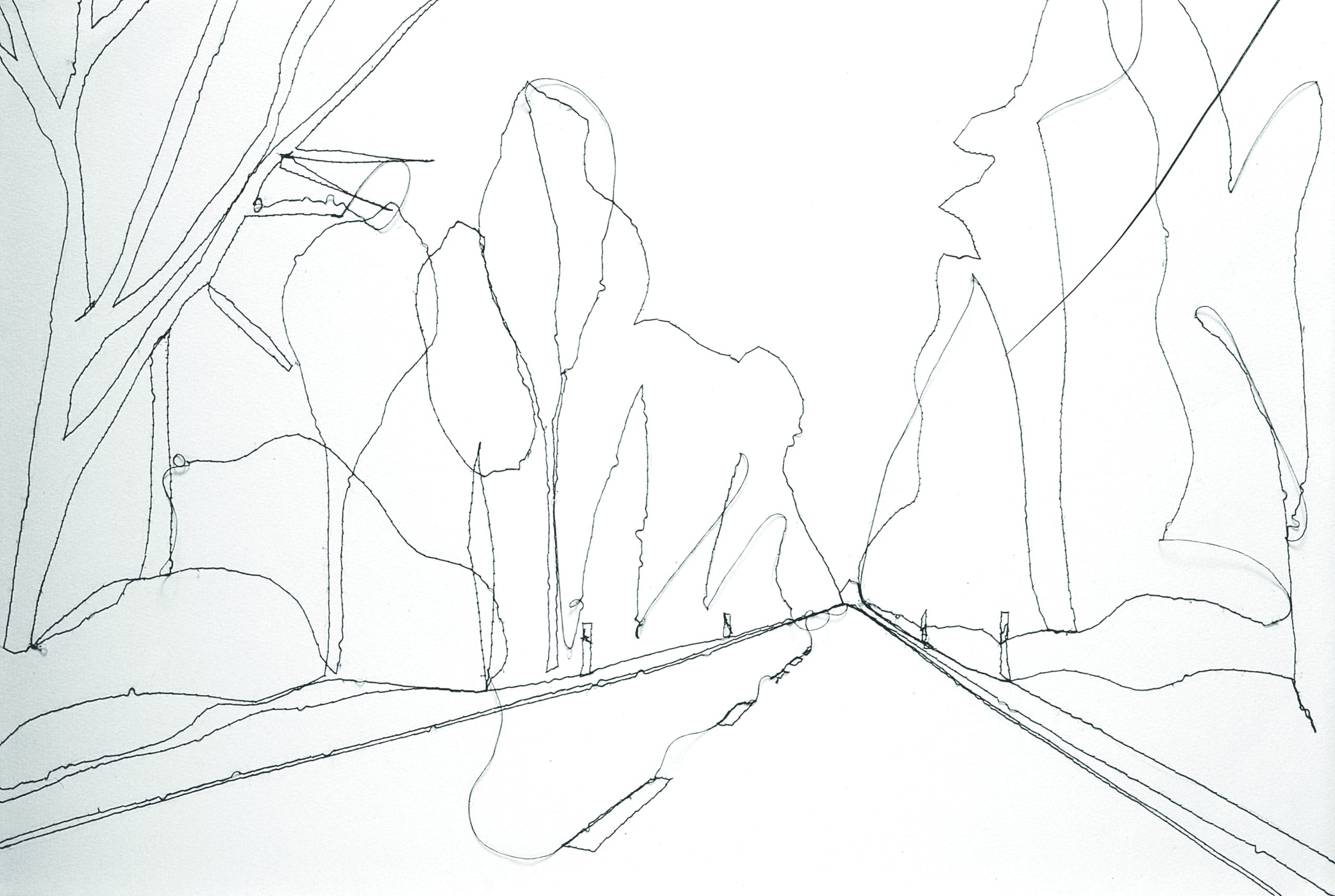
Michaela Melián
Straße
2003
Sewn drawing, thread, paper
42 x 56 cm
Photo courtesy of Galerie Barbara Gross, Munich, and Michaela Melián
Printed with kind permission
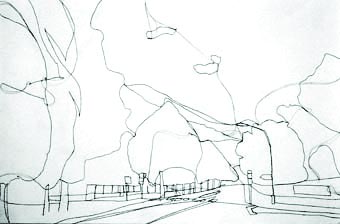
Michaela Melián
Straße
2003
Sewn drawing, thread, paper
42 x 56 cm
Photo courtesy of Galerie Barbara Gross, Munich, and Michaela Melián
Printed with kind permission
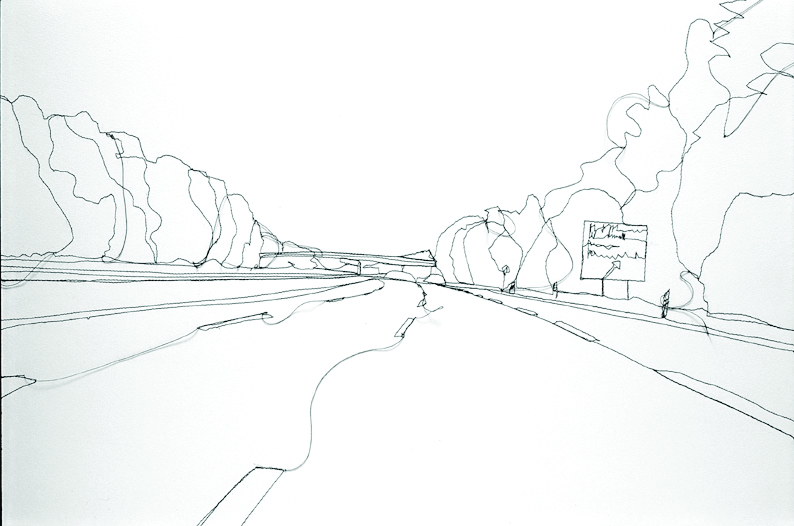
Michaela Melián
Straße
2003
Sewn drawing, thread, paper
42 x 56 cm
Photo courtesy of Galerie Barbara Gross, Munich, and Michaela Melián
Printed with kind permission
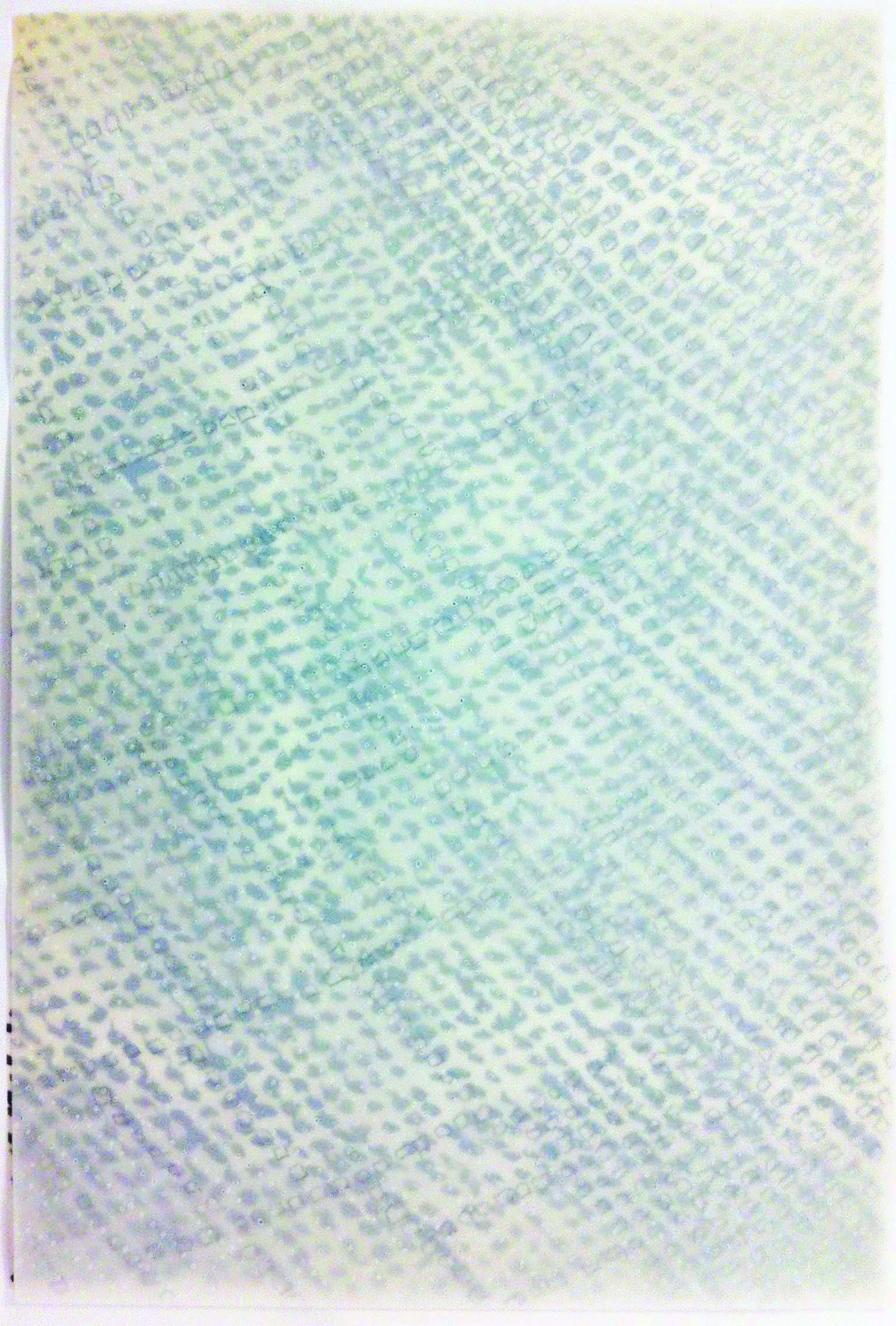
Michaela Melián
Speicher
2008
Three-layered parchment paper
42 x 30 cm
Photo courtesy of Galerie Barbara Gross, Munich, and Michaela Melián
Printed with kind permission
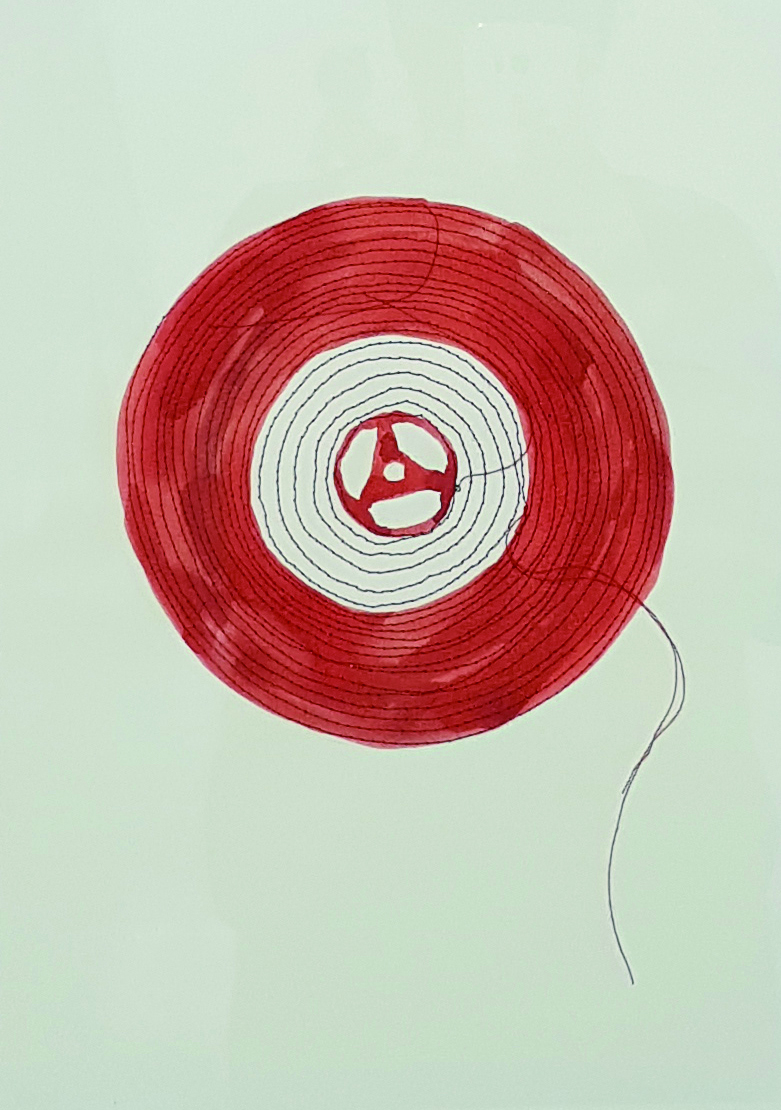
Michaela Melián
Single (Rot)
2013
Ink and thread on paper
36 x 25 cm
Photo courtesy of Galerie Barbara Gross, Munich, and Michaela Melián
Printed with kind permission

Michaela Melián
Föhrenwald
2005
Double slide projection with sound, 160 slides + 1 CD (Master), 59:35 mins
Edition of 5
Photo courtesy of Galerie Barbara Gross, Munich, and Michaela Melián
Printed with kind permission
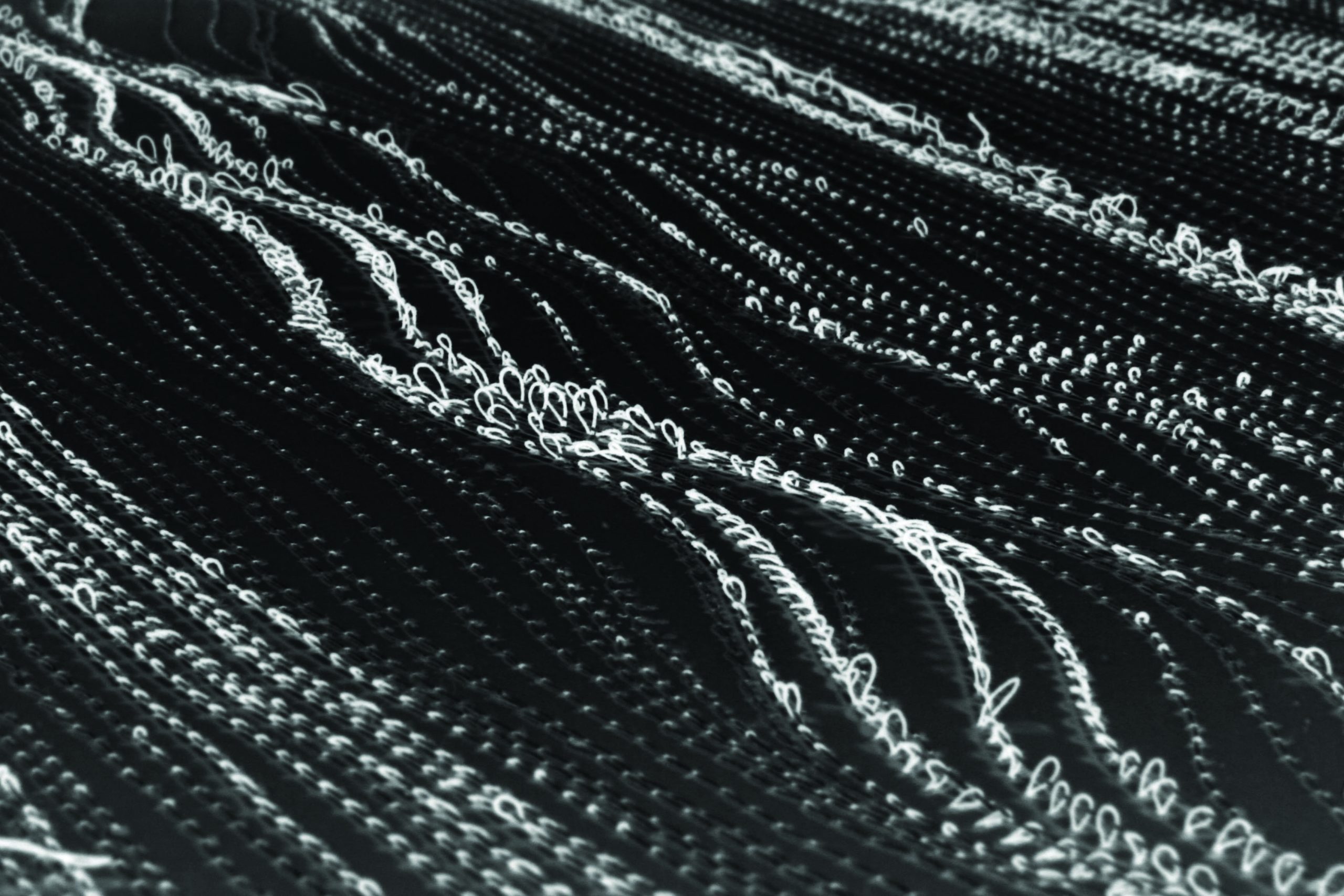
Michaela Melián
Speicher
2008
Still from video and sound installation, DVD, format 4:3, with soundtrack in German/English, 53 mins
Edition of 5
Photo courtesy of Galerie Barbara Gross, Munich, and Michaela Melián
Printed with kind permission
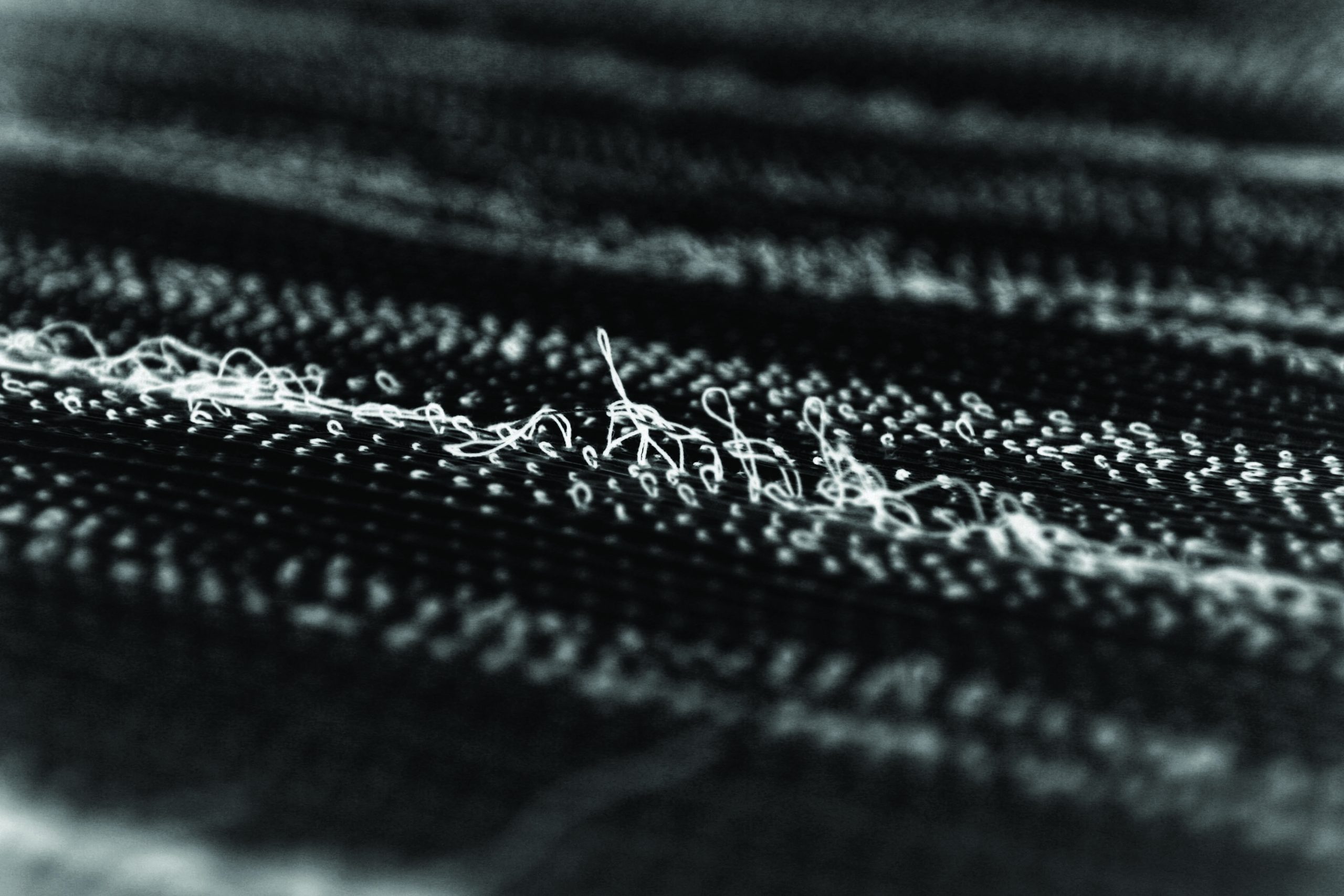
Michaela Melián
Speicher
2008
Still from video and sound installation, DVD, format 4:3, with soundtrack in German/English, 53 mins
Edition of 5
Photo courtesy of Galerie Barbara Gross, Munich, and Michaela Melián
Printed with kind permission
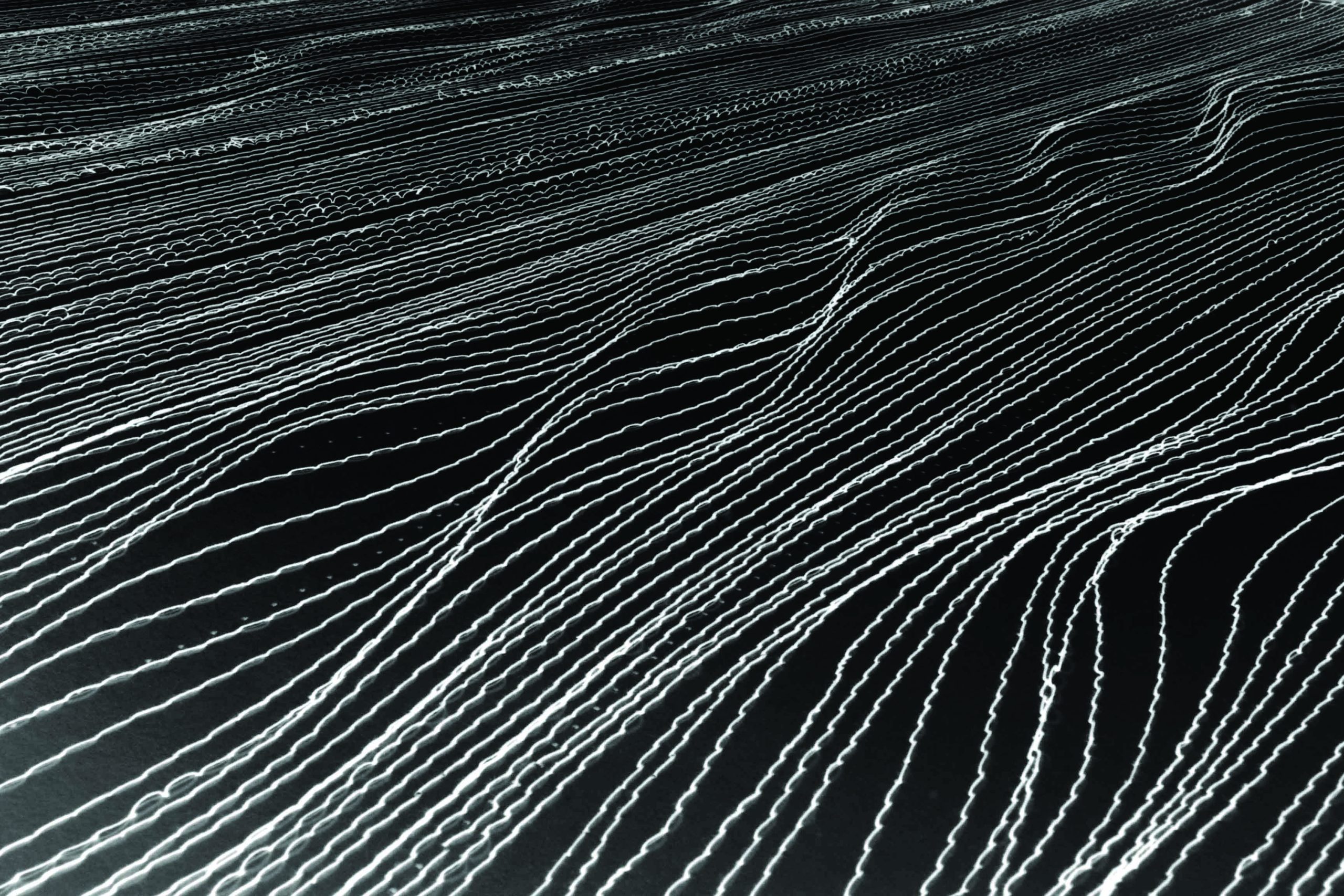
Michaela Melián
Speicher
2008
Still from video and sound installation, DVD, format 4:3, with soundtrack in German/English, 53 mins
Edition of 5
Photo courtesy of Galerie Barbara Gross, Munich, and Michaela Melián
Printed with kind permission

Michaela Melián
Speicher
2008
Still from video and sound installation, DVD, format 4:3, with soundtrack in German/English, 53 mins
Edition of 5
Photo courtesy of Galerie Barbara Gross, Munich, and Michaela Melián
Printed with kind permission

Michaela Melián
Speicher
2008
Video and sound installation, DVD, format 4:3, with soundtrack in German/English, 53 mins
Edition of 5
Installation view at Lentos Kunstmuseum Linz, Austria, 2009
Photo courtesy of Galerie Barbara Gross, Munich, and Michaela Melián
Printed with kind permission
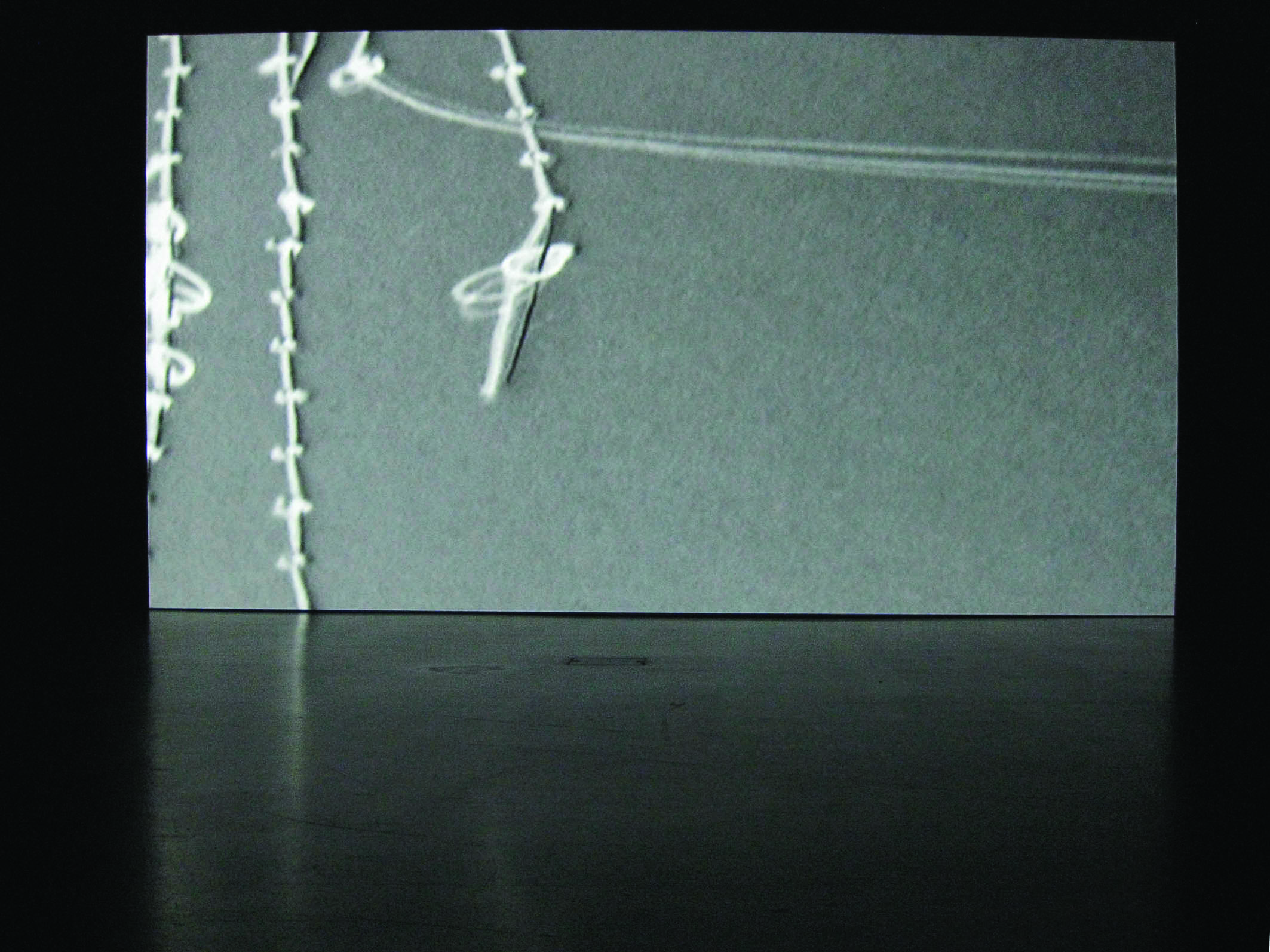
Michaela Melián
Speicher
2008
Video and sound installation, DVD, format 4:3, with soundtrack in German/English, 53 mins
Edition of 5
Installation view at Lentos Kunstmuseum Linz, Austria, 2009
Photo courtesy of Galerie Barbara Gross, Munich, and Michaela Melián
Printed with kind permission

Michaela Melián
Speicher
2014
Thread, paper
56 x 42 cm
Photo courtesy of Galerie Barbara Gross,
Munich, and Michaela Melián
Printed with kind permission

Michaela Melián
Speicher
2014
Thread, paper
56 x 42 cm
Photo courtesy of Galerie Barbara Gross,
Munich, and Michaela Melián
Printed with kind permission
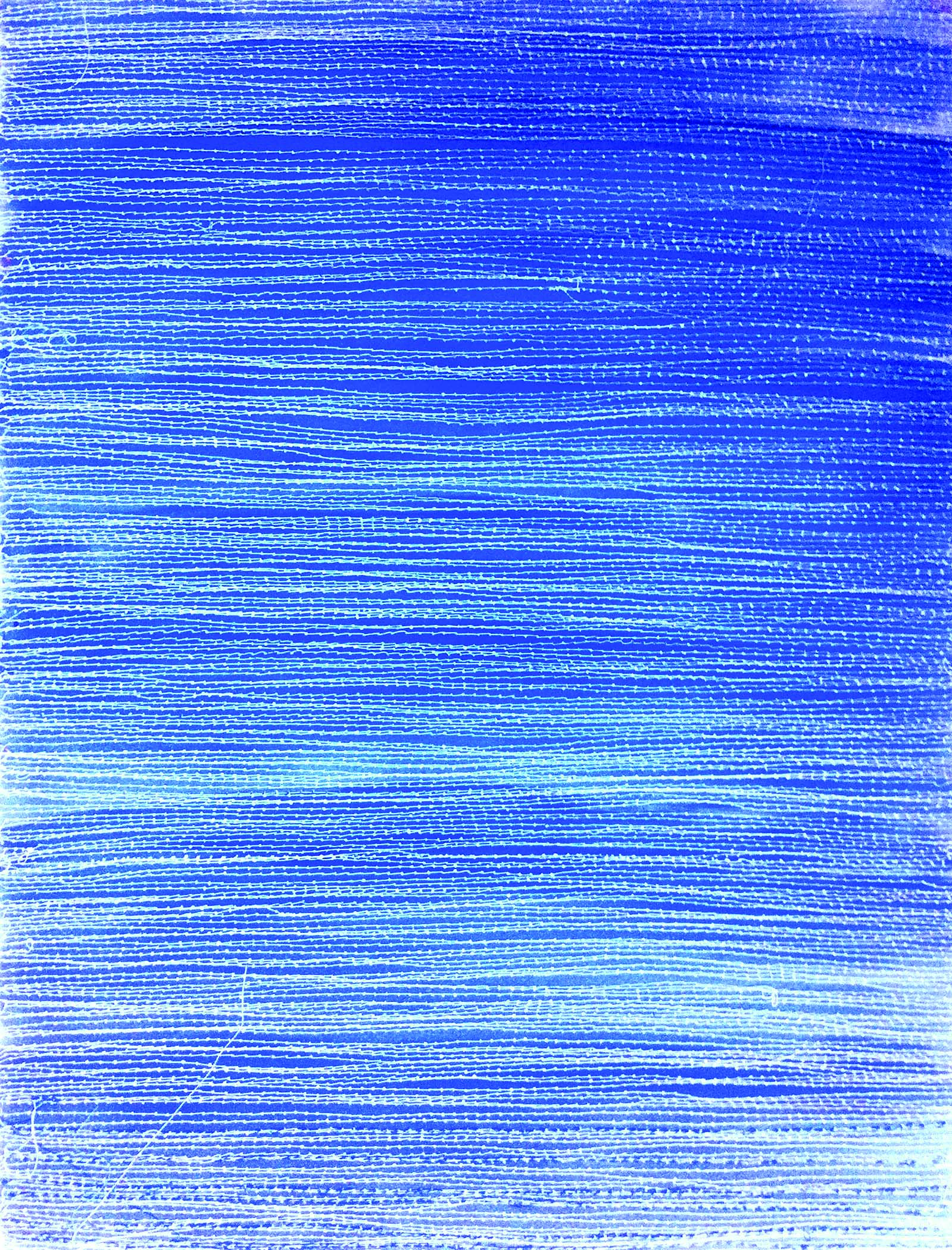
Michaela Melián
Speicher
2008
Thread, paper
56 x 42 cm
Photo courtesy of Galerie Barbara Gross,
Munich, and Michaela Melián
Printed with kind permission
Footnotes
1 “Art as Device (1917)” 6
2 “‘This Strange Institution called Literature,’ An Interview with Jacques Derrida (1989)” 63
3 “The Function of Paris”
4 Notes Toward a Performative
Theory of Assembly
5 ‘Qu’est-ce qu’un auteur?’ 820
6 The Arcades Project
7 Civilization and its Discontents 17
8 “Aus dem Lesebuch für Städtebewohner” 157
9 Francke, “Blicke auf Straßen” 11-12
10 “Über den Begriff der Geschichte,” 696
11 Ferry
12 “Kommentare zu den Gedichten von Brecht”
References
Benjamin, Walter. “Kommentare zu den Gedichten von Brecht (1939).”Gesammelte Schriften, Vol. II, edited by Rolf Tiedemann and Hermann Schweppenhäuser, and translated by the author, Nils Plath. Frankfurt/Main: Suhrkamp, 1977.
———. The Arcades Project (1927-1940), translated from the German by Howard Eiland and Kevin McLaughlin. Cambridge: Harvard, 2002.
———. “Über den Begriff der Geschichte (1940).” Gesammelte Schriften, Vol. I, edited by Rolf Tiedemann and Hermann Schweppenhäuser, and translated by the author, Nils Plath. Frankfurt/Main: Suhrkamp, 1977, pp. 691–704.
Brecht, Bertolt. “Aus dem Lesebuch für Städtebewohner (1930).” Werke, Vol. 11, Gedichte Vol. I, 1918-1938, edited by Werner Hecht, Jan Knopf, Werner Mittenzwei, Kalus-Detlef Müller. Translated by the author, Nils Plath. Frankfurt/Main: Suhrkamp, 1988.
Butler, Judith. Notes Toward a Performative Theory of Assembly, Cambridge: Harvard University Press, 2015.
Derrida, Jacques. “‘This Strange Institution called Literature,’ An Interview with Jacques Derrida (1989).” Acts in Literature. Edited by Derek Attridge and translated from French by Geoffrey Bennington and Rachel Bowlby. New York: Routledge, 1992.
Ferry, Brian. “Remake/Remodel.” Roxy Music. E.G. Records, 1972.
Franke, Manfred. “Blicke auf Straßen.” Strassen und Plätze. Gütersloh: Mohn, 1967, pp. 7–12. Translated by the author, Nils Plath.
Freud, Sigmund. Civilization and its Discontents (1930), translated from the German by James Strachey. New York: Norton, 1962.
Lacan, Jacques and Foucault, Michel. “‘Qu’est-ce qu’un auteur?’ Conférence. Compte rendu de la séance 1969.” Dits et Écrits, Vol. I, by Michel Foucault and edited by Daniel Defert, François Ewald, and Jacques Lagrande. Paris: Gallimard, 1994, pp. 789–821.
Shklovsky, Victor. “Art as Device (1917).” Theory of Prose. Translated from Russian by Benjamin Sher. Champaign: Dalkey Archive Press.
Valéry, Paul. “The Function of Paris (1927).”Reflections on the World Today. Translated from French by Francis Scarfe. New York: Pantheon, 1948.
Exhibition
Disintegration Loops An Exhibition in Print
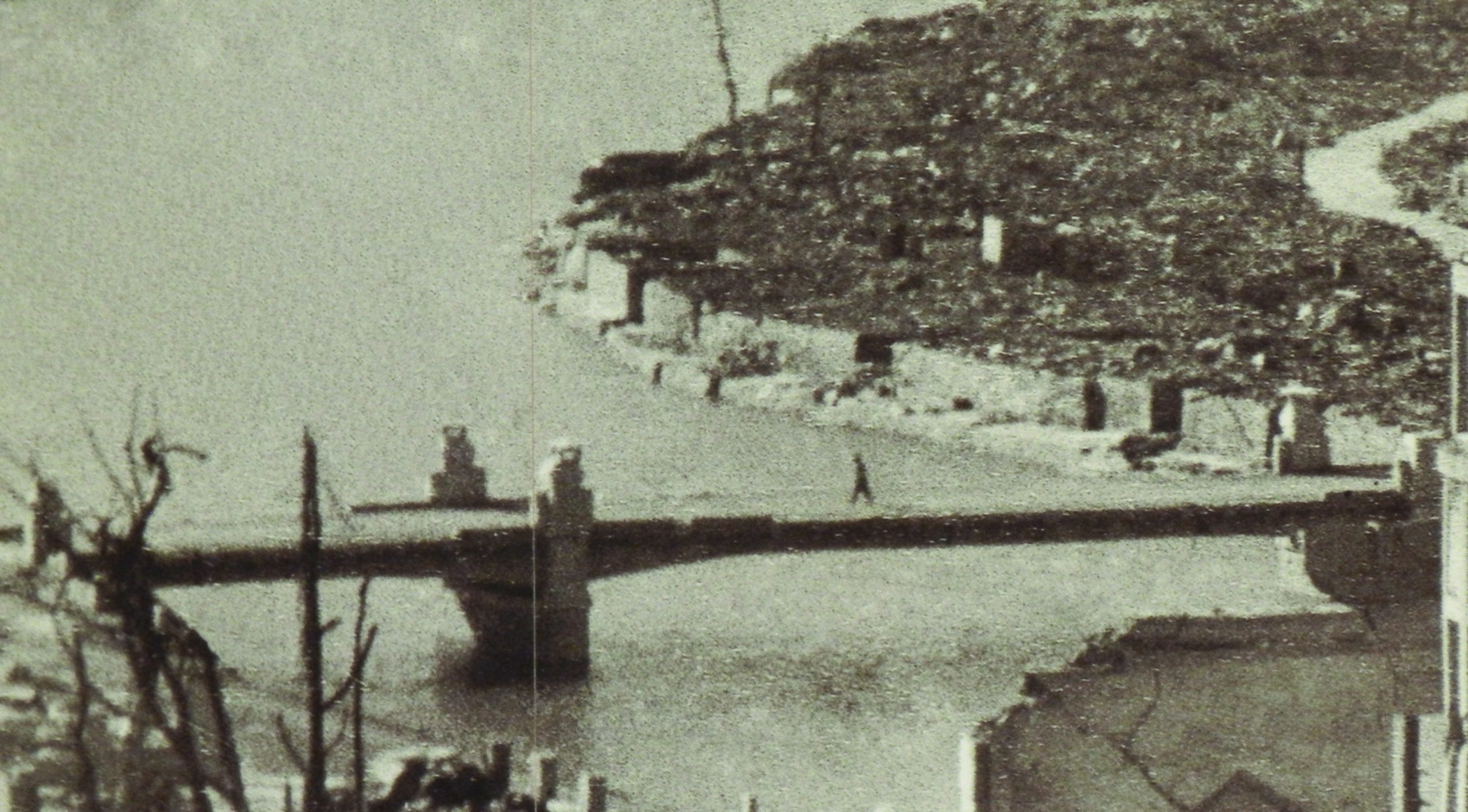
Sam I-shan. Disintegration Loops. In ISSUE 08: Erase. Singapore: LASALLE
College of the the Arts, 2019. pp. 107-137.
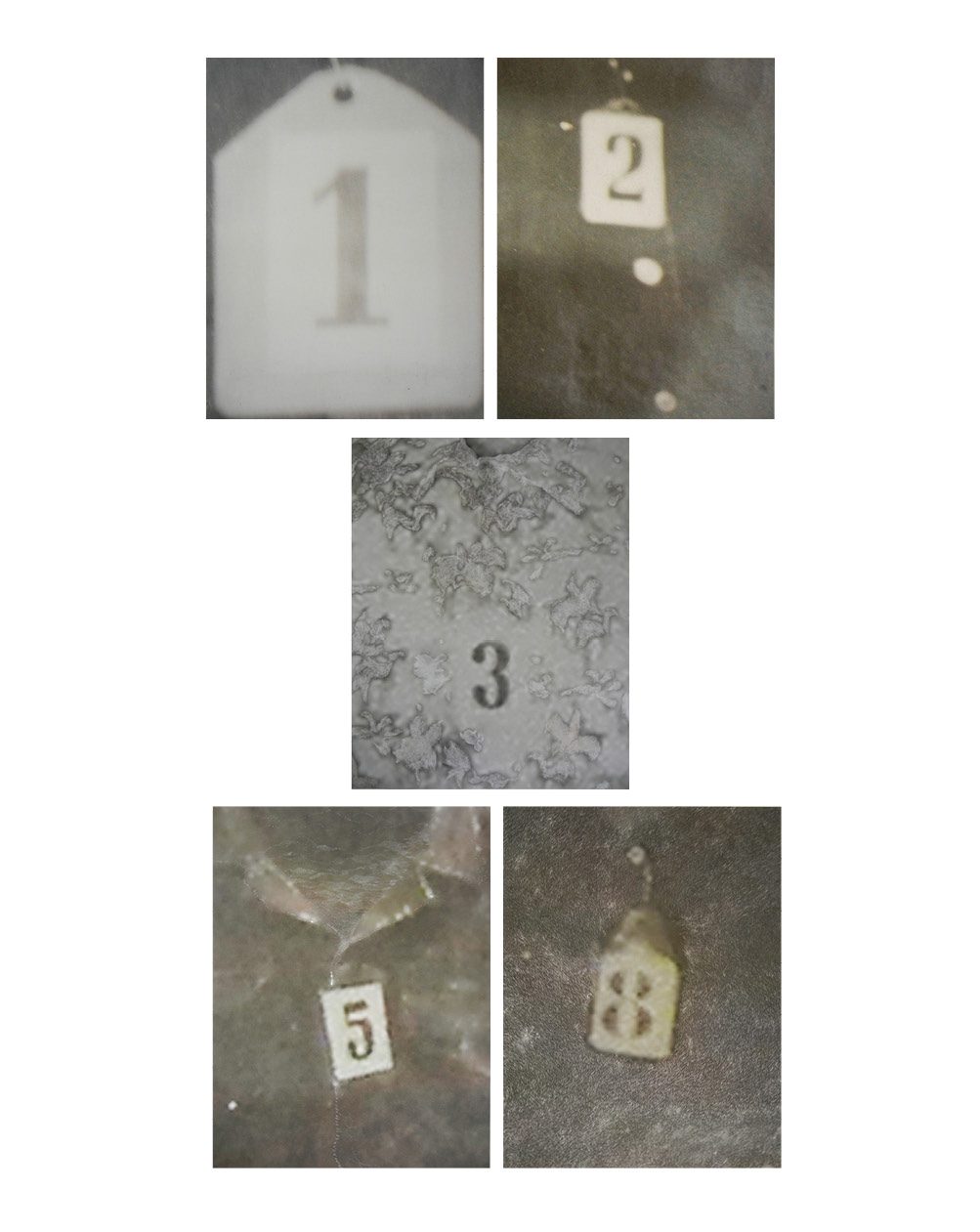
Page 107
Ivy Ma, Walking Towards, 2012, Pastel, graphite, printed ink on archival paper, 94 x 170 cm

page 108-109
Ivy Ma, Numbers Standing Still, 2012
Pastel, graphite, printed ink on archival paper (set of 11)
78.6 x 60 cm (each)
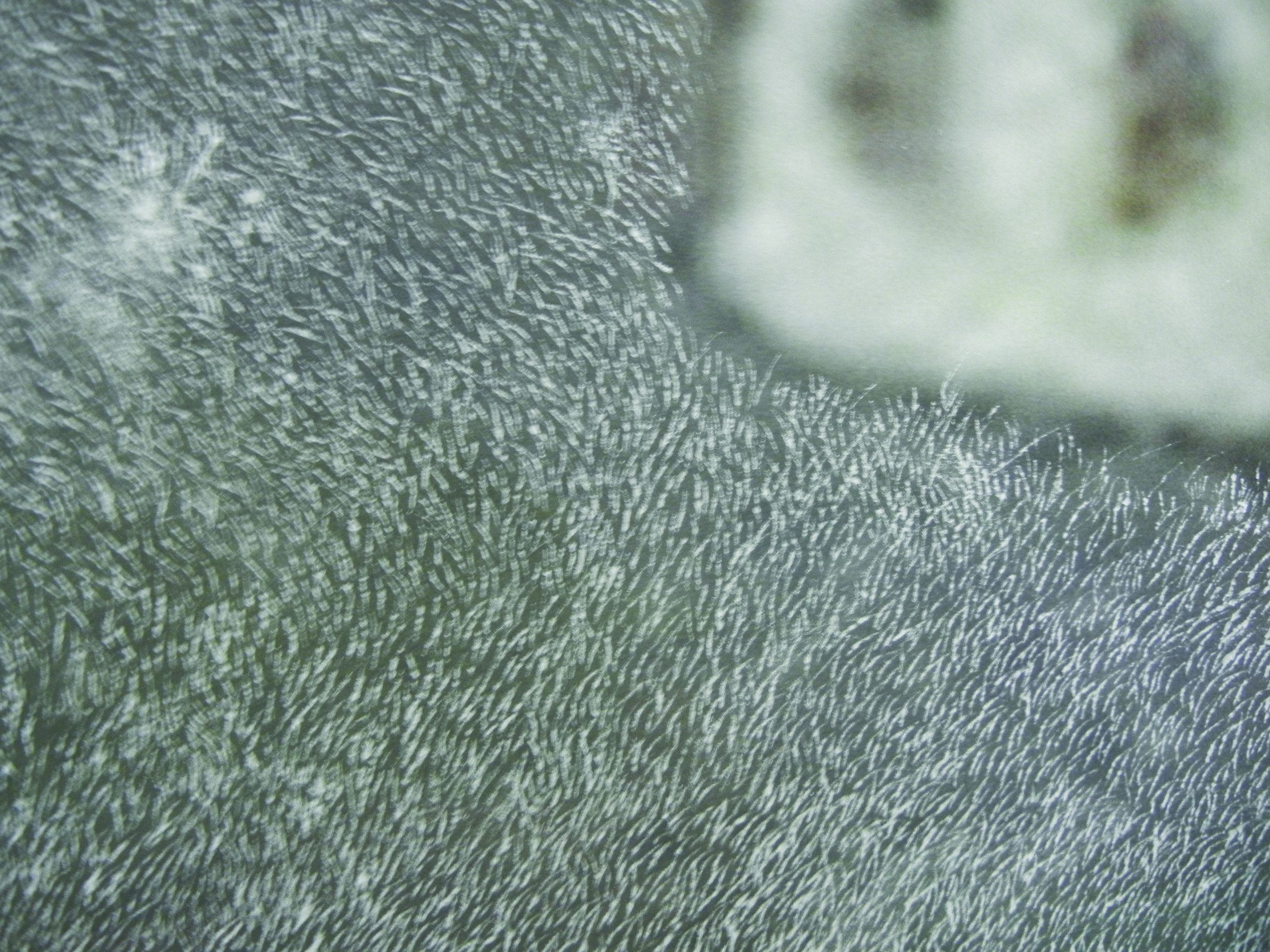
Ivy Ma, Numbers Standing Still (detail), 2012
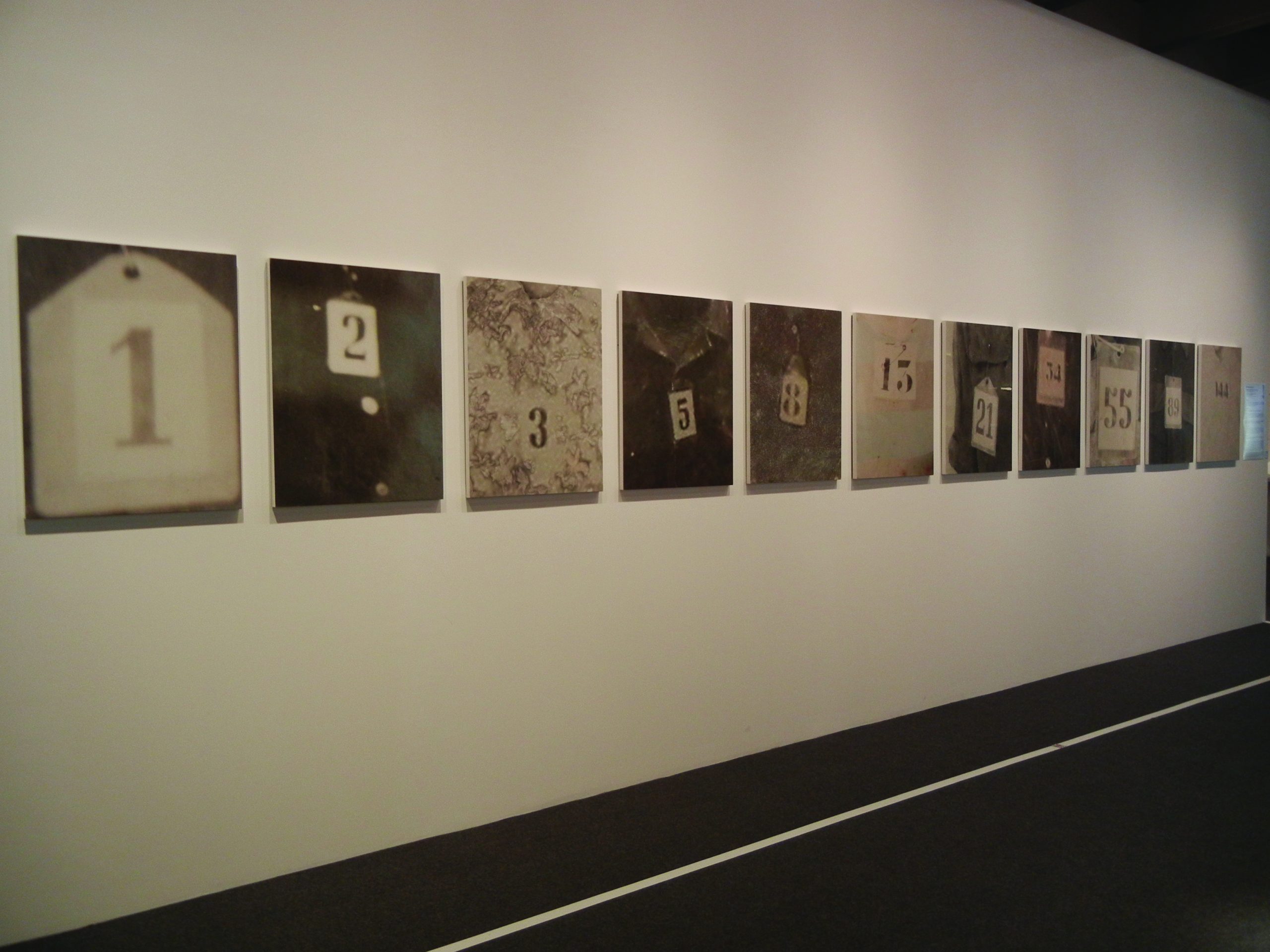
Ivy Ma, Numbers Standing Still. Installation view at Hong Kong Museum of Art
Image courtesy of the artist and Hong Kong Museum of Art
Ivy Ma
Numbers Standing Still
2012
Ivy Ma (b. 1973, Hong Kong) works with images from archival and cinematic sources and creates “drawing interventions”—an elaborate process of erasing and drawing into and over existing images. The images she works on are themselves fragmented or indistinct, and possess transient details such as discarded objects or empty spaces. These visual representations and modifications of purposefully “minor” histories that parallel established records, suggest a history of forgotten things that inform and direct our lives as much as any grand narrative. Her work has been exhibited in Hong Kong, Japan, Taiwan and China, and she has participated in artists’ residencies in San Francisco, New York and Helsinki.
The source images of Ivy Ma’s series Numbers Standing Still are from the Security 21 Prison (S-21), formerly the Tuol Seng in Phnom Penh, Cambodia, and are based on the photographs that Khmer Rouge cadres took of each prisoner upon their arrival before they were sent on to interrogation, torture, and in almost every case, death. The prison operated from 1976 to 1979, and was methodically run, with every prisoner numbered, and their appearance, measurements and confessions meticulously documented with images and written records. Out of the 15,000 committed to the prison, a mere 14 persons are known to have survived, and the photographs that remain serve as a critical commemoration of the victims of the Khmer Rouge regime.
Ma’s allusion to this grim history is elliptical. She re-photographed selected prints displayed in the prison—now a genocide museum—and strategically cropped them to remove contextual evidence, then used techniques of scraping and mark-making to further obscure their figurative meaning. In particular, her intervention removes one of the striking aspects of the source photographs: the face of the victim. The face is assumed to be indexical to identity and personhood in the same way that causal links are inferred between reality and a photographic image. Instead, her photographs are composed so as to focus on the number tags given to each prisoner, with only the appearance of collars, buttons or a sleeve in the images suggesting that each tag is pinned to or hung somewhere on a person’s upper body. She marked and modified the surface of each image with pastel and graphite, and arranged the selected numbers into the order “1, 2, 3, 5, 8, 13, 21, 34, 55, 89, 144.” First described by mathematicians on the Indian subcontinent c. 400 BCE, these numbers have been called the Fibonacci sequence after Italian mathematician Leonardo of Pisa published them in 1202. Each subsequent number in the sequence is the sum of the two preceding it, and this pattern can be read from mathematical models of naturally spiralling forms such as snail shells, flowers and galaxies, and has many applications in art, architecture and music.
Ma’s series delicately posits several simultaneities: it acknowledges the role of photography as powerful visual evidence while alluding to its limits in the revelation of truths; and it is also a double decontextualising, recognising the reality of individual victims, while forestalling the viewer’s ability to voyeuristically view their identities. The question of the viewer’s gaze in relation to these photographs is not an easy one to address. The sheer number of prisoner images in the Tuol Sleng archive, and the way that they have often been presented en masse, whether at the genocide museum, or in other publications or institutional settings, has always been rife with complications. The affective power of these images mean that any display often focusses on their genuinely emotive qualities as visual remnants of atrocity, instead of providing sufficient and proper historical, social or biographical context about the conditions of their production as photographic artefacts.
Ma’s treatment of these source photographs may be read as a head-on tackling of this problem of decontextualising: by removing and obscuring even more visual information than the displays themselves already do, she has abstracted the image down to the barest signifier of this historical moment. The numbers, which were originally assigned by prison authorities as a logistical convenience and to categorically dehumanise the prisoners, take on the moral weight of human tragedy when they are recursively considered, as the sequence that they are presented in implies the sheer number of victims under the abominable practices of the Khmer Rouge regime, and suggests how the single-minded and relentlessly efficient pursuit of a position can result in disaster when taken to its logical extreme. Indeed, while the numbers of those tortured and killed at Tuol Sleng have been well-documented, it is not as widely known that just around a fifth of all those brought to the prison were ordinary citizens, and many of the remaining were Khmer Rouge cadres who were themselves imprisoned and killed when the revolution began to turn in on itself, eliminating through a series of violent purges tens of thousands of its own from all ranks of the army, commune, provincial and governmental administration. By reading the Fibonacci sequence into these genocidal acts, Ma suggests how evil can build upon evil, and exponentially multiply.
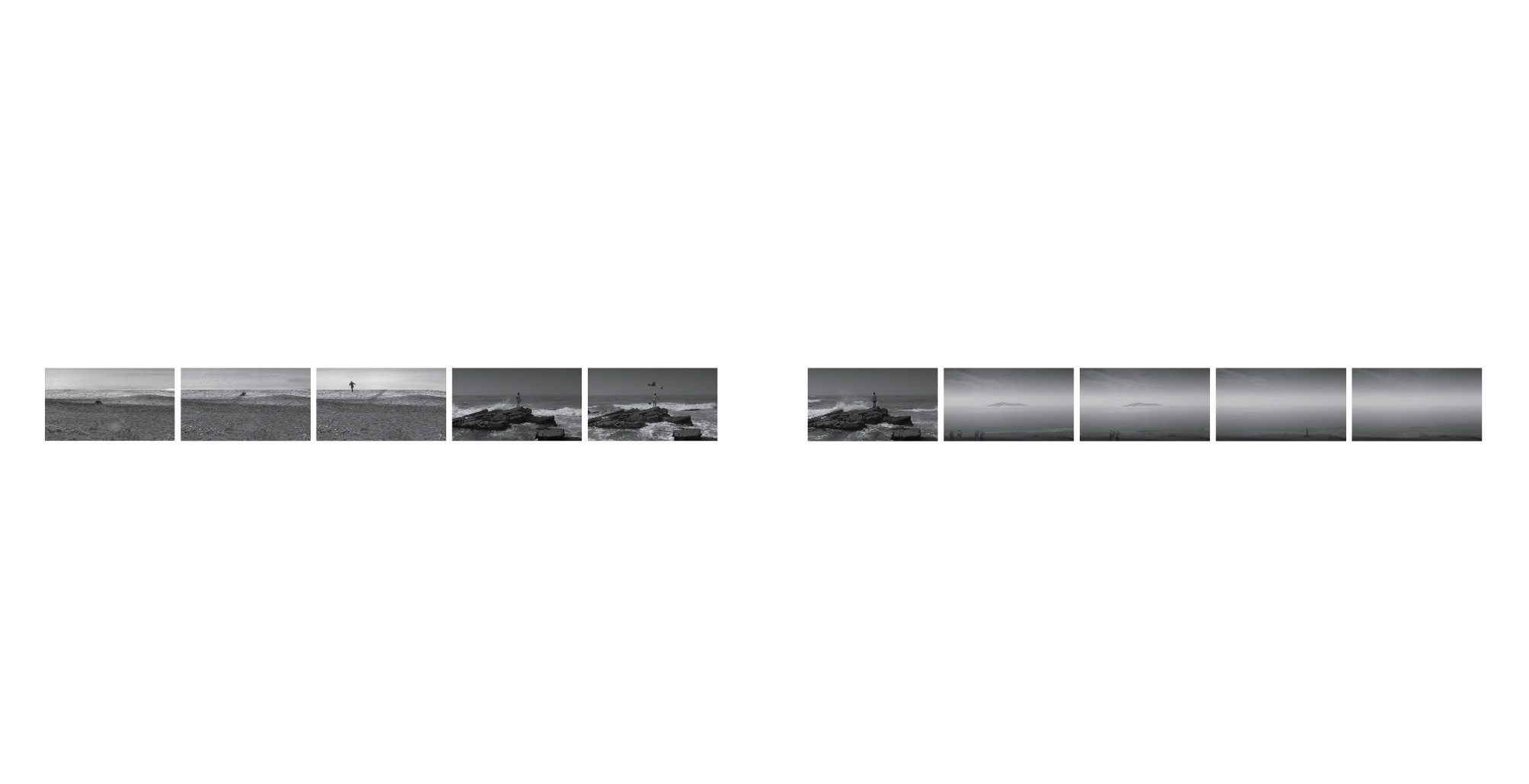
Han Ishu, Form of Sea (detail), 2012
3-channel HD video installation, 5:03 mins, black and white, sound
Images courtesy of the artist
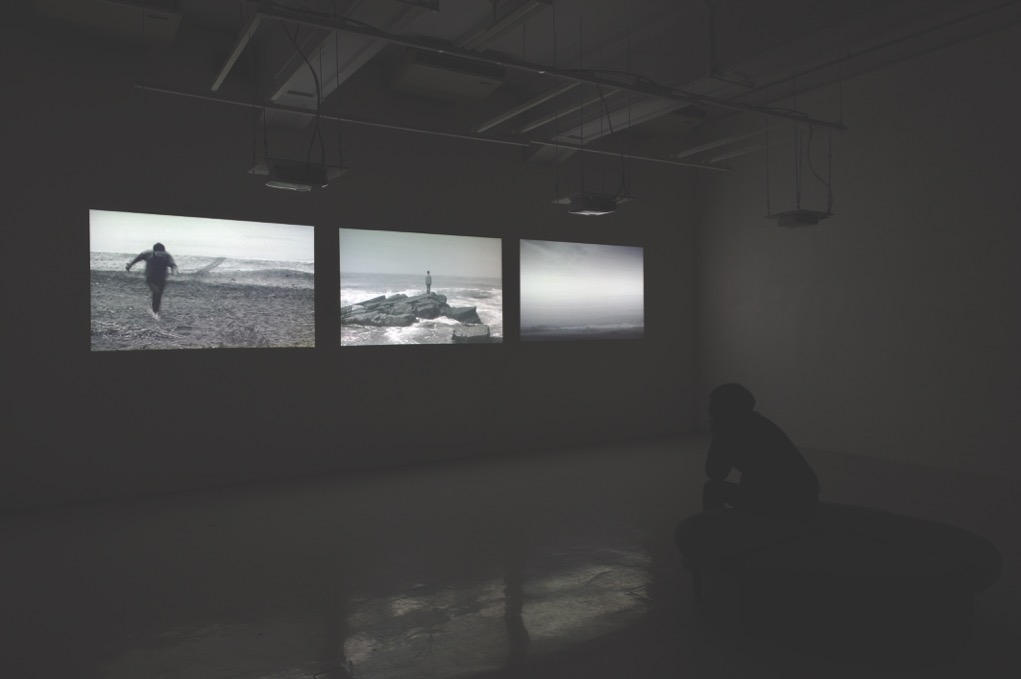
Han Ishu, Form of Sea. Installation view at Kyoto Art Centre
Image courtesy of the artist and Kyoto Art Centre

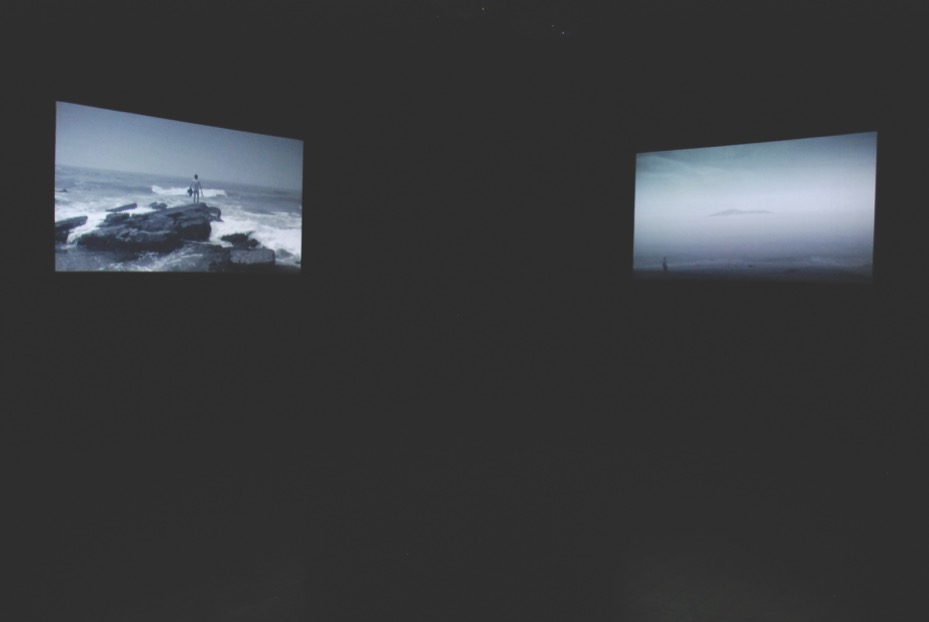
Han Ishu, Form of Sea. Installation view at Japan Media Arts Festival
Image courtesy of the artist
Han Ishu
Form of Sea
2012
Han Ishu (b. 1987, Shanghai, China) lives and works in Tokyo, Japan. His films, video installations, performances and photography raise questions of national and territorial identities, and explore the contingent role of cultural and popular iconography in socio-political contexts. His works have been featured in solo exhibitions in URANO Gallery, Tokyo, MoCA Pavilion, Shanghai, Koganecho Site-A Gallery, Yokohama, and in multiple group exhibitions in Japan, the U.S., U.K., Hong Kong, Taiwan and Southeast Asia. He has participated in artist residencies with the Aomori Contemporary Art Centre, International Studio and Curatorial Program New York, and Tokyo Wonder Site, and is a recipient of the Asia Cultural Council Grant, amongst other awards.
Han Ishu has always been connected to port cities: he was born in Shanghai, China, raised in Aomori, Japan, and lives and works in Tokyo. Shanghai’s historical and present-day economic and cultural importance is tied to its status as major trading port and cosmopolitan costal metropolis. Meanwhile, Aomori is the northernmost capital city on the main island of Japan and a major fishing port since the Edo period. The precursor to the current Port of Tokyo, the Edo Port, was one of five opened to foreigners following the signing of the Treaty of Amity and Commerce between Japan and the United States in 1858, which formed the basis for Western economic penetration of Japan and heralded a raft of commercial agreements widely referred to by the Japanese as an “unequal treaty system.” The notion of social identities emerges frequently in Han’s work, and is often explored through the trope of the ocean, particularly in relation to indeterminate, inconstant and contested borders and territories.
Form of Sea is a three-channel work that combines and builds upon three videos that have, in common, a horizon or landscape line that splits the screen, with tiny human figures or terrain relating performatively to the sea. In one of the videos, the artist is shown crawling toward the ocean and remaining in the surf for a while before getting up and running back toward the beach. He endlessly tries to occupy the water but is always forced to retreat back to the land. The grey, grainy totality of each half of the sand and sea mean that the distinction between them is demonstrated primarily by the movement of the figure in relation to the physical line that demarcates them, that is itself always changing as the ebb and flow of the waves sculpt and change the shore.
In the other two videos, the sea fills most of the screen, with the horizon dividing it. One of these works documents a performance by Han, who stands on a rock outcrop and proceeds to remove all his clothing, flinging each piece into the sea. However, the video is shown in reverse, so the clothes seem to return to his body, even as the waves dramatically recede rather than crashing onto the shore. This work was made after the Great East Japan Earthquake of 2011 devastated the Tohoku region (where Aomori is situated), killing more than 20,000 and triggering a nuclear disaster that caused massive damage and destruction. The repeatedly retreating waves in this work appear almost like a poetic counterpoint to the terrifying tsunami that swept away so much, expressing the hopeless but very human wish to avert disaster by representing its reversal.
In the third video, an island floats on the horizon and slowly sinks into the sea as small figures, who appear to be sightseers, watch and take photographs from the shore. Han made this work by filming the seascape and combining it with a three-dimensional rendering of one of the five land masses that make up the Senkaku Islands, which he found on a satellite map. Located in the East China Sea, and equidistant between Japan and Taiwan, they are called Senkaku by the Japanese, Diaoyudao by the Chinese and Diaoyutai by the Taiwanese. With a total area of about seven square kilometres, these uninhabited islands are the site of long-standing territorial disputes between the three countries. Their respective claims are based on varying frames of reference, including older accounts of voyages and discoveries, annals and maps, as well as utilitarian evidence such as land surveys, population registers and treaties. Critical ostensibly because of their proximity to key maritime routes, fishing grounds and possible oil reserves, the islands’ strategic location also means that they would be valuable for any country with ambitions to compete with the United States for military primacy in the Asia-Pacific region. Regardless of the true or perceived value of these islands, governments have also historically made claims of territorial sovereignty so as to signal political priorities to a domestic audience and advance their strategic agendas regionally and internationally. The subtle appearance and disappearance of the island in the video, its inaccessibility underscored by the remote observing human figures, implicitly points at these political sleights of hand, and bring these abstract conflicts back to the materiality of land in a melancholic, muted way.
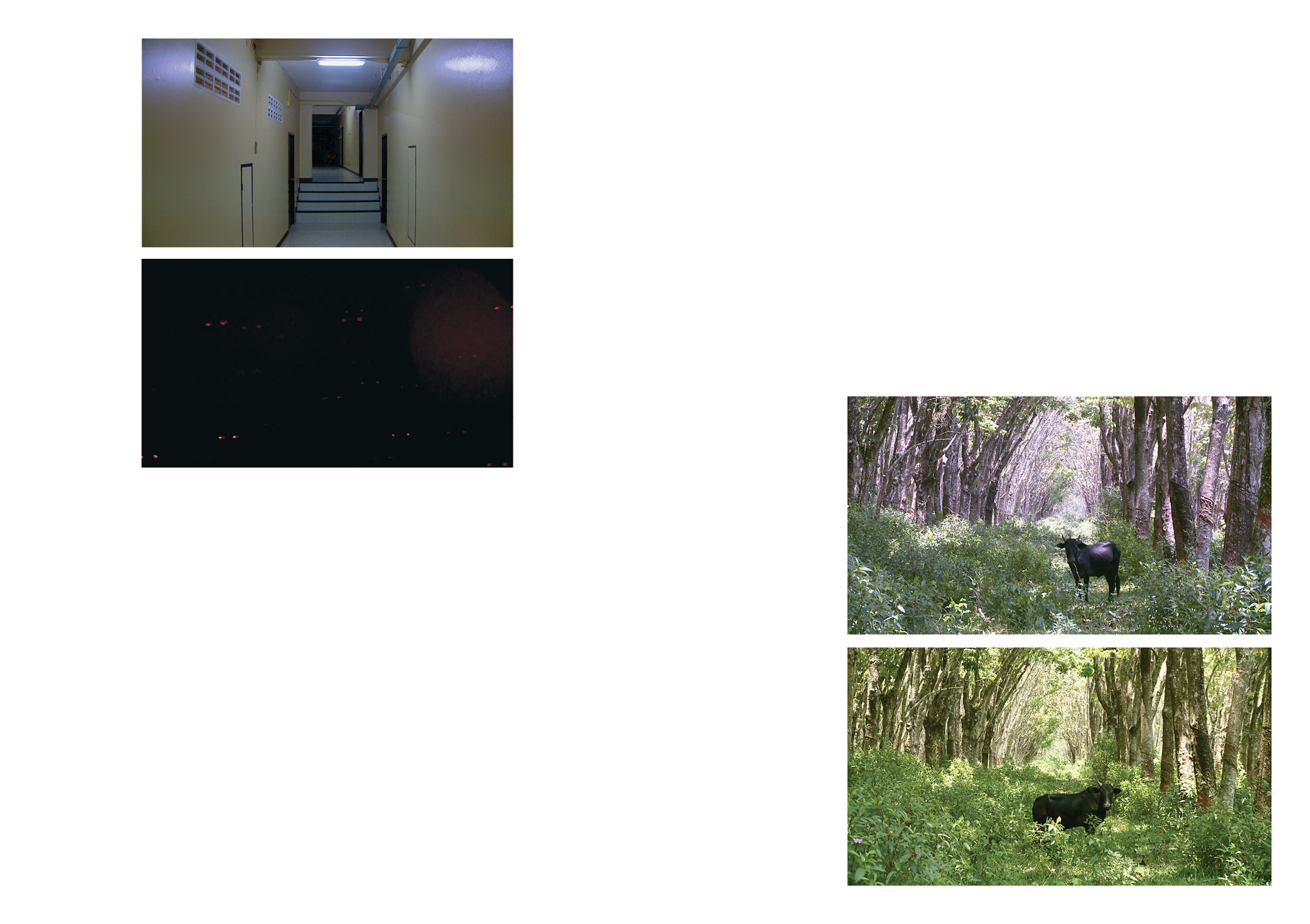
Page 120 - 125
Taiki Sakpisit, Trouble in Paradise (film stills), 2017
HD digital video, sound, colour. Duration: 13:00 mins
Images courtesy of the artist

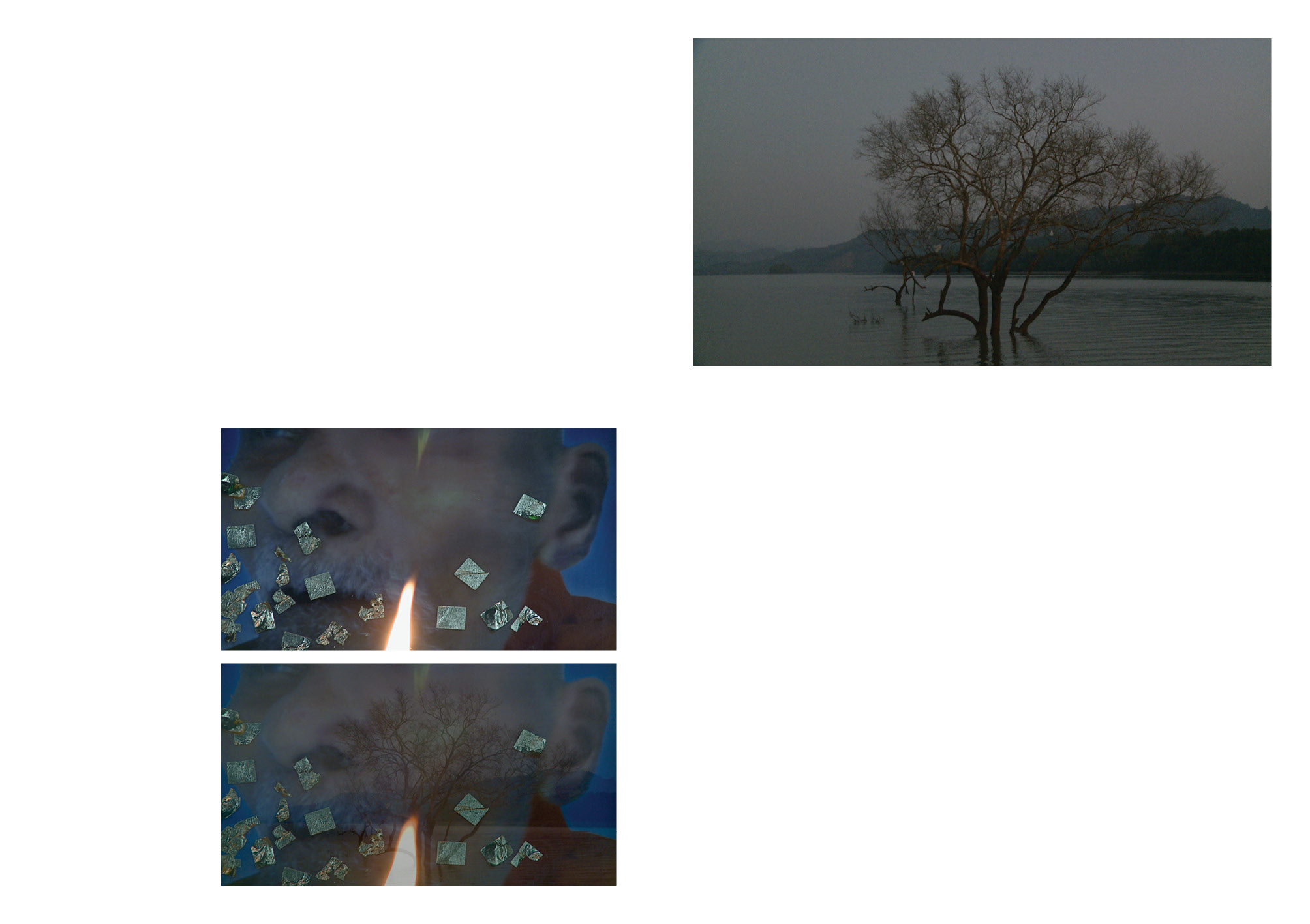
Taiki Sakpisit
Trouble in Paradise
2017
Taiki Sakpisit (b.1975, Japan) lives and works in Bangkok, Thailand. His experimental films and moving image installations explore sites, spaces and moments haunted by personal and historical memory, and feature complex soundscapes made in collaboration with sound designers. With its dense iconographic lexicon, his work often makes elliptical references to the myths and socio-political climate of contemporary Thailand. He has had several solo exhibitions, the most recent at S.A.C. Subhashok The Arts Centre, and his film projects have been shown and awarded at numerous international film festivals.
Taiki Sakpisit’s film works are haunting assemblages with non-linear, sometimes enigmatic narrative structures. His striking images, which are often montaged in extended takes, slow motion and layered dissolves, are accompanied by non-diegetic soundscapes composed by the sound artists he collaborates with. Otherwise, his process of conceiving his films and sourcing archival material, to shooting on location and editing, is primarily a solitary one. The result is a highly personal and densely interwoven universe of visual iconography, formal techniques and aesthetic choices, from which themes related to Thailand’s history, society, religion and politics can be read.
The opening intertitles of Trouble in Paradise1 refer to “being and nothingness, absolute nothingness,” and “the city of no concern, the city of nirvana.” A key aspect of Buddhism is the doctrine of “non-self,” namely the absence of an unchanging soul or essence in every living entity. Nirvana is a state where true emptiness is fully realised; what is understood as conventional reality disappears into this “absolute nothingness.” This textual preamble is followed by the first of several recurring images of tunnel- or path-like spaces in the work. A channel of rock leads into a shadowed cave, seeming to invite the viewer to leave the world of perceivable fact and enter a place of uncertainty where anything might be discovered.
The first of five sections then follows: Summer depicts an anonymous-looking interior corridor with yellow-tinged walls lit by fluorescent light. The season of summer suggests a time of warmth and natural largesse, or youth and fruition, but the artificially-lit stillness and receding shadows of the corridor setting, lined by closed doors that harbour unknown spaces, suggests a man-made foreboding instead. The next section, A Ball, features blue and green points of light that dance across the frame. The camera also catches the flicker of another kind of light that could be a candle flame, or the edge of an eye, or a hand cupping the lens, a presence that is almost always just out of focus. The lights then increase in frequency and distance, changing their scale and intensity to appear like headlights or strobe lights in a distant landscape. The scene then shifts abruptly to one of a forest in broad daylight. This third section, Paradise, shows a buffalo standing in the middle of a narrow clearing formed by a receding line of trees. The images fade to show two or three more of these silent beasts as the soundtrack swells and rises, becoming more urgent, and almost siren-like. The next section, Earth, shows sai sin, or white sacred threads, tied in a grid pattern, looped around a person’s head, or wound around their fingers. During temple ceremonies, these threads link the monks and statues of the Buddha to devotees, with associated merit symbolically passed along the thread from them toward all the people in the temple. When the thread is unbroken or circular, the connection is believed to be more powerful because the circle is continuous. Other devices associated with temple worship, including an image of a monk, pieces of gold leaf, a candle flame and incense are layered atop each other, and gradually dissolve as what appears to be branching veins grow and spread across the monk’s face. However, this is soon revealed to be a leafless tree growing out of a lake and silhouetted against a dark mountain and grey sky, which is also the last chapter in the film, Earth Again, before the screen fades to black.
The hypnotic, droning soundtrack to these images does much to create a dream-like atmosphere, and the way that the sequences build up throughout the film initially suggest a kind of ascension through various pathways toward a condition of idyll, where everything appears to be as it should. Intimations of circularity—from the white sacred threads, or doubled reflections within the frame, or images of water that appear at the beginning and end of the film, appear to describe the kind of equilibrium typically associated with Buddhist world views. However, the unease that lurks within the images, particularly in the way they dissolve into and follow one another, suggest that this state could be one of unresolved limbo rather than harmonious balance. The “trouble” described in the film’s title, and the double presence of “earth” and “earth again,” suggest that the usual process of birth, aging, death, rebirth, and redeath in the cycle of existence has been somehow ruptured, and things are not as they are or could be. The beauty and power of Taiki’s work lies in the oracular possibilities that arise from its rhythmic and intuitive juxtapositions of image and sound. The qualities of disquiet and awe that this creates, and the imaginative associations that are sparked might equally evoke the turbulent cycle of protests, elections and coups that has marked decades of Thai politics, or simply indicate the horror of a cosmos gone awry.
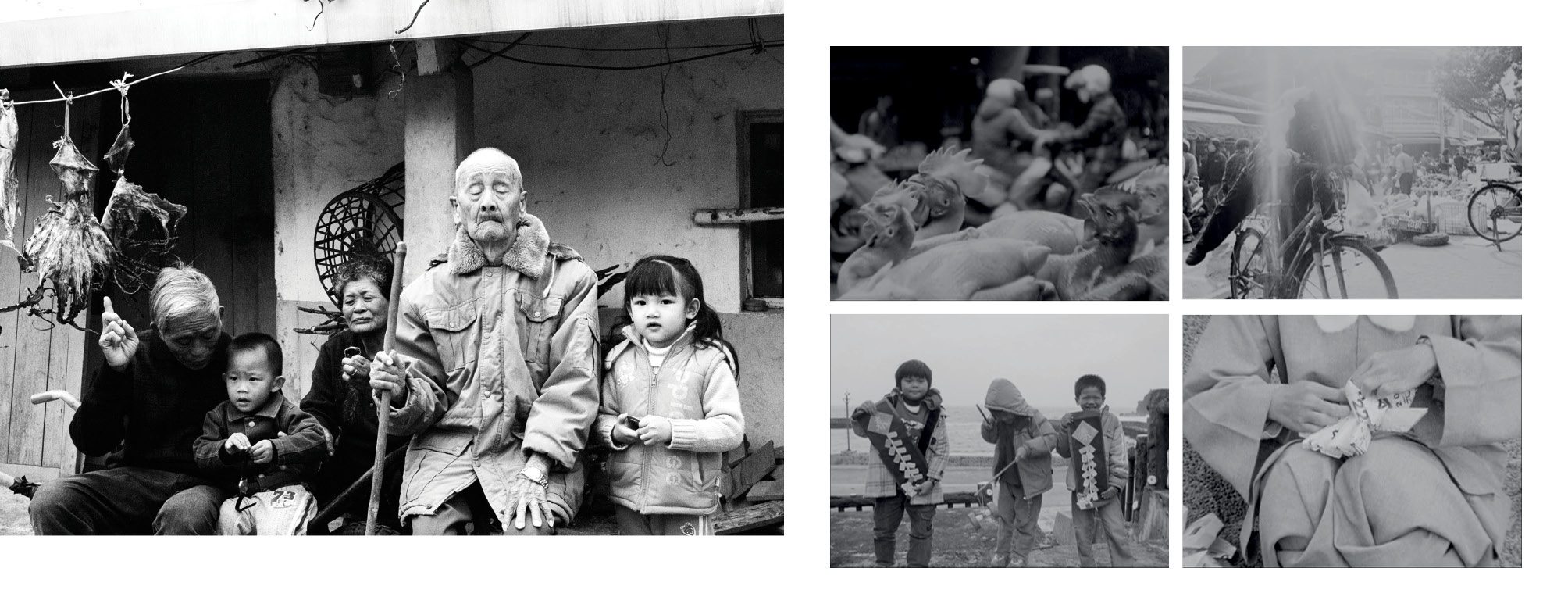
Page 128 - 131
Ye Mimi, They Are There But I Am Not (film stills), 2009
16m film transferred to digital, sound, black and white
Duration: 6:55 mins
Images courtesy of the artist
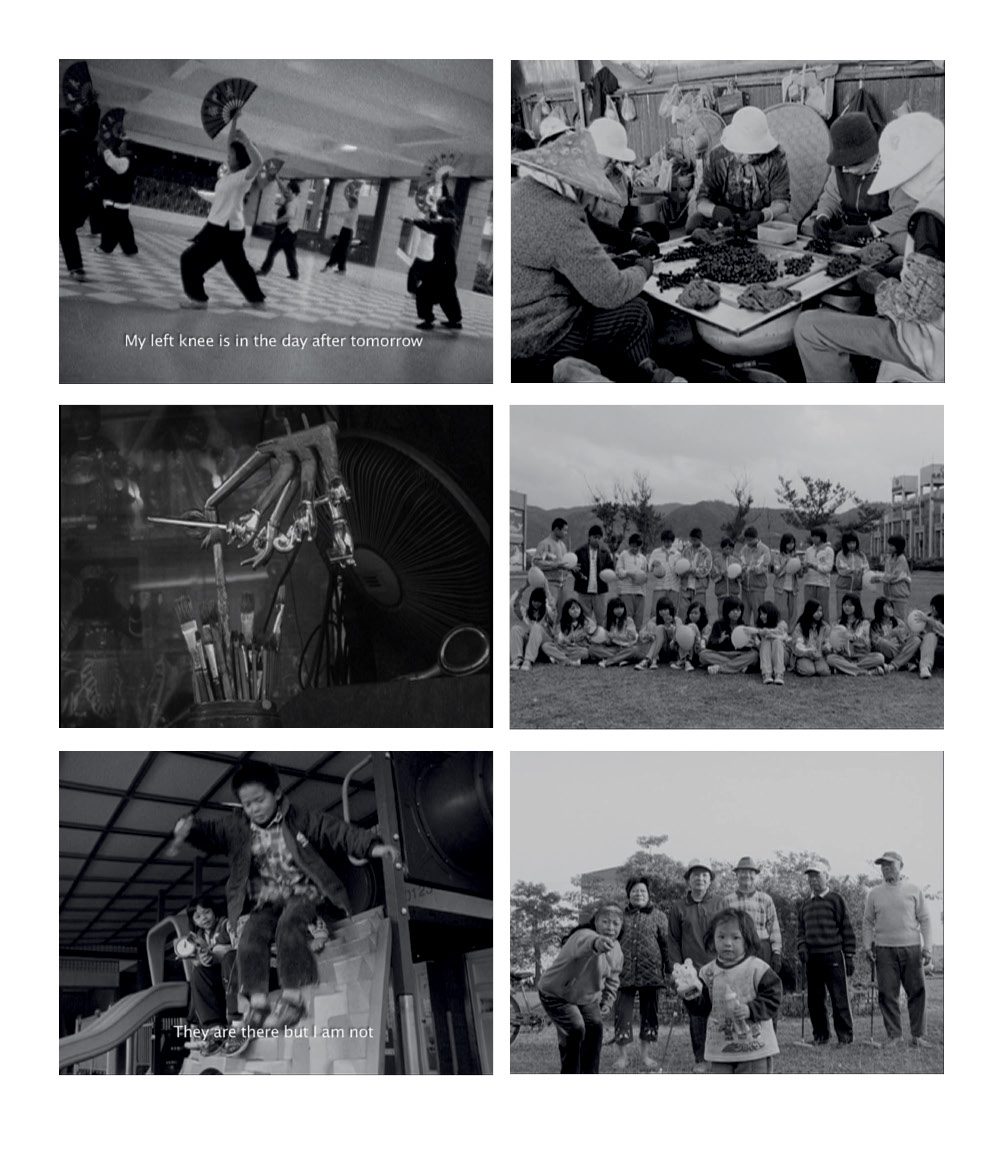
They Are There But I Am Not
Written by Ye Mimi
Translated by Steve Bradbury
A watch is there but time is not
Time is there but people are not
People are there but chickens are not
A parrot is there but God is not
Three o’clock is there but nine o’clock is not
Spring is there but winter is not
A calendar is there but the numerals are not
My right eye is in today
But my left eye is still in yesterday
My left knee is in the day after tomorrow
But my right knee is arriving at the year after next
Was this 500 year-old ocean touched by 500 year-old hands?
Or were these 500 year-old hands touched by the 500-year old ocean?
They break time with their feet
And then pretend they’re out in space
Time isn’t there but it is
They are there but I am not
Time isn’t there but it is
They are there but I am not
Before before is behind
Behind behind is before
As the oldest person turns back
She becomes the youngest
As the youngest person turns back
She becomes the oldest
Time isn’t there but it is
They are there but I am not
Time isn’t there but it is
They are there but I am not
Ye Mimi
They Are There But I Am Not
2009
Ye Mimi (b. 1980, Taiwan) is a poet and filmmaker. A graduate of the MFA Creative Writing Department at National Dong Hwa University, Taiwan and the MFA Film Department at the School of the Art Institute of Chicago, she is the author of three volumes of poetry. Working with both digital and celluloid film, she makes poetry films that improvise new landscapes and scenarios through a collage of words, images, performances and interactions. Her work has been shown at Taiwan Contemporary Culture Lab, Museum of Contemporary Art Taipei, and international film festivals and poetry festivals in New York, Berlin, Rotterdam, Cairo and others. Her books have been translated into English and Dutch.
Ye Mimi makes what she calls poetry films, reflecting how her art practice is rooted equally in text and image. In They are There But I Am Not,2 Ye delivers the lines of the titular poem in an intimate, whispering voiceover, juxtaposed with images primarily shot in Green Island and other places in southwest Taiwan including Chiayi and Liuying. Taiwan’s southern regions, where the country’s oldest city and former capital Tanian are located, are rich with history, folk tradition, and architectural and cultural remnants from Dutch and Japanese colonial rule. Green Island, located off the country’s south-eastern coast, is known in more recent times for being the site of a penal colony and re-education camp for political prisoners during the White Terror, Taiwan’s period of martial law from 1949 to 1987.
These complex histories, however, are not overtly foregrounded in the work, with place and site hinted at instead by the specificity of local produce and religious custom, or scenes set on the island’s coast. A rotating cast of island residents, including students, a tai chi group, a spring roll hawker, longan factory workers, a Buddhist nun, a god, a parrot, and chickens, among other credited players, appear performing their daily employment activities and routines, working with their hands, making meals, or going to the market. Some are also shown interacting with various kinds of timekeeping devices: presenting clocks to each other and occasionally toward the camera, or playing games such as passing around balloons on which clock faces are drawn, then stamping them into shreds.
These gestures and actions suggest various ways of experiencing the passage of time: post-capitalists might define it as gainful labour alternating with permitted moments of leisure, but time is also a thing that has the potential to be relative, contingent and playfully overturned.
Rather than the interminable forward march of historical events, the film posits a broader, more philosophical take on temporality that speculates about the various shapes time can take, ranging from the circular to the fragmented, and the visible to the absent. The poem uses antithesis within each line and across the verses to suggest that divergent elements can complement as well as oppose. The accompanying images add another layer, at times undercutting, and at other times substantiating Ye’s utterances, which further disorder the narrative causality of sound and image. By the end of the poetry film, the pronouns “they” and “I” of the title and the refrain shift in meaning to irreverently negate any universalist claims to knowledge and ideologies of progress.
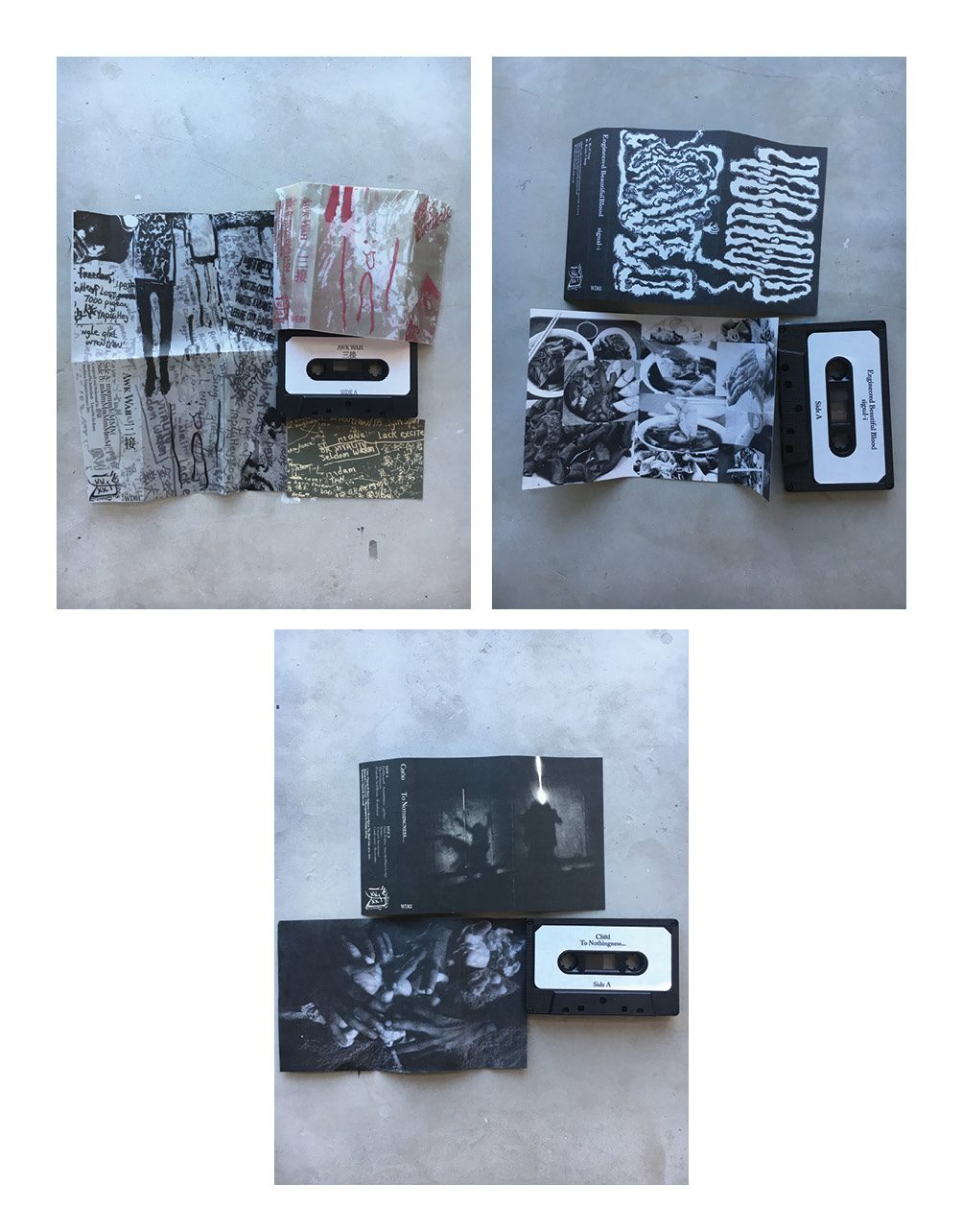
Releases from Low Zu Boon’s Worthless Dispatch cassette label
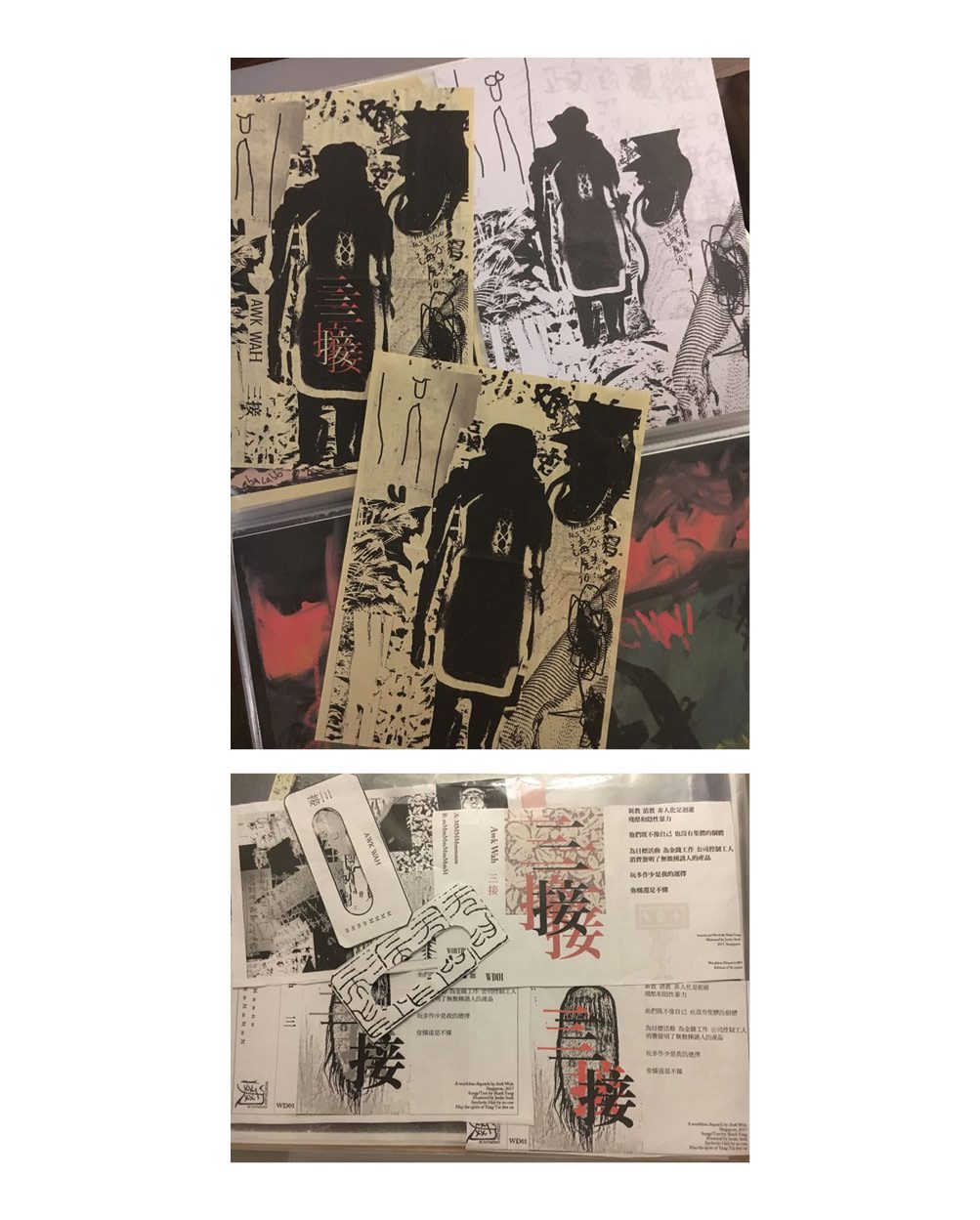
Low Zu Boon/Worthless Dispatch
Design prototype for 01, AWK WAH, 三接, 2018
Low Zu Boon
Worthless Dispatch
Low Zu Boon (b. 1984, Singapore) loves to watch, write and present cinema, and remains severely indebted to the medium’s possibilities. He worked as a film programmer at the National Museum of Singapore Cinematheque (2011-2015) and the Singapore International Film Festival (2015-2018). In 2018, he started Worthless Dispatch, a cassette tape label with a limited run, and is currently working with The Observatory as their company manager.
This conversation arose out of a discussion about making and exhibiting film and music with analogue formats. Photochemical film and magnetic tape are considered relatively stable media, if produced and preserved in the right archival conditions. As with many analogue systems, the primary conservation question is to prevent the degradation of material data, as opposed to the problems of technological obsolescence and compatibility that arise from the use of digital.
The prevalence of photographing on film, shooting on celluloid, and reproducing music on vinyl or magnetic tape has risen and fallen with changes in technology and demand, but the last few years have seen a quiet resurgence of interest in rediscovering these formats. Digital recording technology is associated with technical sophistication, complexity and control, while analogue is associated with warmth, texture and authenticity. However, the reality is that music is more often than not made and disseminated with a combination of analogue and digital techniques. The evolution of these forms and formats reflect the circumstantial peculiarities of the ways that music can be created and consumed.
Low Zu Boon as told to Sam I-shan
(12 April 2019, Singapore)
Underground tape culture began in the late 1970s and early 1980s when musicians would release their music on cassettes through a system of mail order or trade, postal deliveries and magazine advertisements. It’s still operating healthily—and stealthily—in the present, but in combination with different audio media and communication channels. It can be quite surprising that nostalgia isn’t always involved when listening to and working with tape as a medium. I actually got into collecting tapes simply because I didn’t have other ways of accessing music I was interested in, especially certain kinds of experimental or electronic music.
The first cassette I got was by an Italian artist, Maurizio Bianchi, from Mirror Tapes, a Kuala Lumpur-based publisher and distributor of experimental music active between 2010 to 2011. I typically search for hard-to-find music on Discogs, a comprehensive database where you can also buy and sell records. I’ve also been looking for music that I have always heard about but never listened to in person, especially industrial genres that have not been profiled much in compilations of Singapore music. I also happen upon finds: for instance, I recently acquired cassettes from the collection of Philip Cheah, co-founder of BigO magazine, because I was looking for some works by Nunsex, a band with roots in thrash metal, punk and industrial noise. BigO was critical for the development of the independent music scene in the 1980s and 1990s and many musicians and bands sent tapes to them.
I started Worthless Dispatch as a way to work together with some musicians that I admire. One of the reasons why I release on tape is that it is the most inexpensive media to duplicate. Vinyl is costly to produce, and the CD is a format that no longer sells well. The cassette as a form of physical media is affordable but still seen as a collectible by people who want something analogue. Personally, I am indifferent about digital distribution and there is no virtue to giving easy access to materials online. Everything works well on a tape unless one wants a very precise kind of tonal quality, but the kind of music I release and listen to myself doesn’t require that. In fact, the clarity of a CD can be jarring because it is the equivalent of watching something on a LCD screen. The way that music is recorded on a tape is enough for any kind of listening.
I began with Awk Wah3 because I heard a particular performance by him at Melantun Records, a temporary installation and performance space in Far East Plaza organised by Ujikaji for State of Motion 2017. There was no fixed schedule so he just played on and on, mumbling softly in Chinese. It felt different from his usual more abrasive work, and I was curious about this direction, so I asked him if he wanted to work on something, and we ended up with the first release, 三接. It’s a record that has the quality of a sketch, with each side one enunciation. After that was Chöd’s4 To Nothingness, a collaboration between Dharma and Shaun Sankaran based on jam session recordings made between 2011 and 2013. The next release was Engineered Beautiful Blood’s5 signal-i, an older album that Shark Fung and Wei Nan remastered for this release, with the song titles changed. Following these are records from Laek1yo,6 Yuen Chee Wai and Grisha Shakhnes. Laek1yo breaks the mould a bit because it’s probably the most different from the others I’ve done so far. This release, Chicken Rice, is his first official record, as his songs have previously been distributed mostly online as discrete tracks. I’ve played his music on various occasions, but people don’t always enjoy it, perhaps because his approach to spreading political awareness is to piss people off. But I’ll tell you who got into it. I was fined for littering—it was a cigarette butt—and had to do a CWO (Corrective Work Order) at Bukit Merah. There were quite a few of us so we were divided into groups and assigned a supervisor who would tell us where to go and sweep. I played Laek1yo for the other people in my group and it was a hit.
The process of making a record is quite flexible. The musicians know the format, and have a sense of what the length and rhythm is, as long as what they make runs between half an hour to one hour. Even the duration of the A side and the B side is not always fixed, as long as we are able to separate the songs so that the two halves are about even. Once I get the tracks, we master for cassette. I work with an analogue media company based in Canada that is one of the more prominent players in tape production. The interesting thing is that I never get the exact number of tapes I order because they will record until all the tape on the reel is used, so the final quantity hovers around what I request. I’ll keep two for archival purposes, and the rest are sold, or more often, not.
The cassette covers I design myself and print at home. For Awk Wah’s 三接, the image references are from my photographs, including graffiti I documented in a very smelly Queen Street kopitiam toilet, the old Yangtze cinema and Golden Mile Complex. I’ve actually started drawing and painting again because of the cover art I have to do for the cassettes.
I choose what to release based on serendipity, or shared interests, especially when the attitude and outlook that informs our mutual intentions is mostly in sync. I’m planning a total of ten releases, and am about halfway at the moment. The artists I work with have an element of the obscure, and may cross different genres, but what they have in common is that there is something “off” about each one of them. The kind of music I like is like the kind of films I enjoy, I look for new feelings, new-found expressions, things that get my hair standing.
My approach and the artists’ philosophies are reflected in the label’s name. It doesn’t state any aspirations or gesture toward impossibly evolving projections of growth, which we all know is the abstract cause of our failings as a society. Neither does it pander toward some kind of stance against the economy of public taste. In the end, there is not much interest in, or value placed on these releases, and there is nothing in return other than whatever personal joy it brings you. Perhaps expecting anything more than the release itself is just fantasy, but that’s OK.
Images page 134-135 courtesy of the artist
Footnotes
1 https://www.youtube.com/ watch?v=b6qKWbJSBqw&feature= youtu.be
2 https://vimeo.com/7695648
3 https://worthlessdispatch.bigcartel.com/product/awk-wah-wd-01
4 https://worthlessdispatch.bigcartel.com/product/chod-to-nothingess-wd-02
5 https://worthlessdispatch.bigcartel.com/product/engineered-beautiful-blood-signal-i-wd-03
6 https://worthlessdispatch.bigcartel.com/product/laek1o-chicken-rice-wd888
Contributors’ Bios
Contributors’ Bios
Jorella Andrews (England, UK) is a senior lecturer in visual cultures at Goldsmiths, University of London. Having trained as a fine artist and as an art theorist, her academic work focusses on the relations between philosophical inquiry, the image-world, and art practice, with a particular emphasis on phenomenology (notably the work of Maurice Merleau-Ponty). She is the author of The Question of Painting: Rethinking Thought with Merleau-Ponty; and Showing Off! A Philosophy of Image. She also edits the Visual Cultures As… book series published by Sternberg Press.
Dejan Grba (b. 1967, Serbia) is a media artist, author and educator. He has exhibited, curated and lectured at venues including ADM/NTU Singapore, ISEA in Manizales, Columbia University and Hong Kong, SIVA Shanghai, Syracuse University, ZKM Karlsruhe, IFA Berlin, GfZK Leipzig, Montevideo Amsterdam, MiP Vienna, CCN and <rotor> Graz, MoCA Novi Sad, MoCA and MST Belgrade. He is currently a visiting associate professor at the School of Art Design and Media, Nanyang Technological University, Singapore. He is a founding chair of the New Media Department at the Faculty of Fine Arts in Belgrade where he teaches Transmedia Research. He teaches Poetics of Digital Art at the Digital Art doctoral program at the University of the Arts in Belgrade. http://dejangrba.org
Michaela Melián (b. 1956, Munich, Germany) lives and works in Upper Bavaria, Germany, and Hamburg. Melián studied music at the Richard Strauss Conservatory in Munich and art at the Academy of Fine Arts, Munich. She is a member of the Band FSK, which was founded in 1980, and is one of John Peel’s favourite bands. Melián is a professor at the Hochschule für bildende Künste in Hamburg, Germany, where Melián focusses on time-related media. Melián is represented by Galerie Barbara Gross, Munich. She has participated in numerous exhibitions in galleries and museums in Germany and all over Europe, and is the recipient of numerous awards, most recently the Roland-Preis for Art in the Public Sphere, Bremen, 2018 and the Edwin-Scharff-Preis of the City of Hamburg, 2018.
Melián’s selected publications include Music from a Frontier Town, LP (Martin Hossbach, Berlin 2018); Electric Ladyland, CD/LP (Munich 2016); Monaco, CD/LP (Monika Enterprise, Berlin 2013); Iemanjá with Thomas Meinecke (Spector Books, Leipzig, 2013); House of Jacquard (Städtische Galerie Nordhorn, 2012); Rückspiegel (Spector Books, Leipzig, 2009/2010); Speicher (Koenig Books, London, 2008); Föhrenwald (Revolver, Frankfurt/Main, 2005); Triangel (Lukas & Sternberg, Berlin/New York, 2003); Los Angeles, CD/LP (Monika Enterprise, Berlin 2007); Föhrenwald, CD (intermedium records, München 2006); and Baden-Baden, CD/Double-LP (Monika Enterprise, Berlin 2004).
Charles Merewether (Edinburgh) received his BA in literature and PhD in art history at the University of Sydney. He taught at University of Sydney from 1981-84; Universidad Ibero-Americana, Mexico City between 1986-88; and Universidad Autonoma de Barcelona. He received a research fellowship from Yale University in 1991; was the Inaugural Curator for the Museo de Arte Contemporaneo de Monterrey, Mexico between 1991-1994; curator at the Research Institute, Getty Centre in Los Angeles between 1994-2003. He taught at the University of Southern California; was the artistic director of the Sydney Biennale between 2004-2006; deputy director of the Cultural District, Saadiyat Island, Abu Dhabi in 2007; director of the Institute of Contemporary Arts, Singapore between 2010-2013; visiting professor at Nanyang Technological University, Singapore in 2014; taught at Baptist University, Hong Kong in 2015; was the curator of contemporary art at the National Art Museum, Tbilisi, Georgia between 2016-2018. His books include State of Play (2017); After Memory: The Art of Milenko Prvački—40 years (2013); and Under Construction: Ai Weiwei (2008). He was co-editor of After the Event (2010), editor of Art, Anti-Art, Non-Art: Experimentations in the Public Sphere in Postwar Japan 1950-1970 (2007); and The Archive (2006). He is currently working on two books: Contemporary East European Art; and on the modern history of cultural looting, which will be published by Reaktion Books.
Nils Plath (b. 1970, Westphalia, Germany) writes and lives in Berlin. Plath works and teaches as an assistant professor in the Department for Comparative Literature, University of Erfurt, Germany. He has written numerous publications on time and temporalities in reading, translation and teaching, reading and communities, documentary and realism, writing and scripture, pop and contemporary culture, landscapes in literature, the visual arts and film. Plath‘s most current book publication is Hier und anderswo. Zum Stellenlesen bei Franz Kafka, Samuel Beckett, Theodor W. Adorno und Jacques Derrida (Kadmos Kulturverlag Berlin, 2017).
Sam I-shan (Singapore) is a curator at National Gallery Singapore, working on modern and contemporary art in Singapore with an interest in time-based media, and art and politics. She was previously curator at Singapore Art Museum and Esplanade Visual Arts, focussing on the moving image and photography from Southeast Asia and wider Asia. At Esplanade, she curated and managed new commissions and site-specific exhibitions with emerging and familiar artists from the region. She also headed film and moving image initiatives at SAM including Artist Films, while co-programming the Southeast Asian Film Festival.
Clare Veal (b. 1986, Cardiff, Wales) is an art historian and curator who undertakes research on Southeast Asian photography, art and visual culture, with a particular focus on Thailand. She received her PhD from the Department of Art History and Film Studies at the University of Sydney. For her thesis, she wrote Thainess Framed: Photography and Thai Identity, 1946–2010. She has research and teaching experience from institutions in Australia, Thailand and Singapore. From 2015 to 2016, she was a participating scholar in the Power Institute’s Ambitious Alignments: New Histories of Southeast Asian Art research programme. She is the editor for the Asian Art section of the Routledge Encyclopaedia of Modernism (2016) and has contributed papers to a number of edited volumes, journals and exhibition catalogues. In addition to working as a consultant for a survey of the Chang Tang collection in Bangkok, Clare has co-curated exhibitions including Storytellers of the Town: Works by Araya Rasdjarmrearnsook (2014); and Retold-Untold Stories: Phaptawan Suwannakudt (2016).
Ian Woo (Singapore) is an artist influenced by forms of modernism, perceptual abstraction and the sound structures of music improvisation. Woo’s work is in the collection of major institutions such as ABN AMRO, Facebook, Singapore Art Museum, The Istana Singapore, National Gallery Singapore, Suzhou Centre, UBS, and the Mint Museum of Craft & Design, USA. His paintings are featured in the publication Art Cities of the Future: 21st Century Avant-Gardes, a publication by Phaidon in 2013. Since 2016, he has been part of Impermanent Durations– On Painting and Time, a painting collaborative involving Beth Harland, David Thomas and Laura Lisbon.
Andrea Luka Zimmerman (b.1969, Germany) is an artist, filmmaker, writer and cultural activist. Andrea’s work is concerned with marginalisation, social justice and structural violence. She has been nominated for the Grierson and Jarman awards. Her films include Here For Life (2019); Erase and Forget (2017), which had its world premiere at the Berlin Film Festival and was nominated for the Original Documentary Award; Estate, a Reverie (2015); and Taskafa, Stories of the Street (2013), written and voiced by the late John Berger. Her selected exhibitions include Civil Rites at the London Open in Whitechapel Gallery and Common Ground in Spike Island, Bristol. She co-founded the cultural collectives Fugitive Images and Vision Machine (with collaborators who were featured on Academy Award® nominated feature documentary The Look of Silence).
Milenko Prvački (former Yugoslavia/Singapore) graduated with an MFA in Painting from the Institutul de Arte Plastice "Nicolae Grigorescu” in Bucharest, Romania. He is one of Singapore’s foremost artists and art educators, having taught at LASALLE College of the Arts since 1994. He was Dean of the Faculty of Fine Arts for 10 years, and is currently Senior Fellow, Office of the President at LASALLE. He also founded Tropical Lab, an annual international art camp for graduate students. He has exhibited extensively in Europe, USA, and Singapore; among the major exhibitions, was most notably the Biennale of Sydney in 2006. He participated in numerous symposiums and art workshops worldwide, and acted as a visiting professor at Musashino Art University in Japan, Sabanci University in Turkey and University of Washington School of Art + Art History + Design, USA. He is Adjunct Professor at RMIT University, Melbourne, Australia. He was awarded the Chevalier de l’Ordre des Arts et des Lettres by the French government in 2011 and Singapore’s Cultural Medallion for Visual Arts in 2012.
Venka Purushothaman (Singapore) is an art writer, academic, and arts and cultural manager. He is currently Provost at LASALLE College of the Arts, Singapore.
Susie Wong (Singapore) is an art writer, curator and artist. She has contributed to several publications in Singapore. She was a regular art reviewer and art feature writer for the arts in Singapore: in the 1990s for The Straits Times, Life! Singapore; The Arts Magazine (The Esplanade); in the 1990s to 2010s, for ID (Singapore); and d+a (Singapore) on art, architecture and design. She had written several artists’ monographs and has contributed essays in publications such as Southeast Asia Today (Roeder, 1995); Liu Kang: Colourful Modernist (The National Art Gallery Singapore, 2011); and Histories, Practices, Interventions (Institute of Contemporary Arts Singapore, 2016).
